Insects are considered animals because they reproduce sexually, breathe oxygen, consume organic material, and are able to move. They have six legs, an exoskeleton, and a body with three segments, head, thorax, and abdomen. Most insects have wings. We have been identifying the insects at Vista Farm since 2005.
Bees

American Bumble Bee, Bombus pensylvanicus, is a threatened species of bumblebee native to North America. It lives and nests in open farmland and fields feeding on several food plants, but favoring sunflowers and clovers. While bees normally forage close to their nests, individuals can return from up to 1.5 miles away. Bombus pensylvanicus generally nests in fields of long grass, but may sometimes nest underground. The species utilizes bundles of hay or long grass to create sheltered nests above ground. Some nest in established crevices and burrows, such as old bird nests, rodent burrows, or in cinder blocks. Assassin bugs and dragonflies are common predators of the bee. A queen is here.
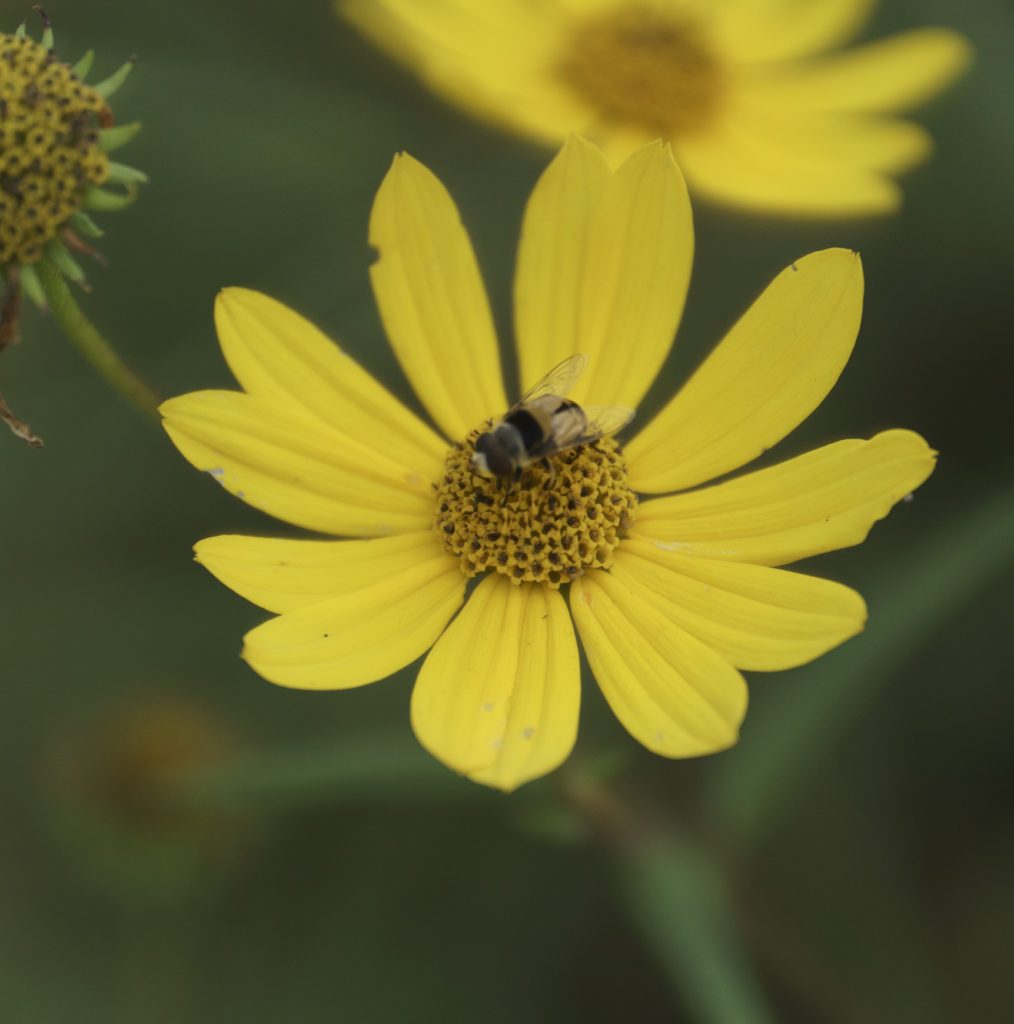
Bicolored Plushback fly, Palpada pusilla

Northern Plushback fly, Palpada vinetorum
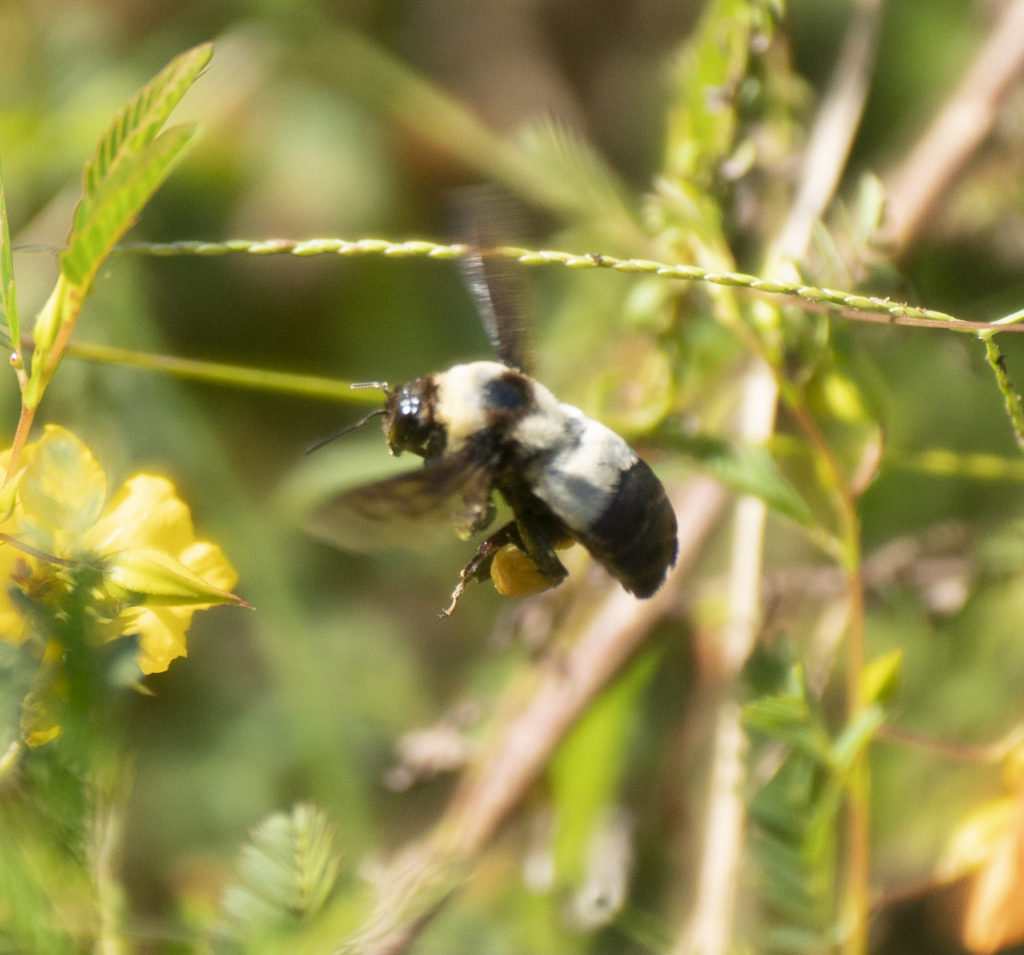
Southern Plains Bumble Bee, Bombus fraternus, in a patch of Partridge Peas in the meadow at Vista Farm.
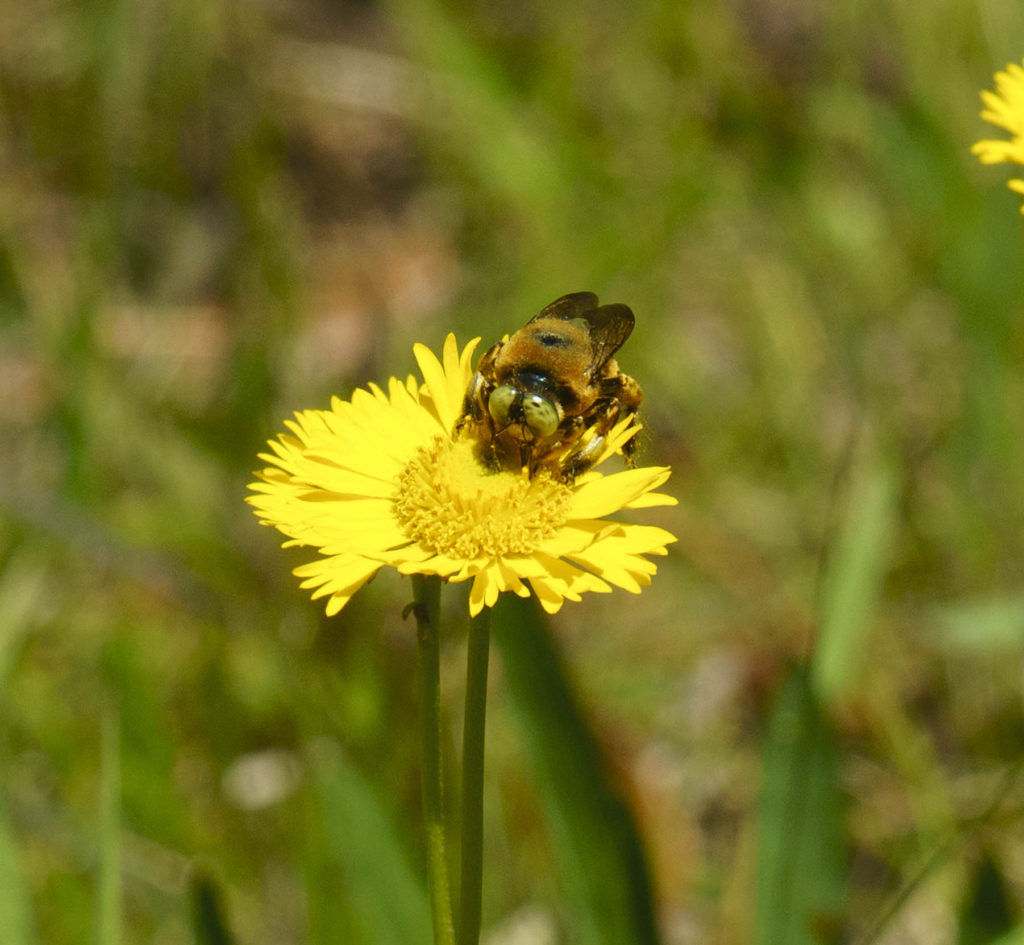
Southern Carpenter Bee, Xylocopa micans, excavate nests in woody plant material. It is a large, solitary bee that does not live in colonies. In the nest, each brood cell is provisioned with a ball composed of pollen and regurgitated nectar. On top of the food ball, the female will lay an egg, and then plug up the respective brood cell with wood pulp. After filling each of the brood cells, the female dies. Bees develop from egg to adult in seven weeks. New adults break out of the brood cell partitions several weeks after reaching adulthood, generally in late August, to collect pollen to store for overwintering. Source: Wikipedia
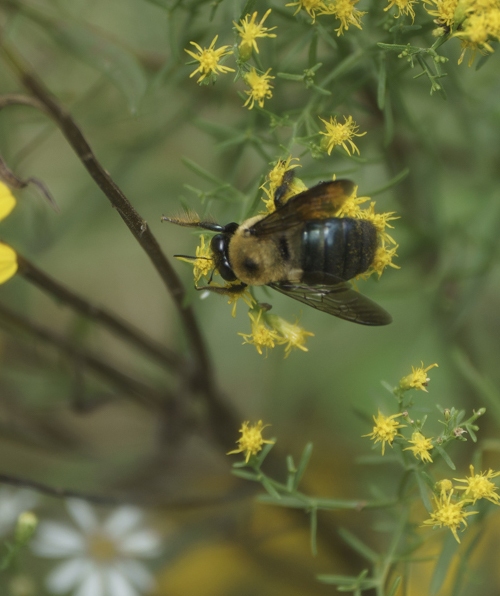
Eastern Carpenter Bee, Xylocopa virginica, at work pollinating Golden Rod in the meadow at Vista Farm.
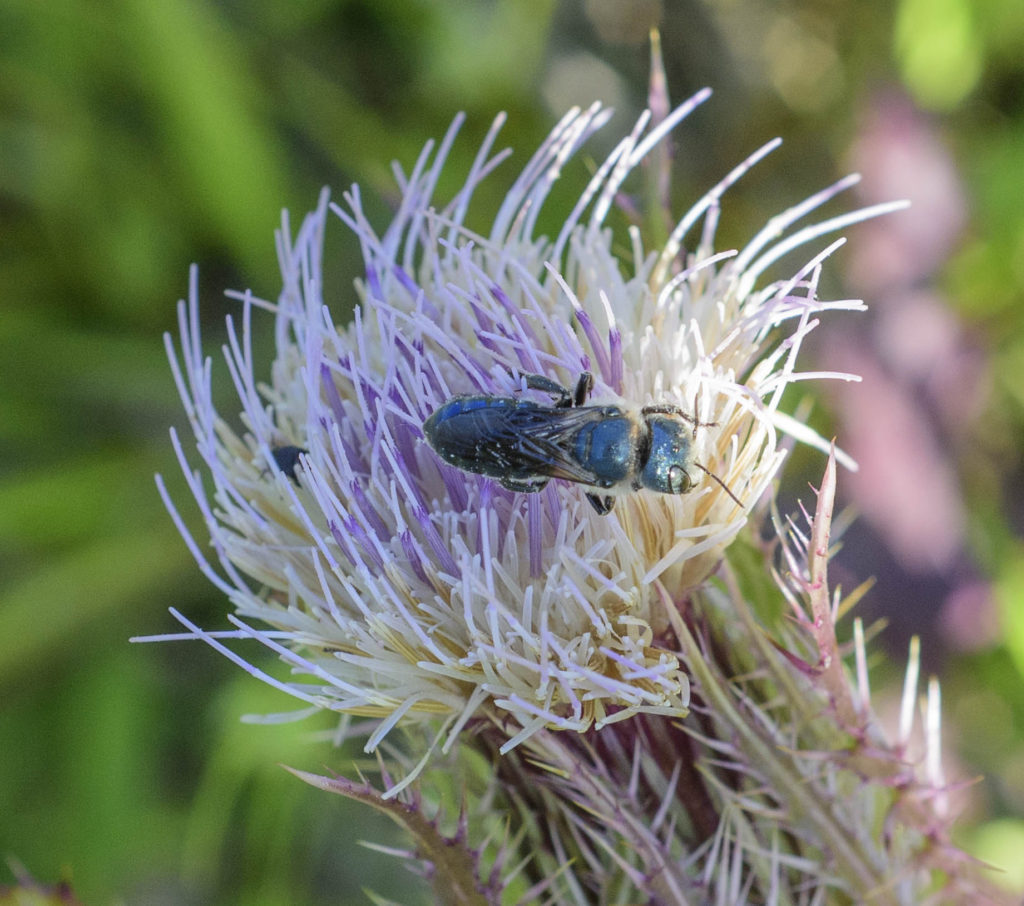
Steel Blue Mason Bee, Osmia chalybea, on a Thistle. A member of Mason, Leafcutter, Carder, and Resin Bees. Family Megachilidae
Wasps and Galls
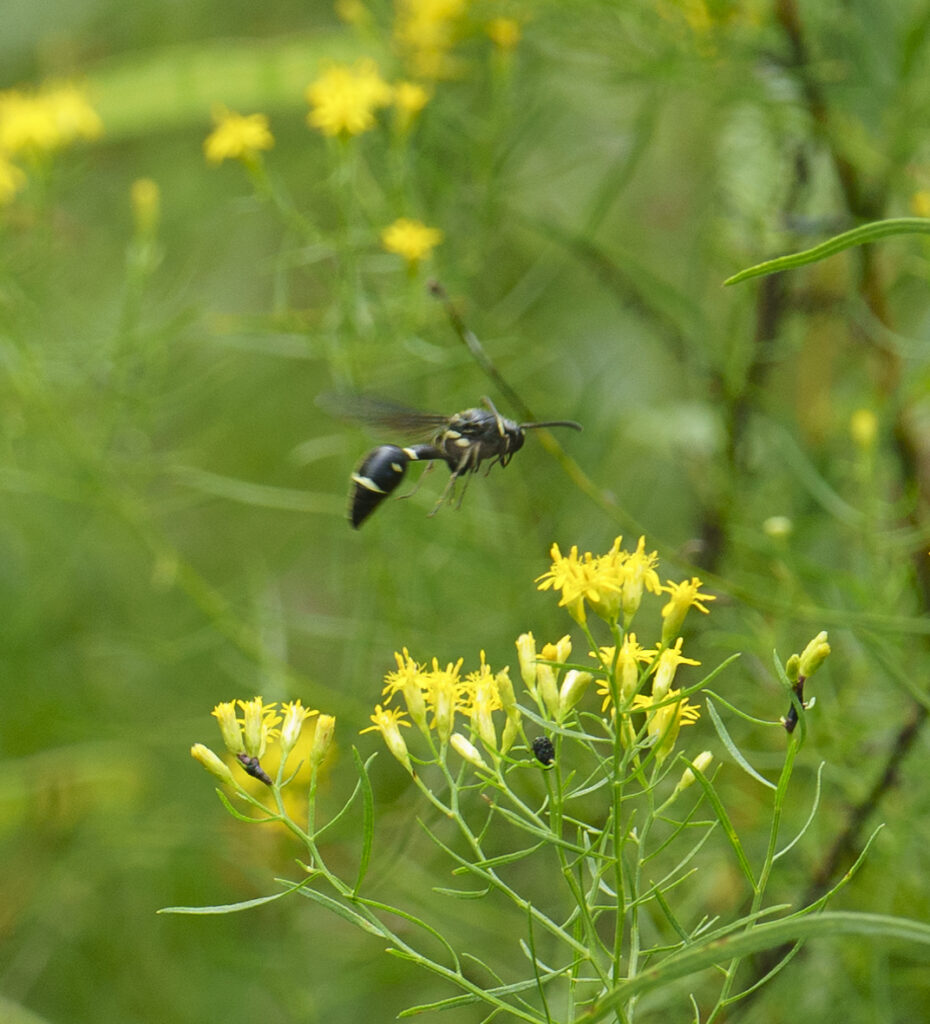
Fraternal Potter Wasp, Eumenes fraternus, builds a pitcher-shaped nest of mud by collecting a drop of water and then a dry particle of soil, dampening the soil and putting it in place. When it is ready, the wasp lays an egg inside the pot, suspending it on a fine thread. She then searches for suitable food to put inside the pot on which her developing larva may feed. Usually this is the larva of a butterfly or moth that has been stung to paralyze it and which will remain alive and fresh until the developing wasp larva needs it. When enough provisions are in the pot, she seals the top with damp soil and goes off to build another nest. Adults feed mainly on nectar.
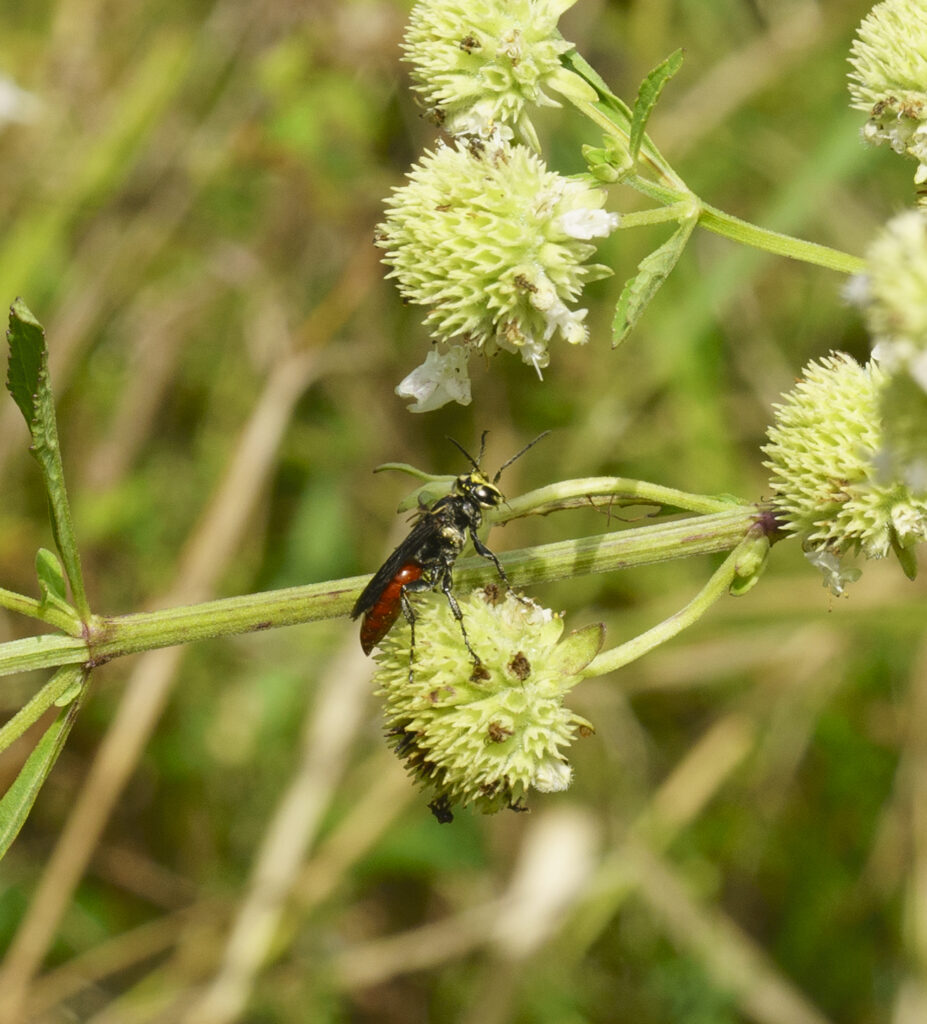
Larra bicolor a member of Square-headed Wasps, Sand Wasps, and Allies Family Crabronidae, is a parasitoid wasp native to South America which was introduced into Florida as a biological pest control of invasive mole crickets.
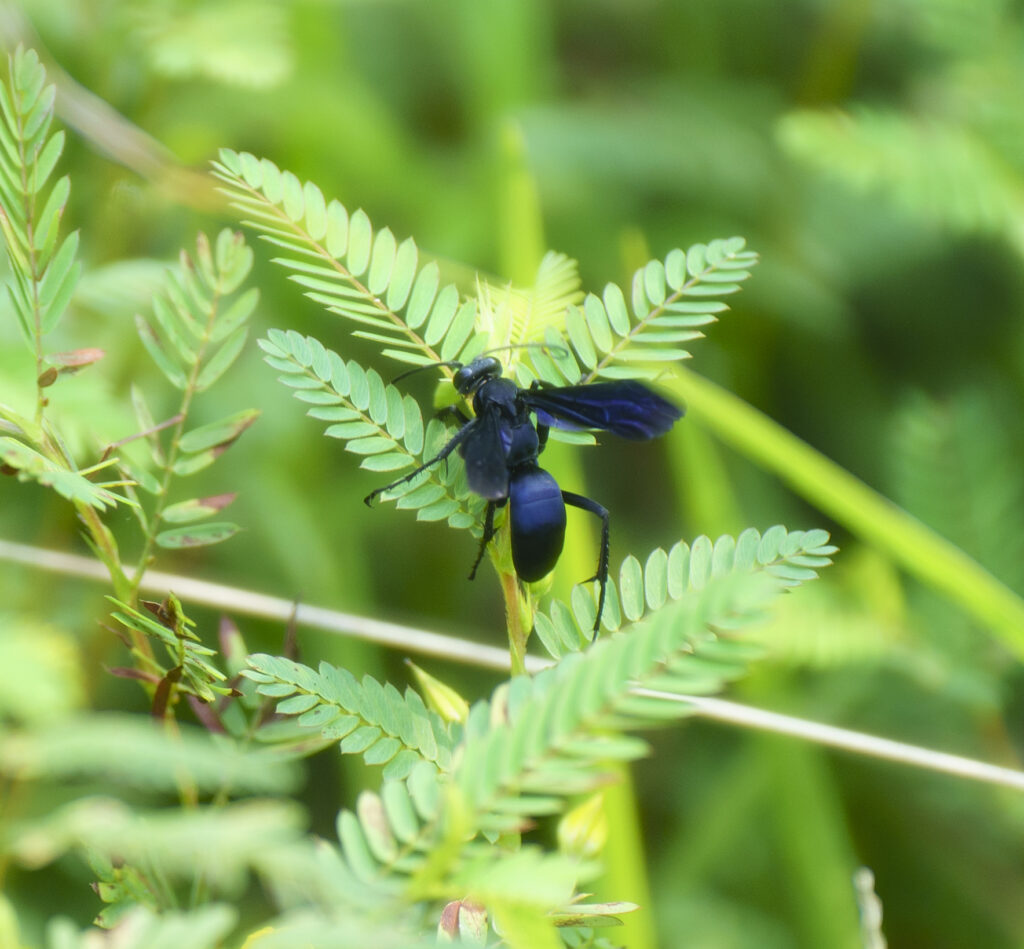
Great Black Digger Wasp, Sphex pensylvanicus, females are solitary and build their nests in the ground. The adults are great pollinators while hunting for prey for their young. An adult will paralyze and carry their prey back to the nest for their brood. Prey consists of many insects such as crickets, katydids, and grasshoppers.
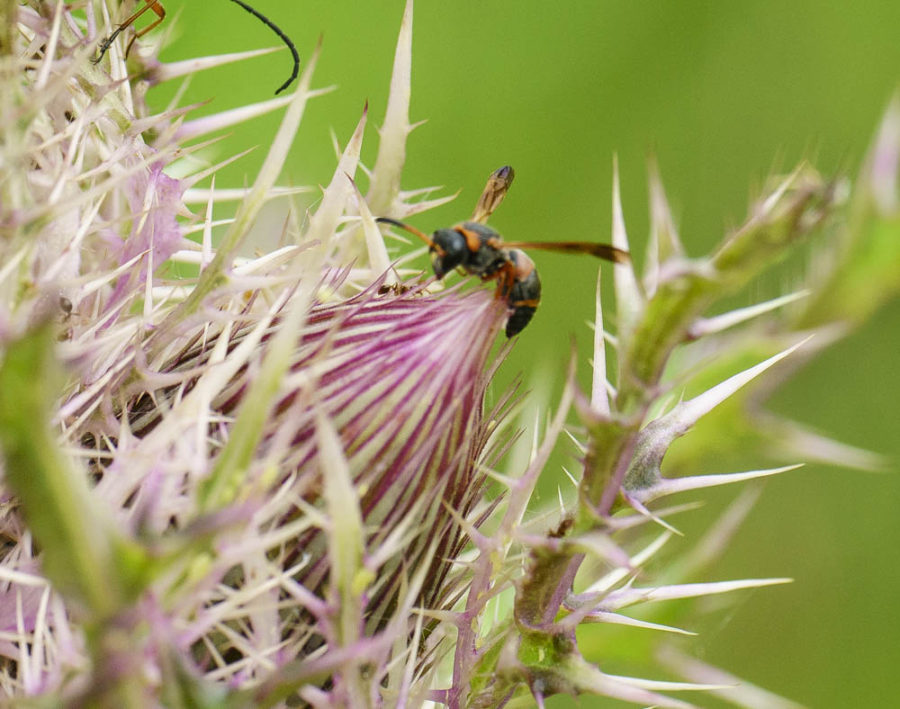
Red-marked Pachodynerus Wasp, Pachodynerus erynnis, also called the Red and Black Mason Wasp, is a species of stinging wasp in the family Vespidae. Here it is feeding on a Bristle Thistle alongside an ant in the meadow at Vista Farm.
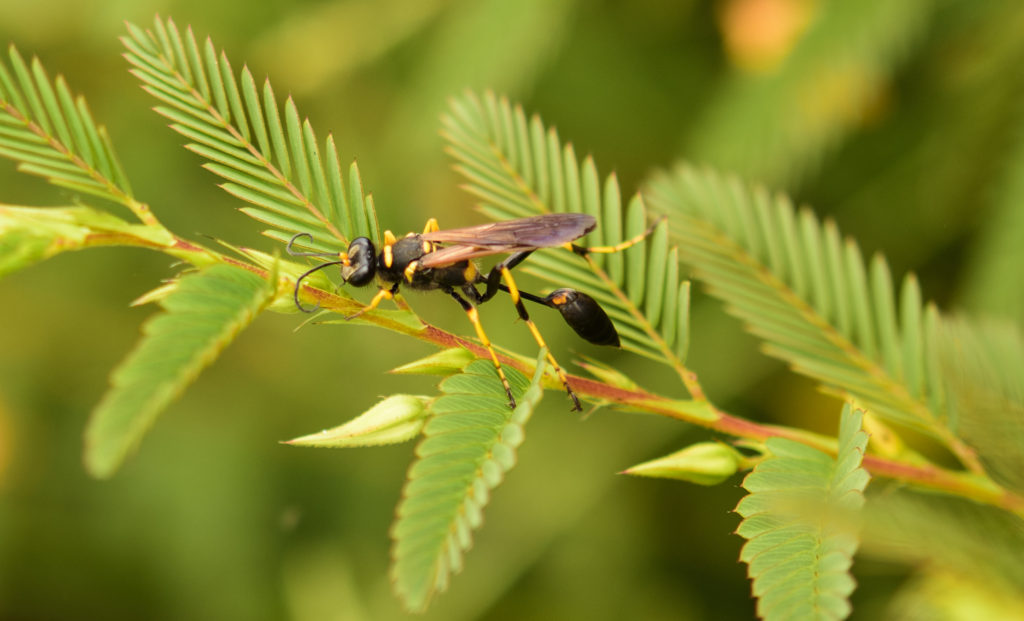
Yellow-legged Mud-dauber Wasp,
Sceliphron caementarium, on a stem of Partridge Pea in the moist meadow at Vista Farm.
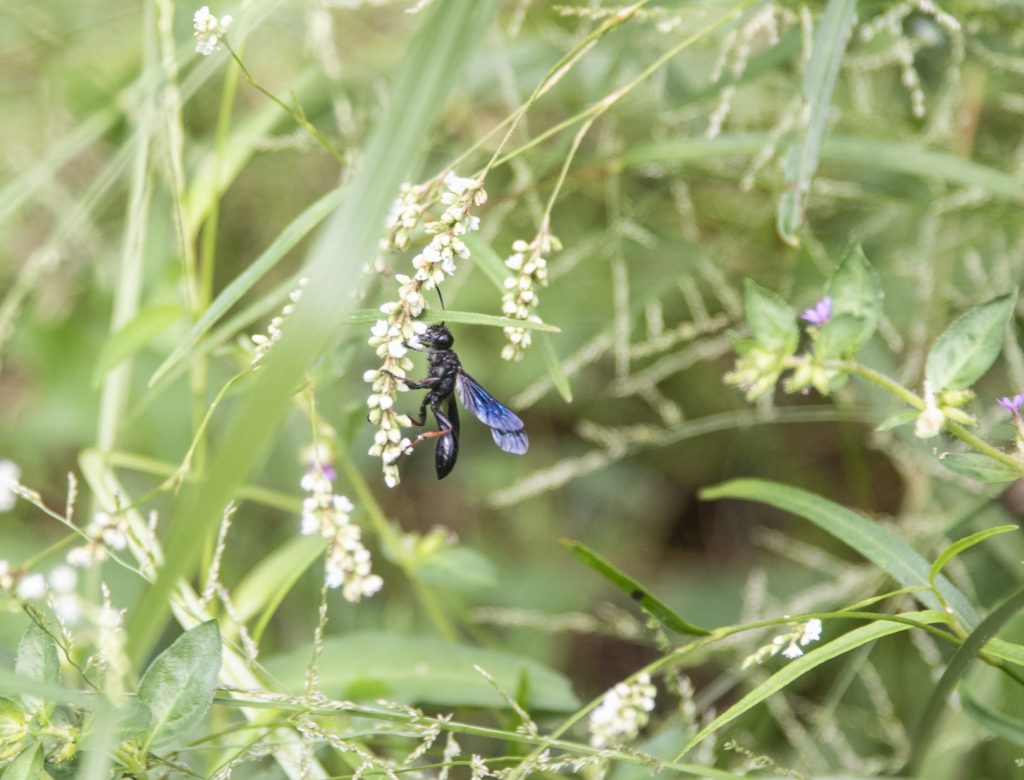
Isodontia auripes, the Brown-legged Grass-carrier, often builds a cocoon of dried grass and was seen in the meadow actually carrying grass.
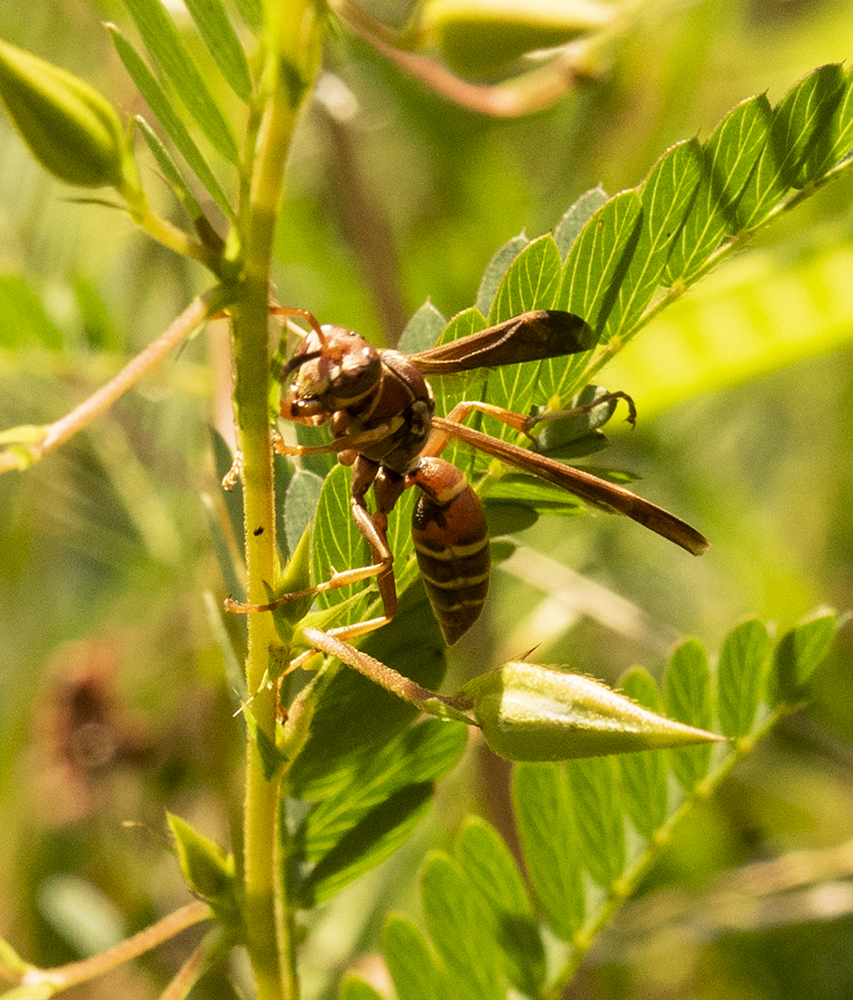
Paper Wasp, Polistes dorsalis, on a Sesbania stem in the sunny meadow at Vista Farm. A nest is here.
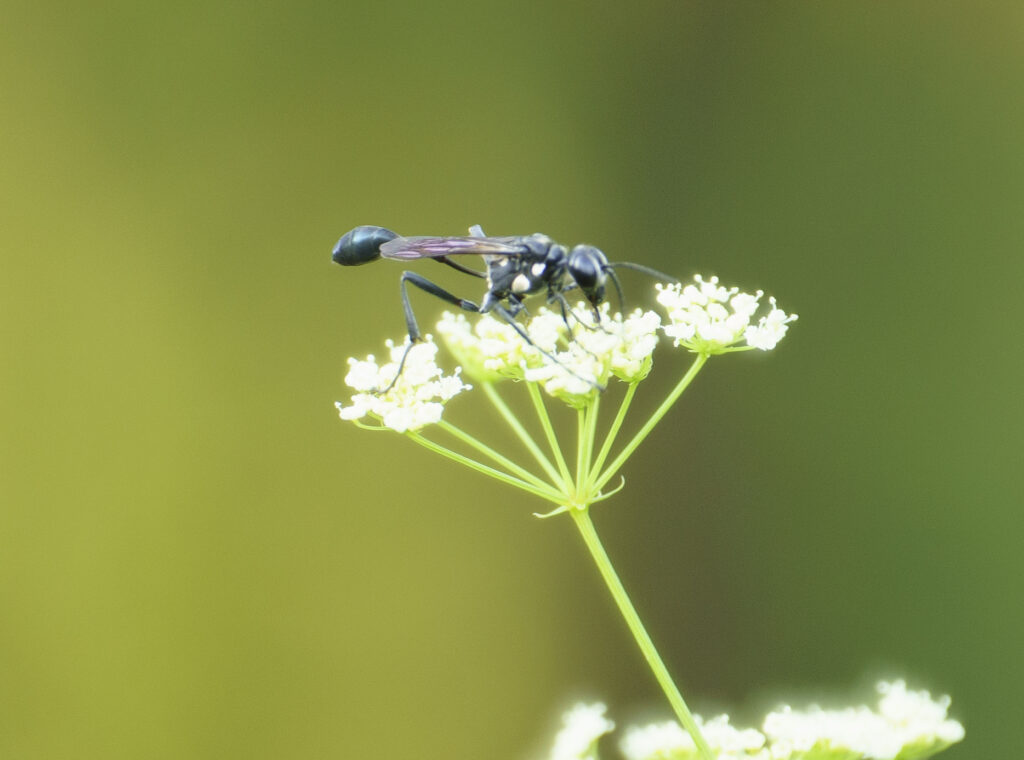
Gold-marked Thread-waisted Wasp,
Eremnophila aureonotata
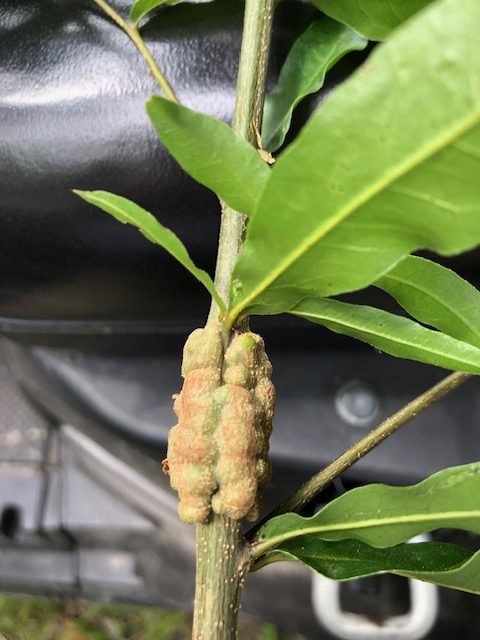
An unknown gall, not on an oak.

Persimmon Leaf Blister Gall, by gall former Aceria theospyri, a very tiny mite.
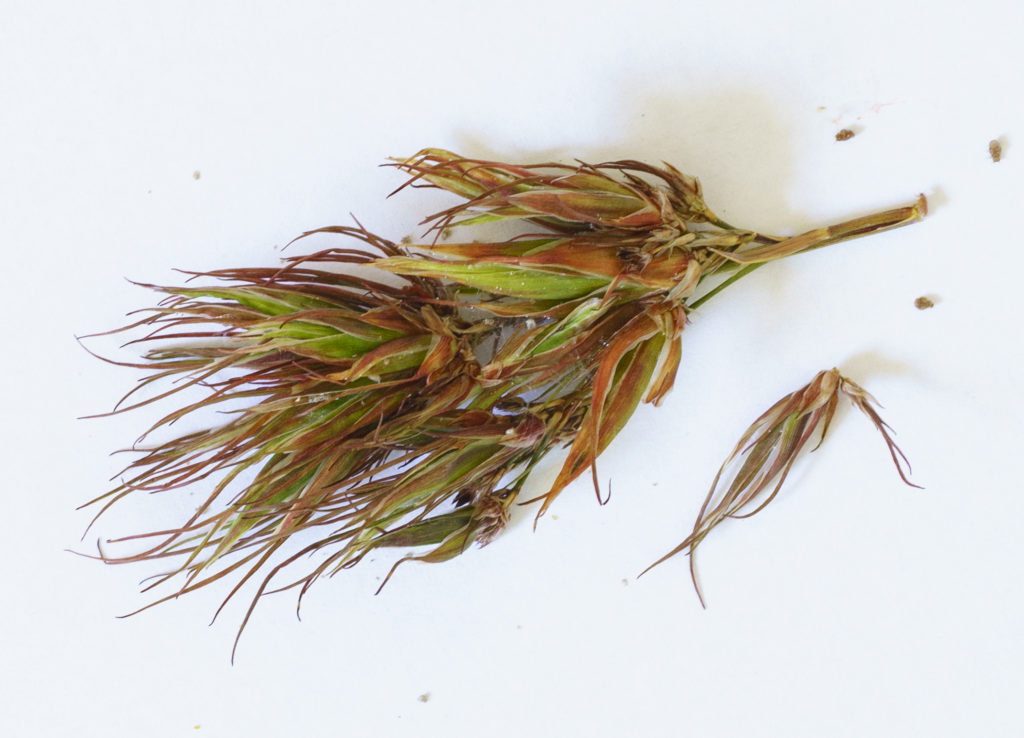
Livia maculipennis, a member of Psylloids family of gall formers, are very tiny insects that attack Juncus elliotti causing the plant to form this large spikey, flower-like gall. The larvae develop inside the gall.
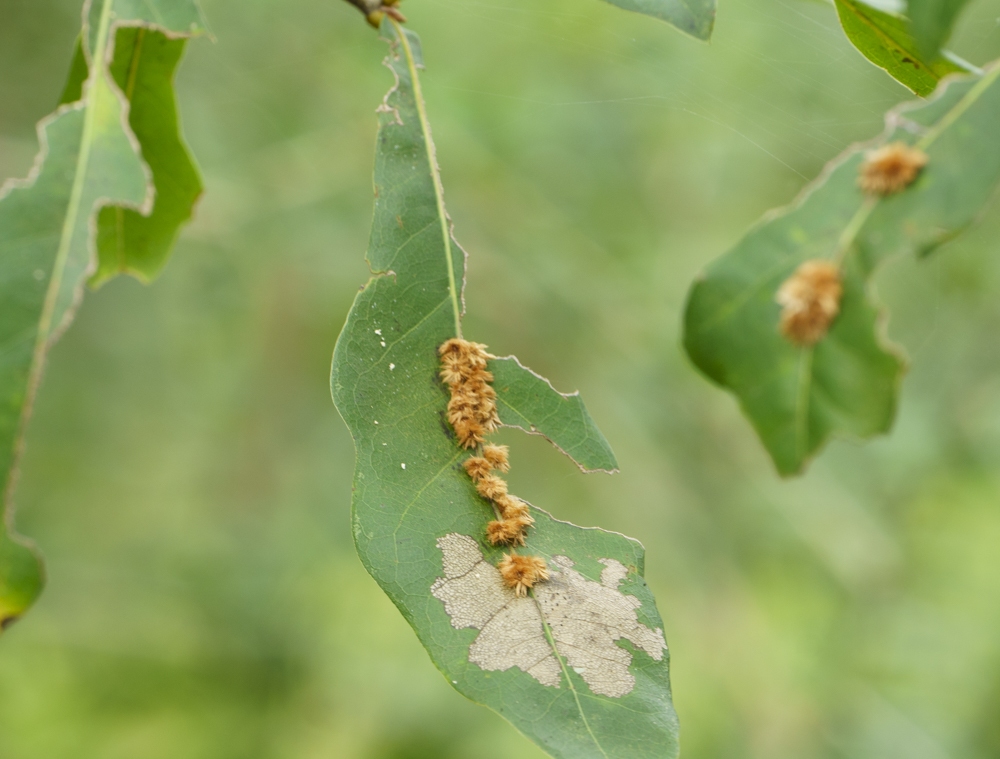
Furry Oak Leaf Gall Wasp, Callirhytis furva, Texas to Minnasota and all parts east probably exclusive to oaks in the Red Oak family. Furry growth along the midrib or a major vein.
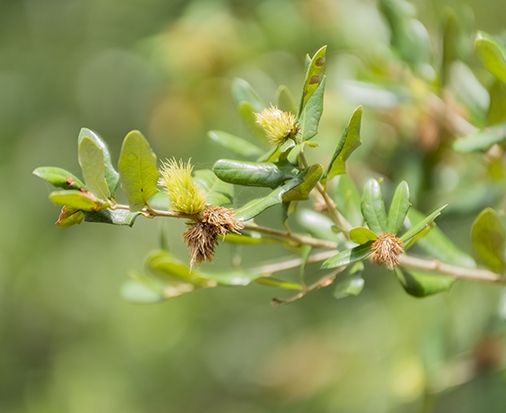
Leafy Oak Gall Wasp, Andricus quercusfoliatus, forms this peculiar gall exclusively on live oaks. The tiny wasp lays an egg in the bark and the tree forms the gall around it. The larva develops and emerges some months later.

A live oak stem gall, Callirhytis quercusbatatoides, which attacks live oaks across the gulf coast. Cross-section here showing the larva inside the gall formed on live oak stems by Callirhytis quercusbatatoides wasp.
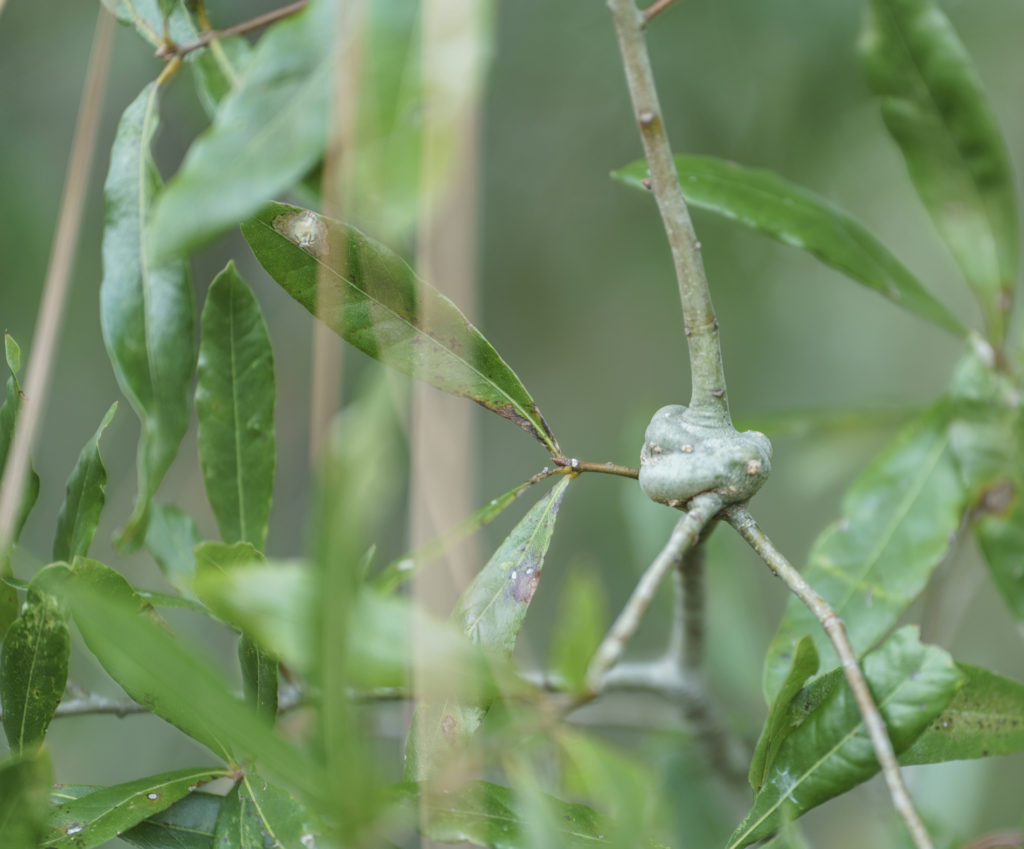
Horned Oak Gall Wasp, Callirhytis quercuscornigera, (probably) gall formed on the intersection of Laural Oak stems.
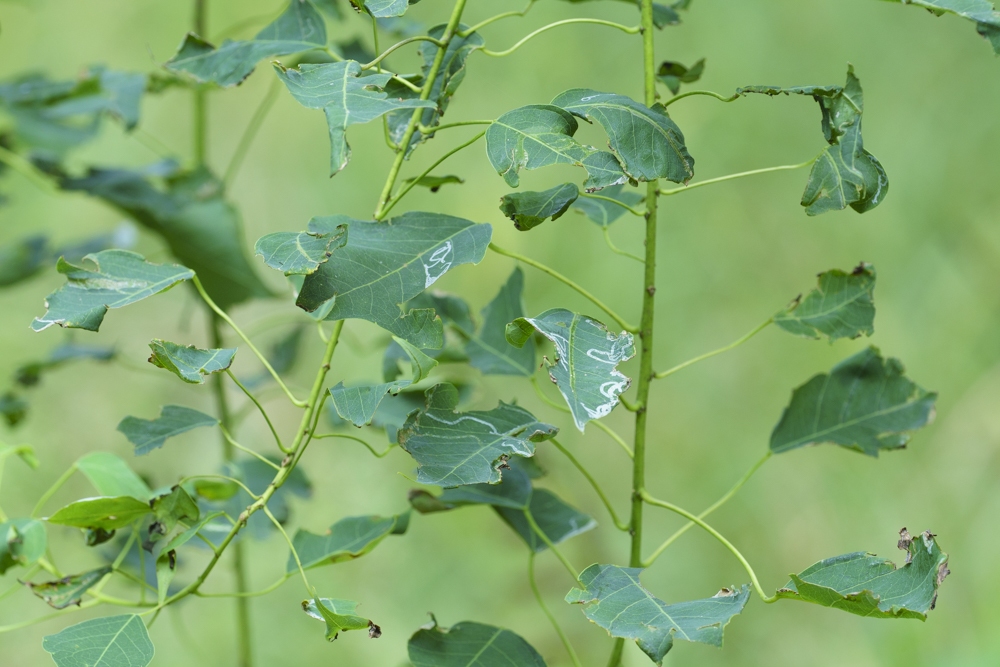
Chinese Tallow Tree Leaf Miner, Caloptilia triadicae, is an inconspicuous brown moth discovered in the south around 2013 and probably introduced accidentally. Very tiny caterpillars feed on layers between the top and underside of the leaves of the Tallow Tree primarily at night. At maturity they take a portion of a leaf and roll it into a secure cocoon where they morph into a moth.
Moths, Butterflies, Skippers and Damselflies
Moths, skippers and butterflies are all in the Order Lepidoptera, within which there are over 180,000 different species of both moths and butterflies. Butterflies tend to fold their wings vertically over their backs. They hold their wings in a flat triangle over their back that hides the abdomen. Butterflies are usually larger and have more colorful patterns on their wings. Moths are typically smaller with drab-colored wings. Butterflies usually have long, smooth antennae that are rounded on the ends, while most moths have thick, feathery antennae. Even though moths and butterflies belong to the same insect Order, they are not the same kinds of insects. Skippers are also in the order Lepidoptera, but are in the family Hesperiidæ making them neither moths nor butterflies. They hold the hind wing flat and the forewing erect along with a somewhat club-like antennae that tapers to a hook. Skippers dart about quickly in an erratic fashion. Damselflies are thin and close their wings when resting.
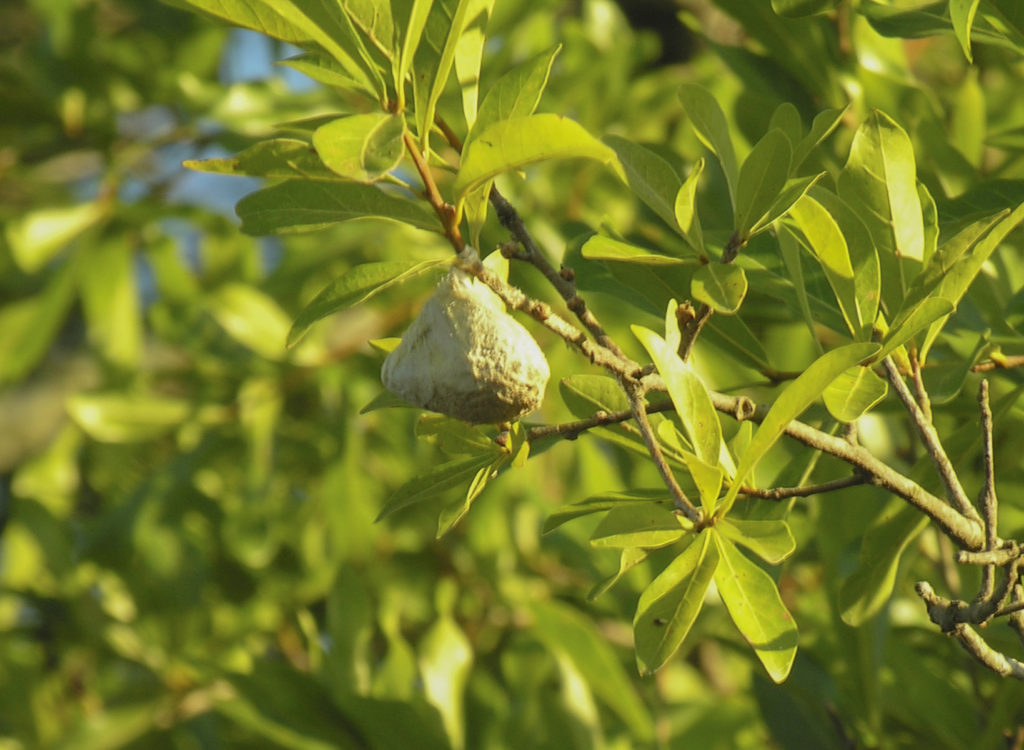
An olive greenish brown cocoon, probably that of Telea polyphemus moth, hanging in an oak tree over the pond. The caterpillar is bright green and the large moth is tan colored with spots on its wings that look like eyes.
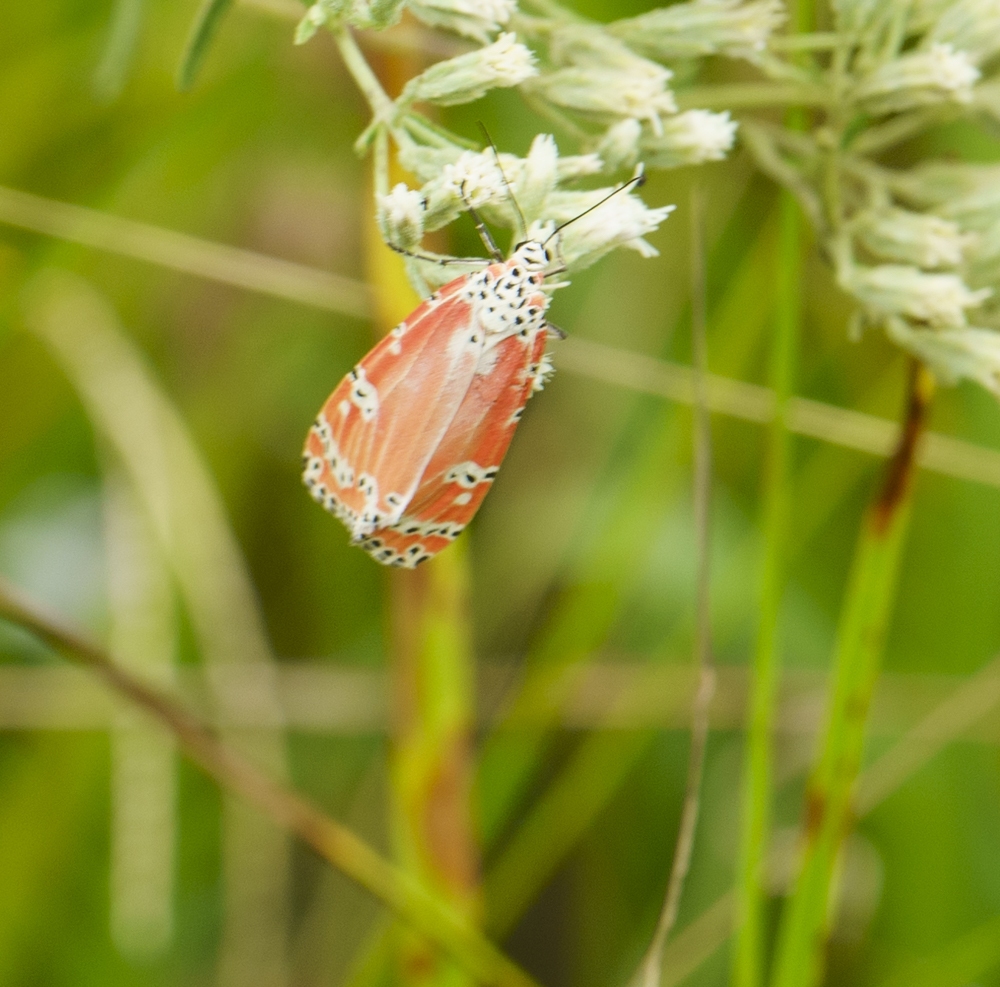
Ornate Bella Moth, Utetheisa ornatrix, is a beautiful little pinkish moth common mostly along the coastal regions from Nova Scotia to Latin America and the Caribbean. Color can vary from pink to yellow, orange and reddish.
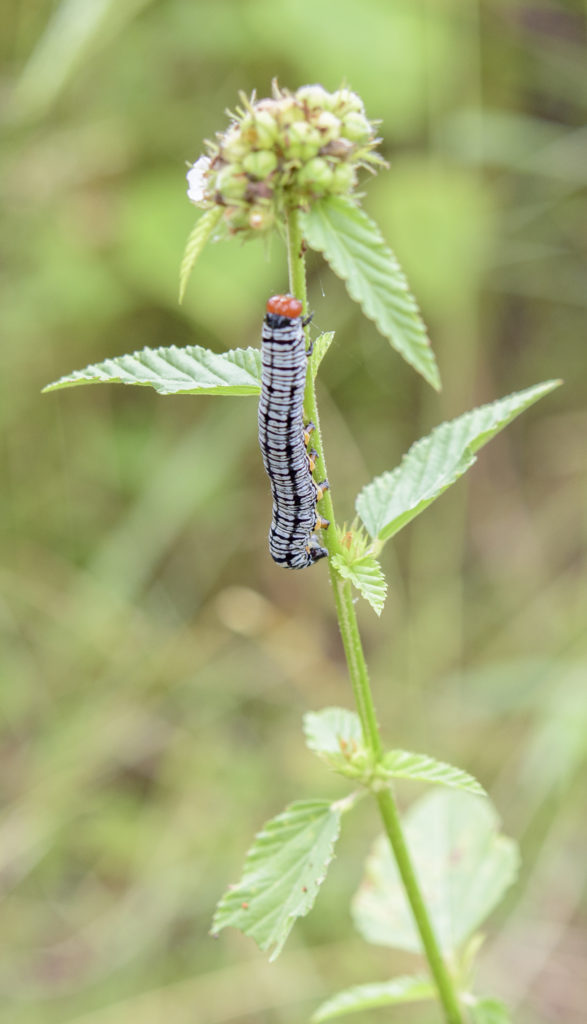
Hieroglyphic Moth, Diphthera festiva, feeding on the leaves of Melochia corchorifolia, one of its host plants.
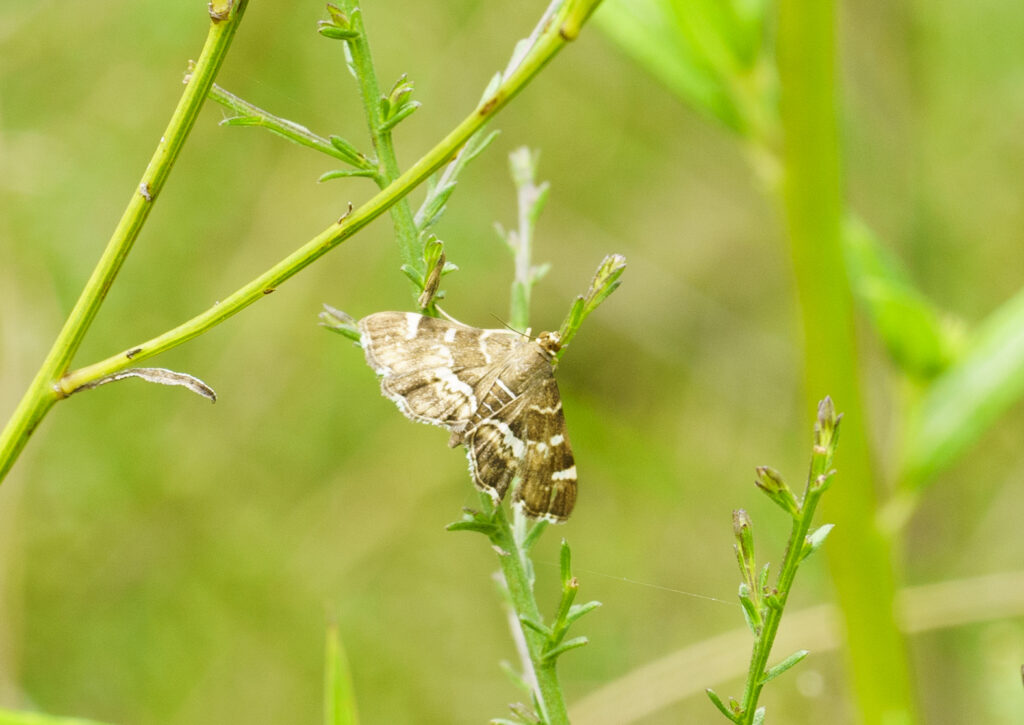
Spotted Beet Webworm Moth, Hymenia perspectalis, is fairly common east of the Rockies in the U.S.
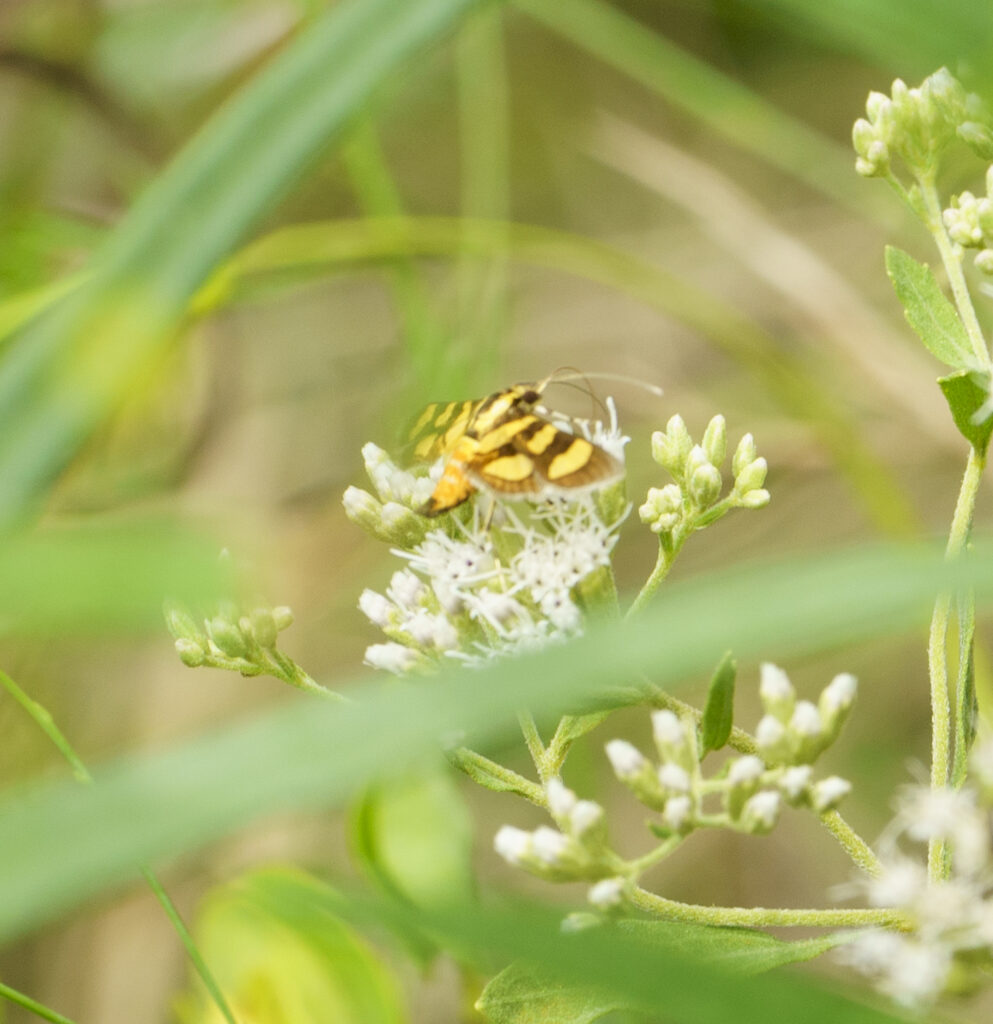
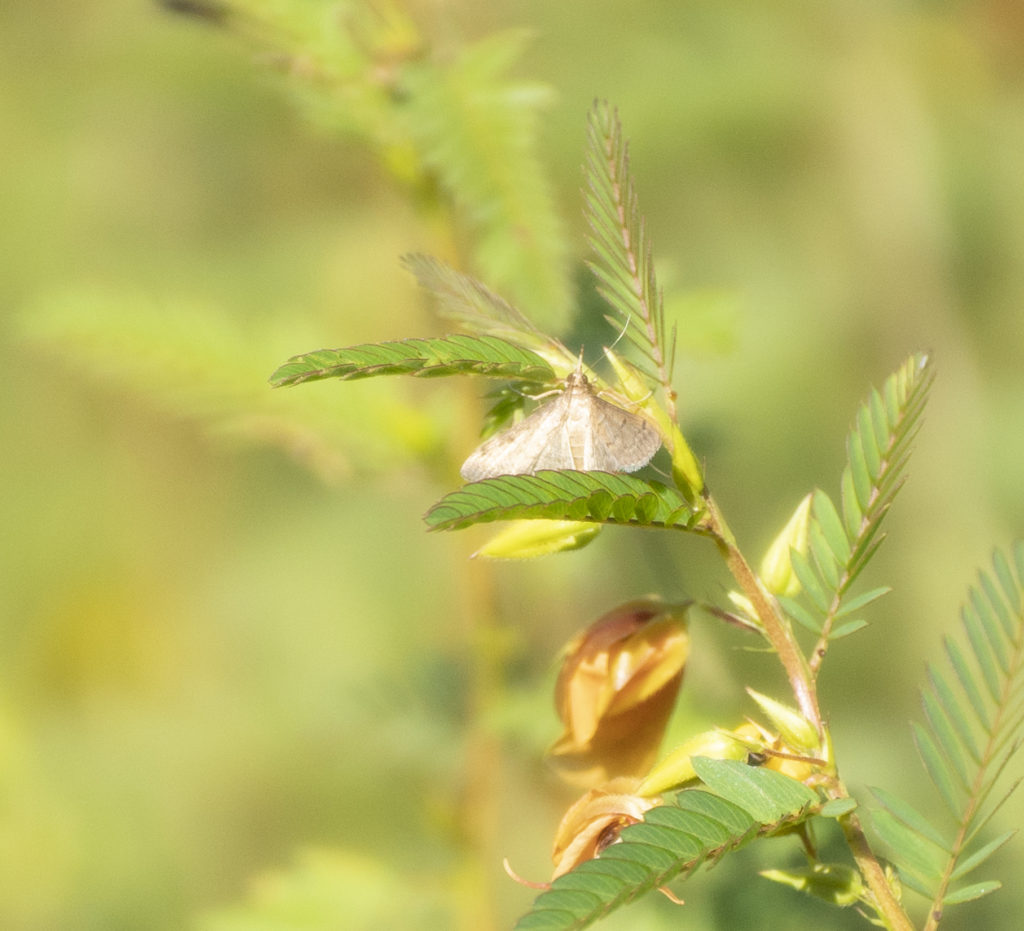
Dusky Herpetogramma Moth, Herpetogramma phaeopteralis, hundreds of these tiny litttle white moths among the Partridge Peas in the meadow.
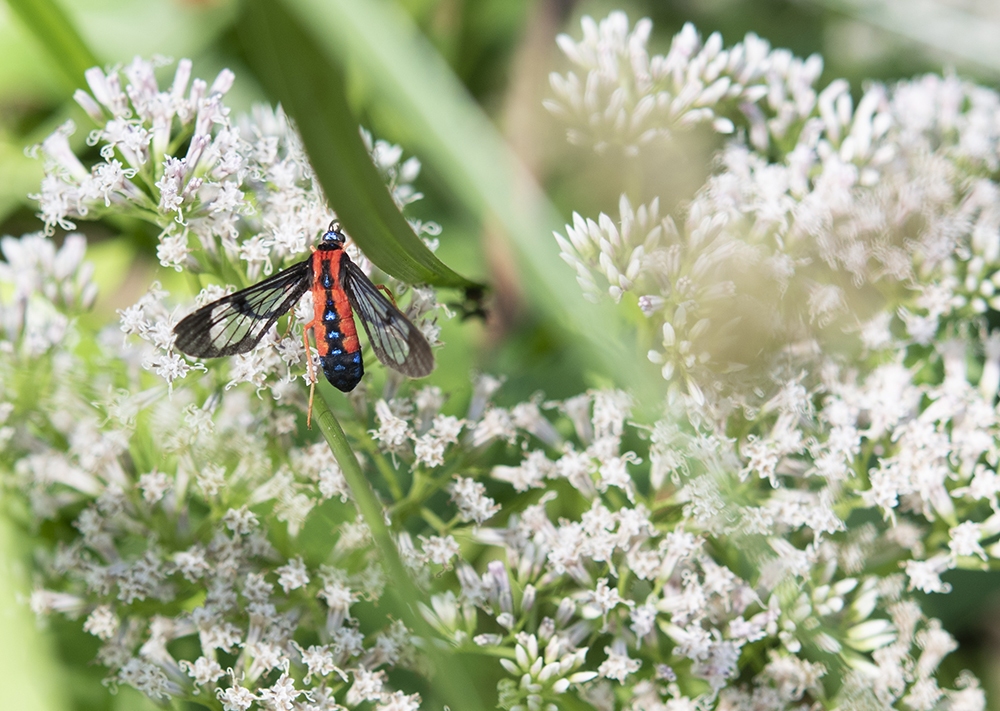
Scarlet-bodied Wasp Moth, Cosmosoma myrodora, found in the coastal plains from Florida to Texas, pollinating in the wetland at Vista Farm.
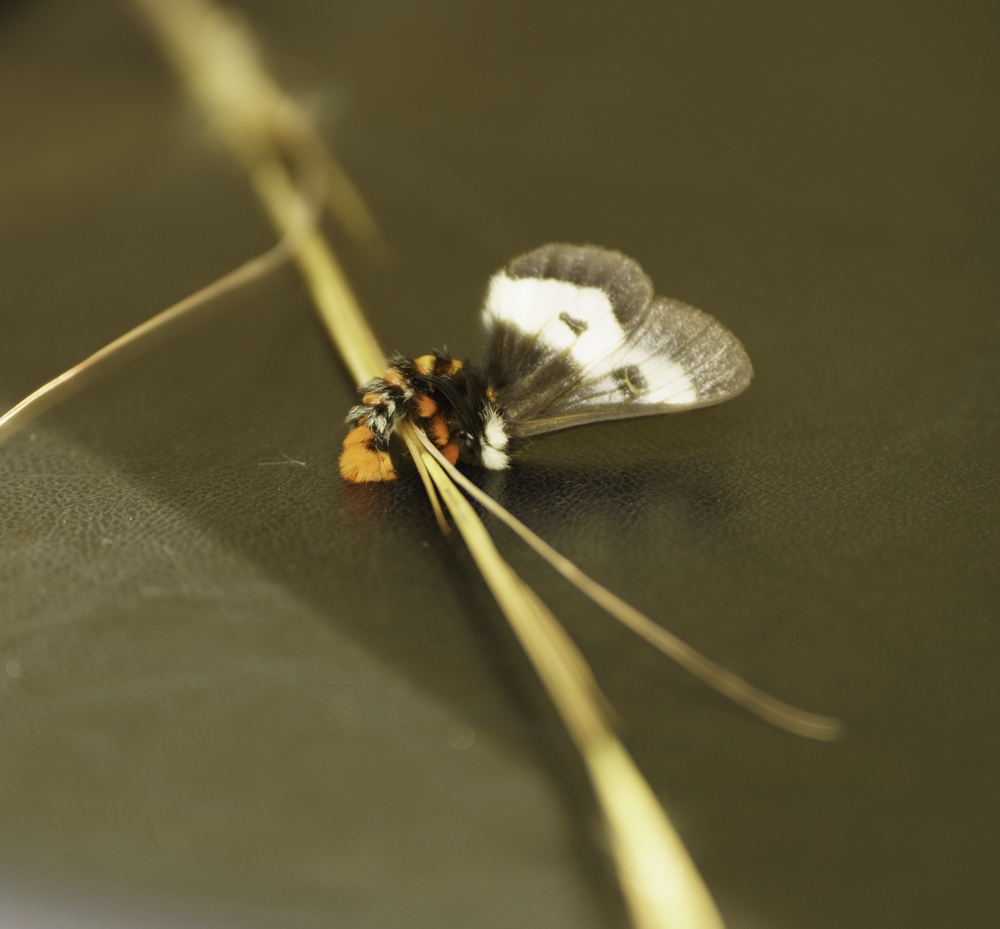
“The buck moth (Hemileuca maia)is a common insect found in oak forests, stretching in the United States from peninsular Florida to New England, and as far west as Texas and Kansas. It was first described by Dru Drury in 1773. The larvae typically emerge in a single generation in the spring. The larvae are covered in hollow spines that are attached to a poison sac. The poison can cause symptoms ranging from stinging, itching and burning sensations to nausea. Subspecies Hemileuca maia maia is listed as endangered in Connecticut. The larvae feed on various oaks including scrub oak (Quercus ilicifolia), live oak (Quercus virginiana), blackjack oak (Quercus marilandica), white oak (Quercus alba), and dwarf chinquapin oak (Quercus prinoides). Eggs are typically laid in spiral clusters on oak twigs. Mature larvae enter the soil or leaf litter to pupate in late July and emerge between October and the following February as moths to mate and lay eggs. In Louisiana, particularly in cities such as Baton Rouge or New Orleans, where use of live oaks as street trees is extensive, the caterpillars can become a significant nuisance for humans.” Wikipedia
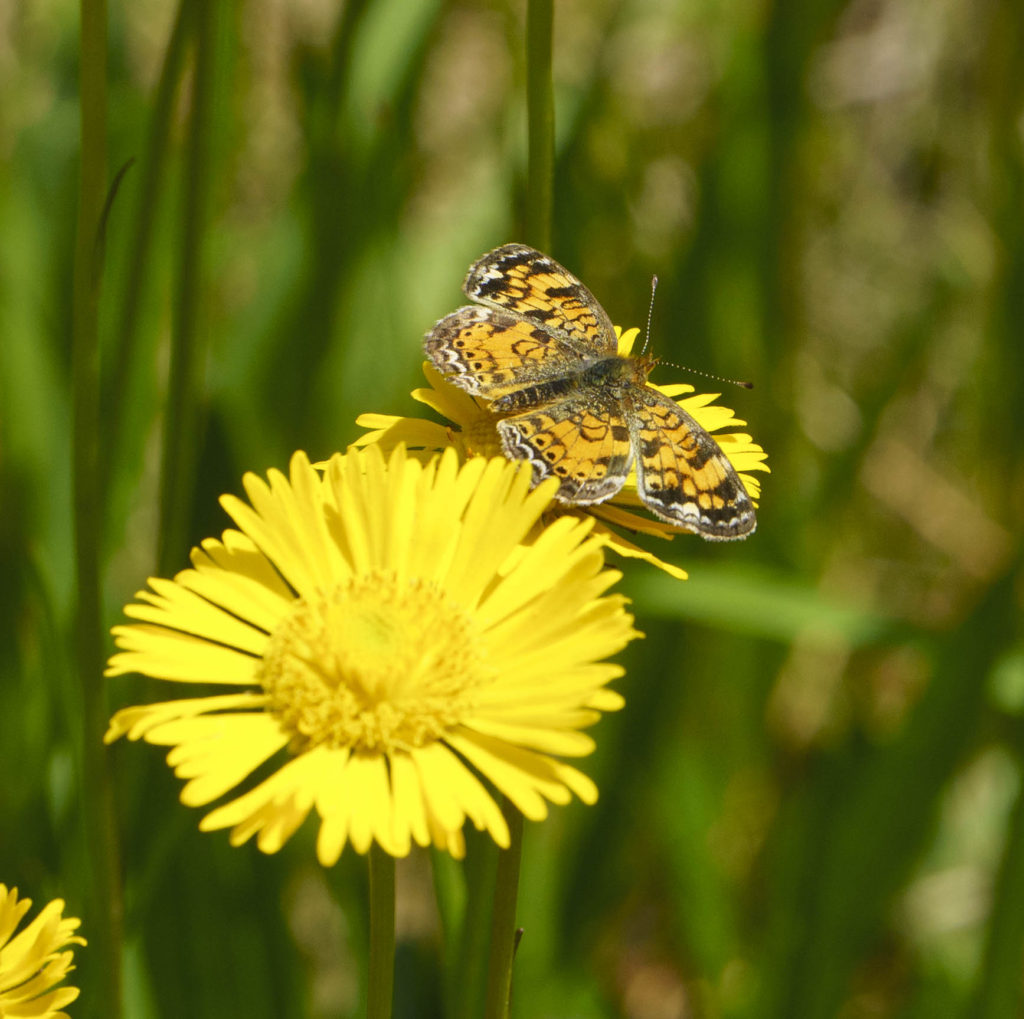
Pearl Crescent, Phyciodes tharos is a small butterfly found in all parts of the United States except the west coast. Its habitat is open areas such as pastures, road edges, vacant lots, fields, open pine woods. Male Pearl Crescents usually have black antenna knobs. Its upperside is orange with black borders; postmedian and submarginal areas are crossed by fine black marks. The underside of the hindwing has a dark marginal patch containing a light-colored crescent. Pearl Crescents have broods throughout the year in the deep south and Mexico. Adults find nectar from a great variety of flowers including dogbane, swamp milkweed, shepherd’s needle, asters, and winter cress. Source: Wikipedia
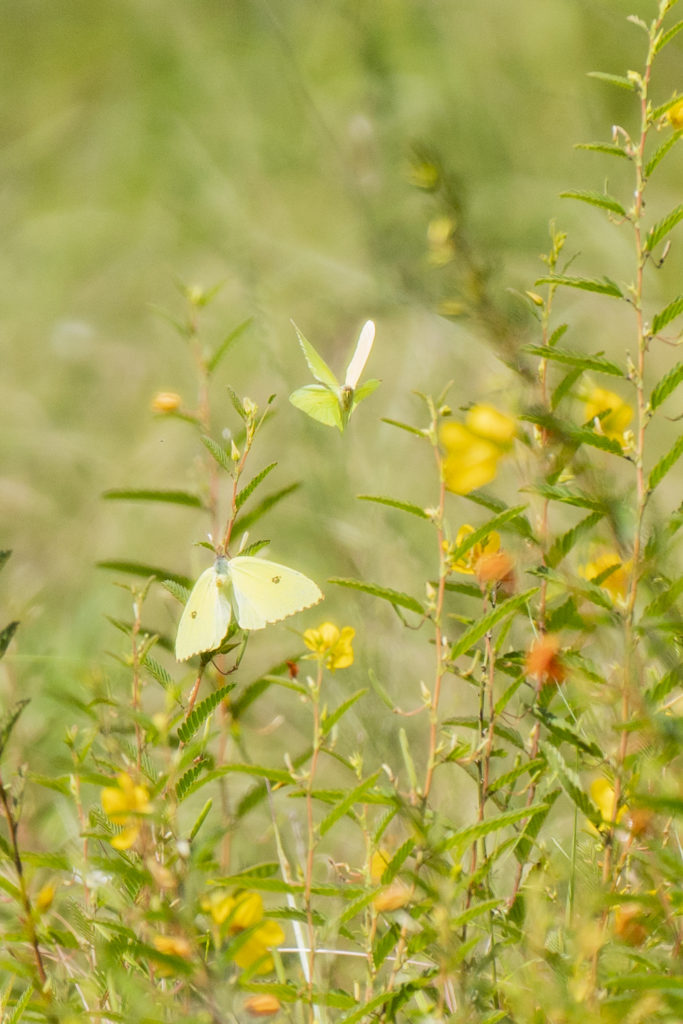
Cloudless Sulphur, Phoebis sennae, are abundant in the sunny moist meadow at Vista Farm. The caterpillar is a beautiful green, yellow and blue animal that is perfectly camouflaged on its host plant, Partridge Pea.
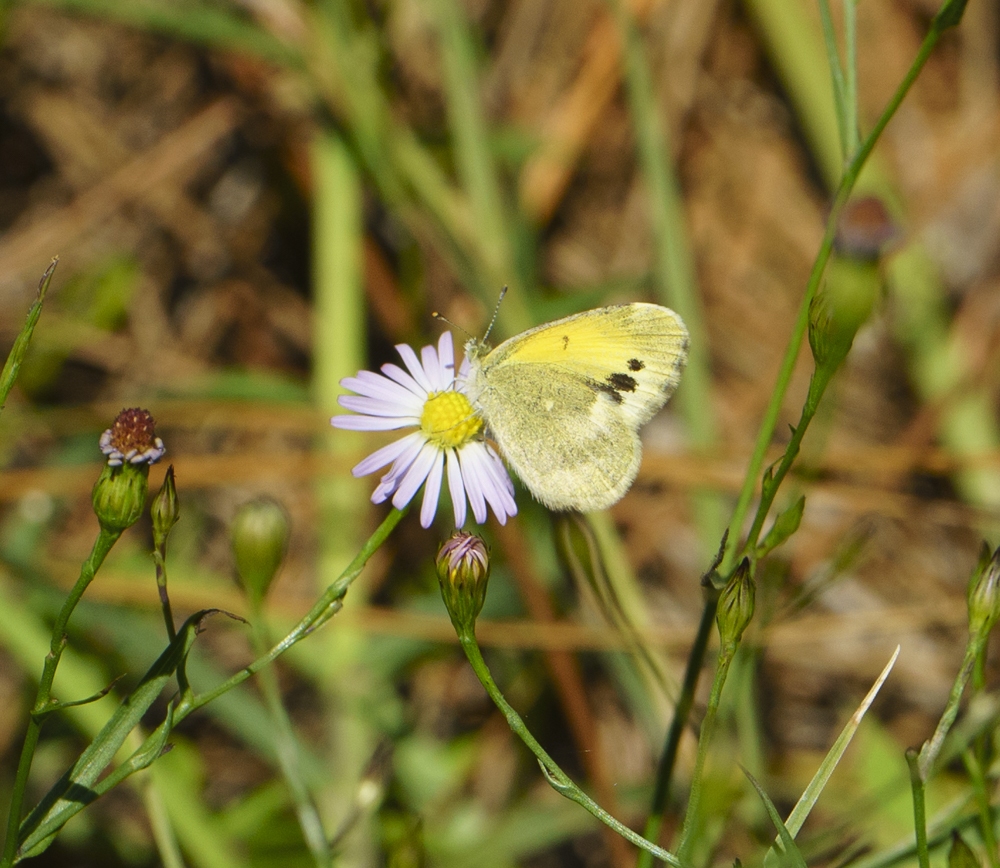
Dainty Sulphur, Nathalis iole, is a very small yellow butterfly that lives in almost any open space including coastal flats, deserts, fields, roadsides, vacant lots and waste areas. It usually flies very low to the ground.
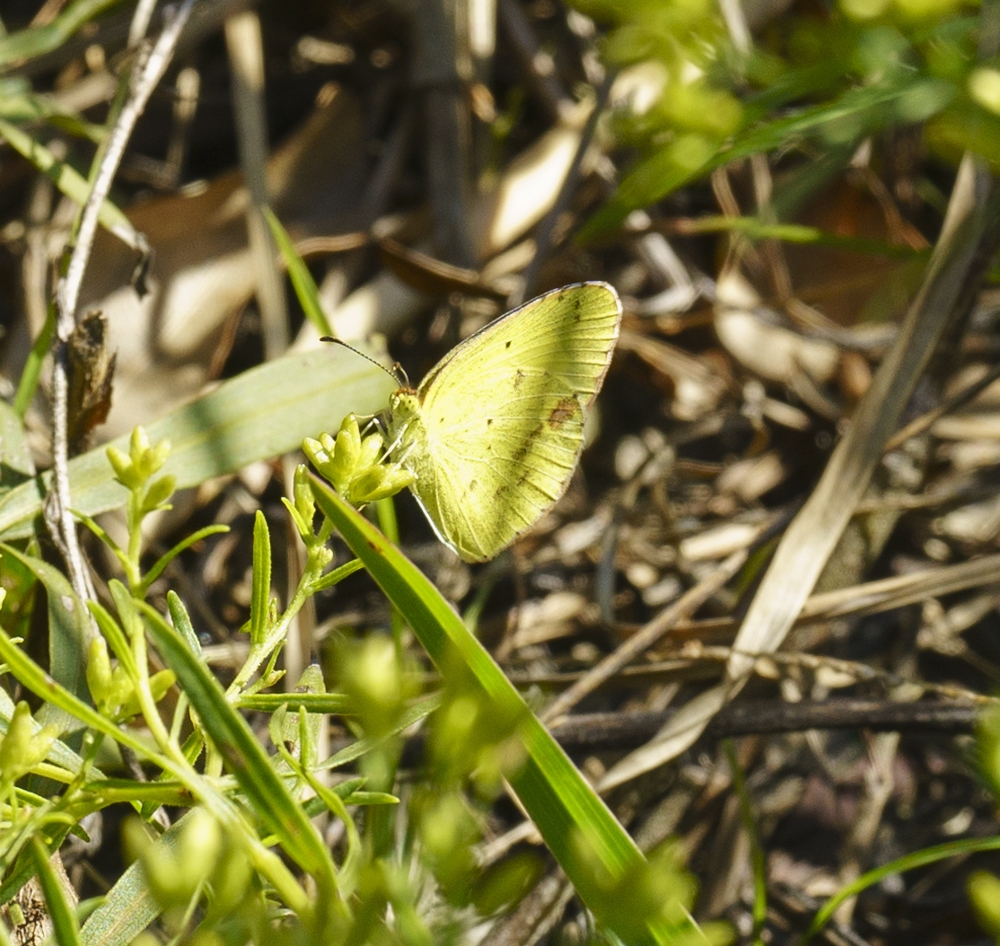
Little Sulphur, Pyrisitia lisa, can be seen in open areas, most commonly old fields. Hosts include asters and Partridge Pea.
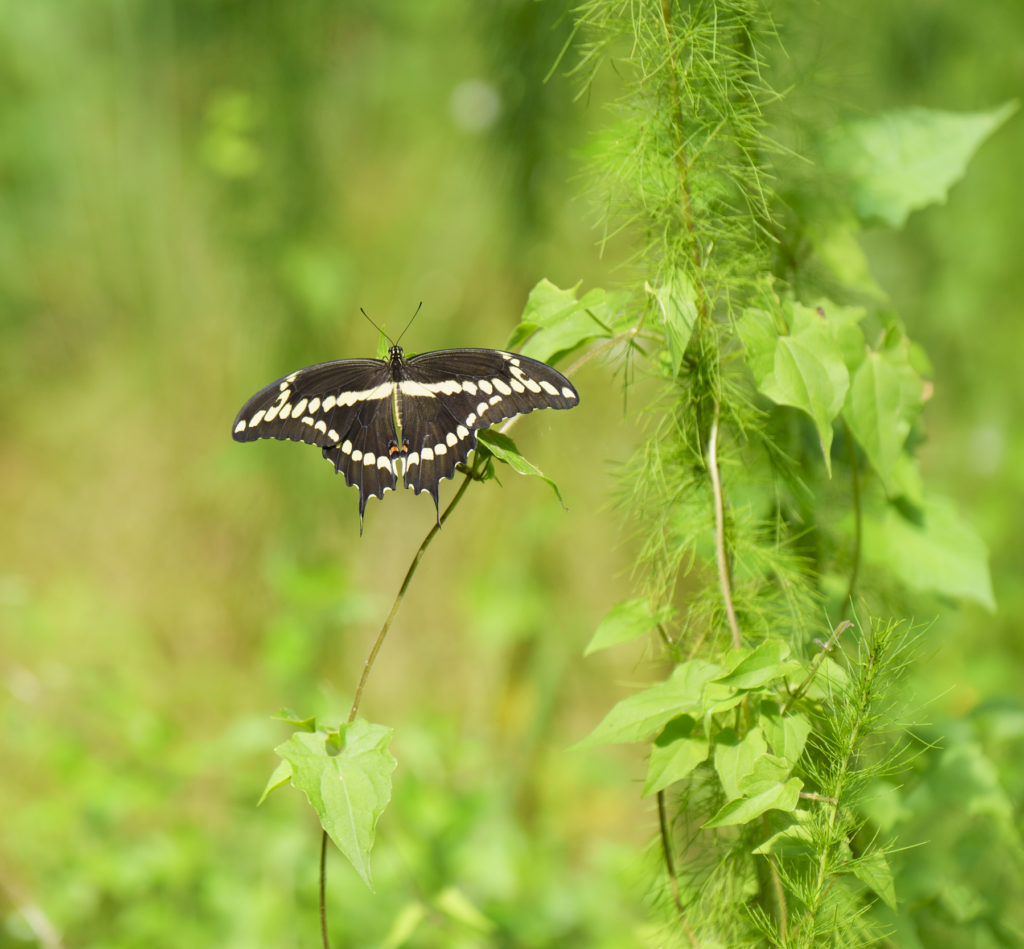
The largest butterfly in North America, Eastern Giant Swallowtail, Papilio cresphontes, pollinating in the meadow at Vista Farm.
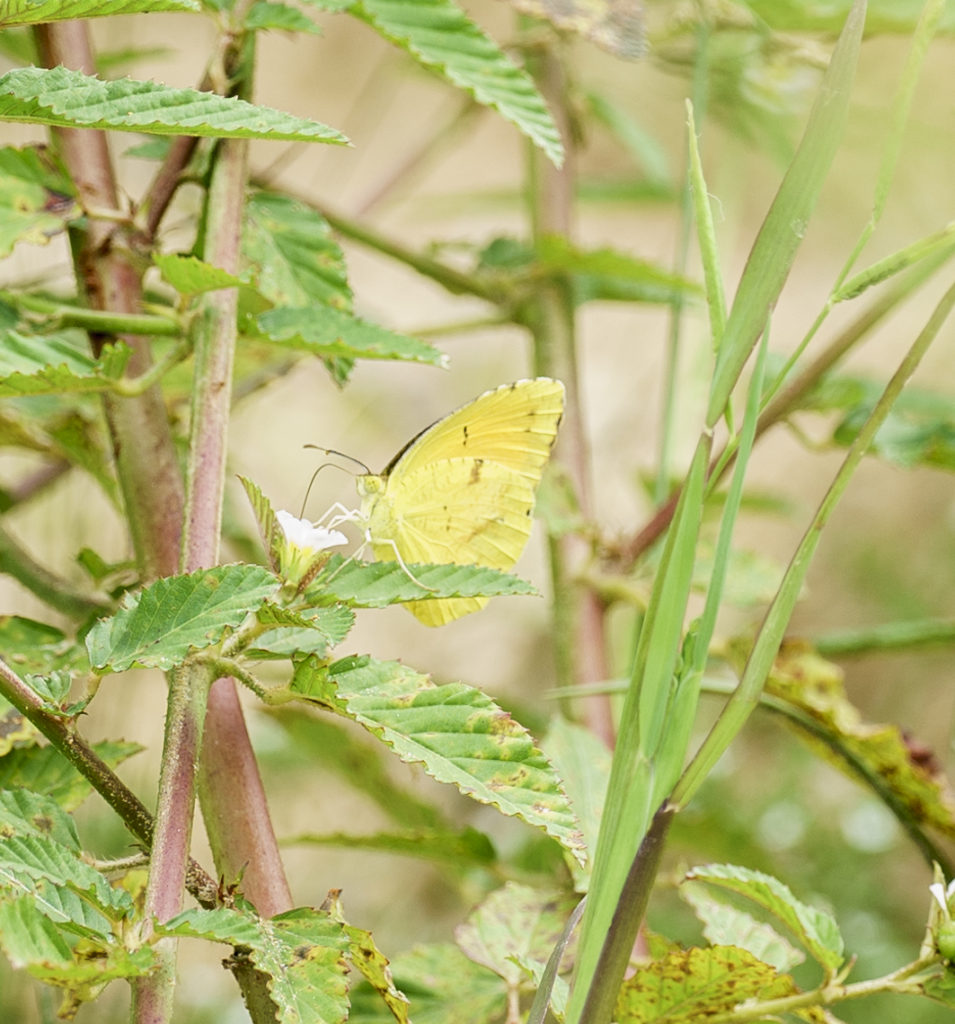
Sleepy Orange, Abaeis nicippe. The sleepy orange is a bright orange butterfly with the upperside of the wings having wide black borders. The forewing coastal margin has a small, narrow black spot. When disturbed, the butterfly has a very rapid flight. The sleepy orange may be found in or around old fields, roadsides, woods edges, swamps, wet meadows, open woodlands, margins of ponds, waterways, and valleys. It’s host plant at Vista Farm is Partridge Pea. Source: Wikipedia
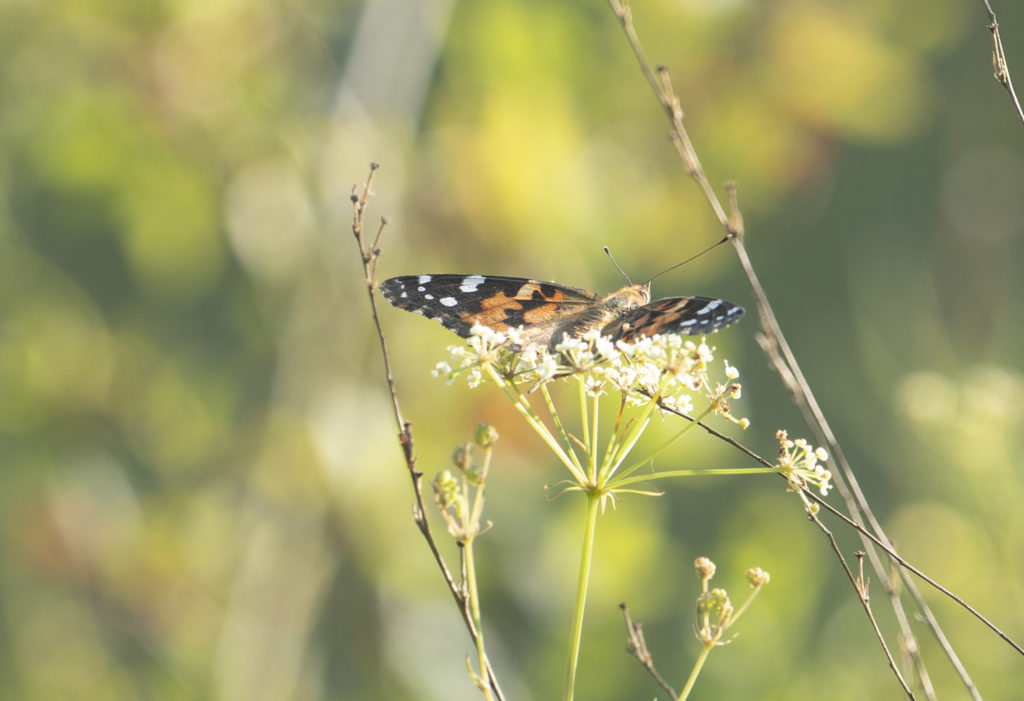
Painted Lady, Vanessa cardui, was almost mistaken for a Monarch, but here it is, on Cowbane in the sunny meadow.
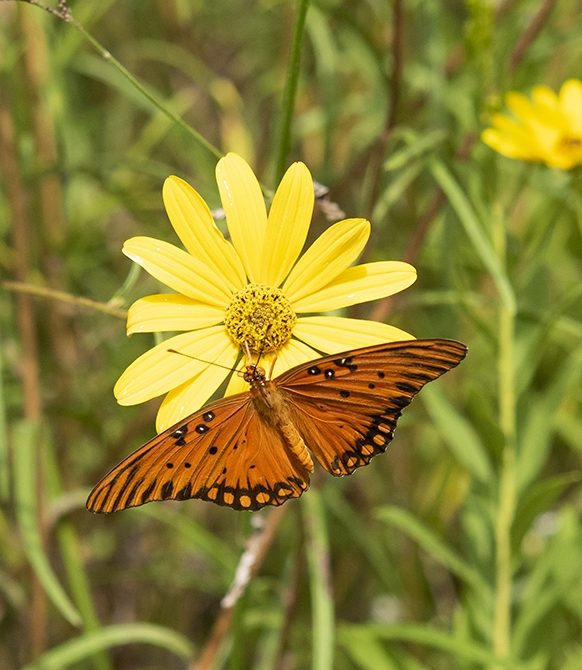
Gulf Fritillary, Agraulis vanillae, an beautiful orange and black butterfly pollinating the sunflowers in the meadow at Vista Farm.
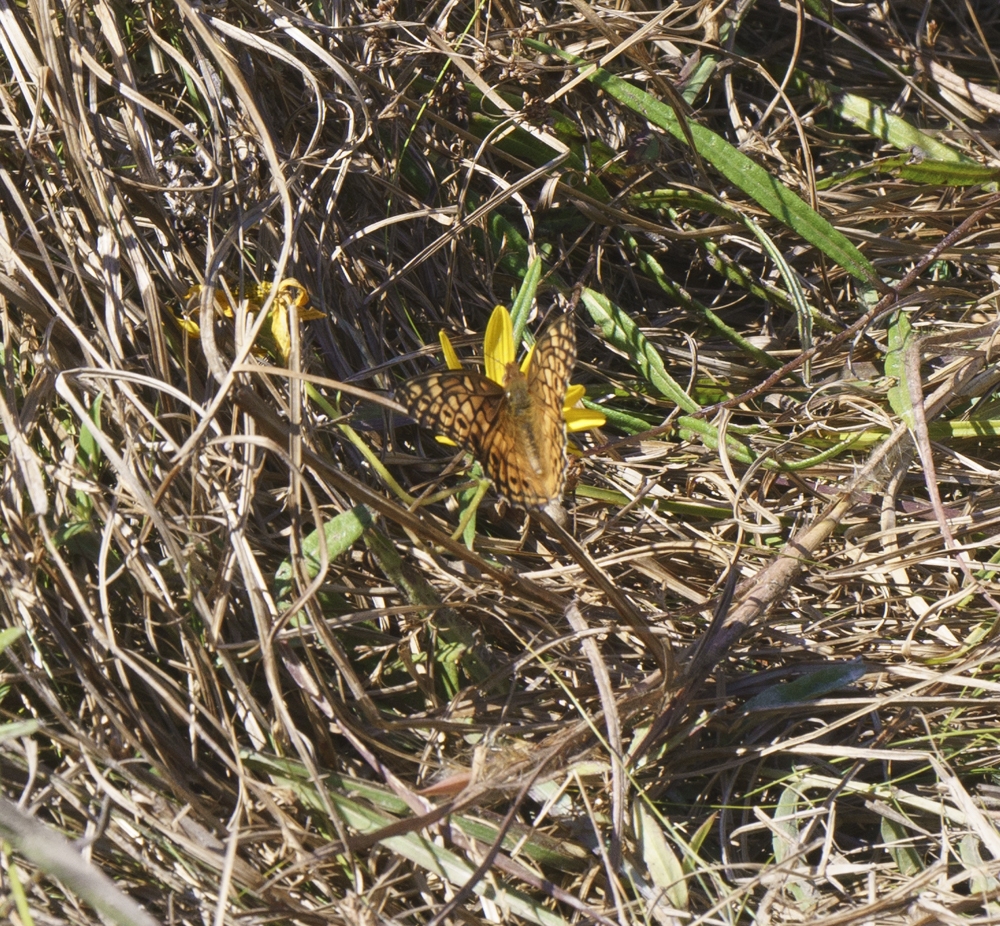
Variegated Fritillary, Euptoieta claudia, is a lovely brown, orange and white butterfly common in many parts of the U.S., but not so much in St. Tammany Parish. Host plants for the Variegated Fritillary include Passion vines, violets, Pansies, Purslane, Mayapple, Flax, others.
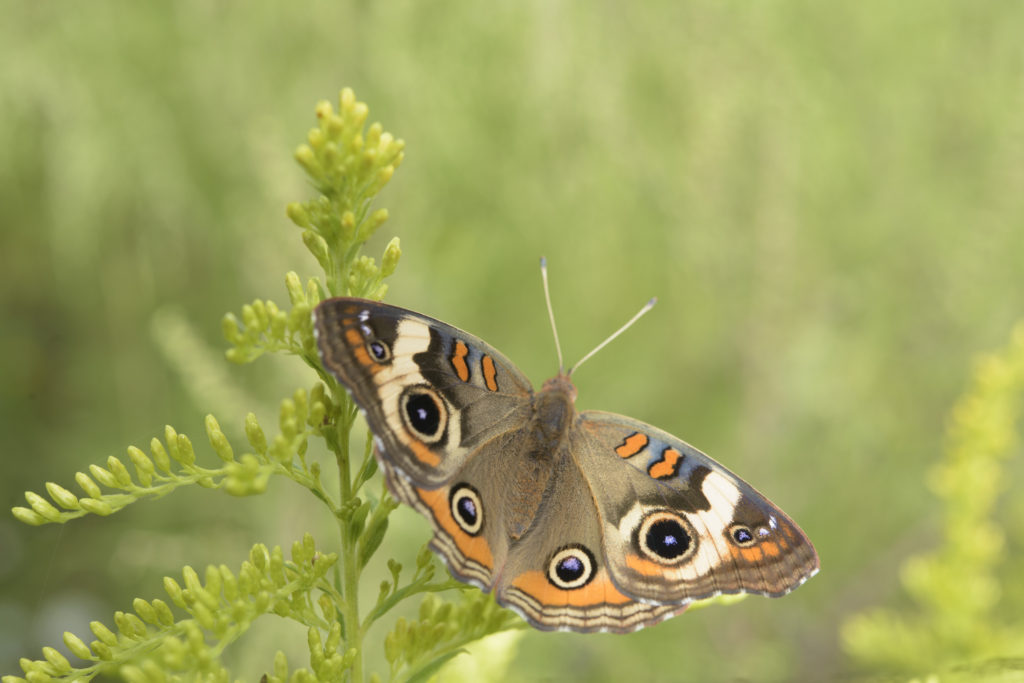
Common Buckeye, Junonia coenia. The caterpillar is here.
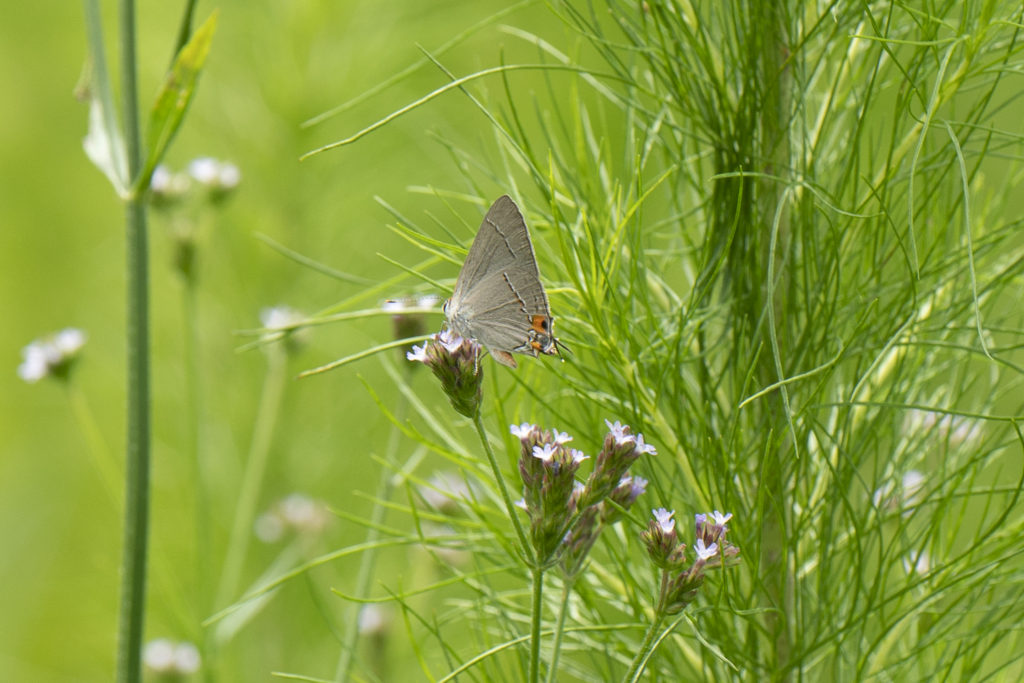
Gray Hairstreak, Strymon melinus, a small Skipper pollinating the meadow at Vista Farm. It’s host at Vista Farm is Parsley Hawthorn.
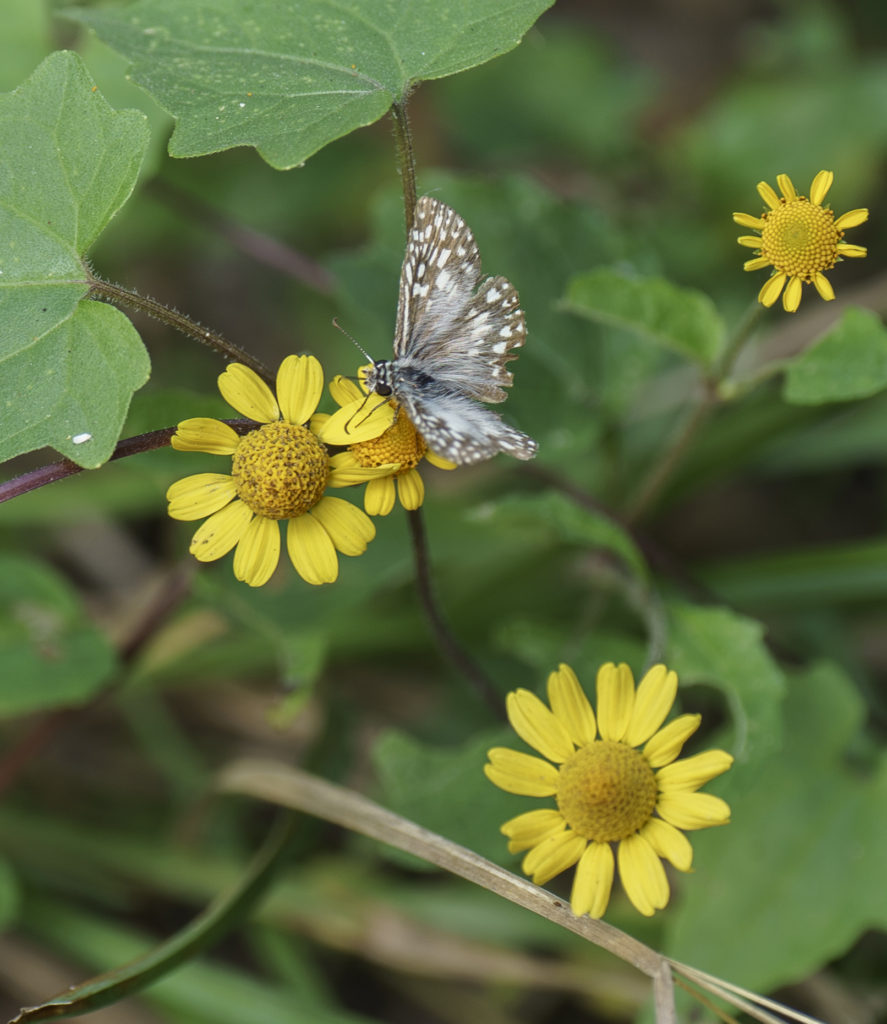
Common White Checkered Skipper Complex, Complex Burnsius communis, on Spotflower at the edge of the forest.
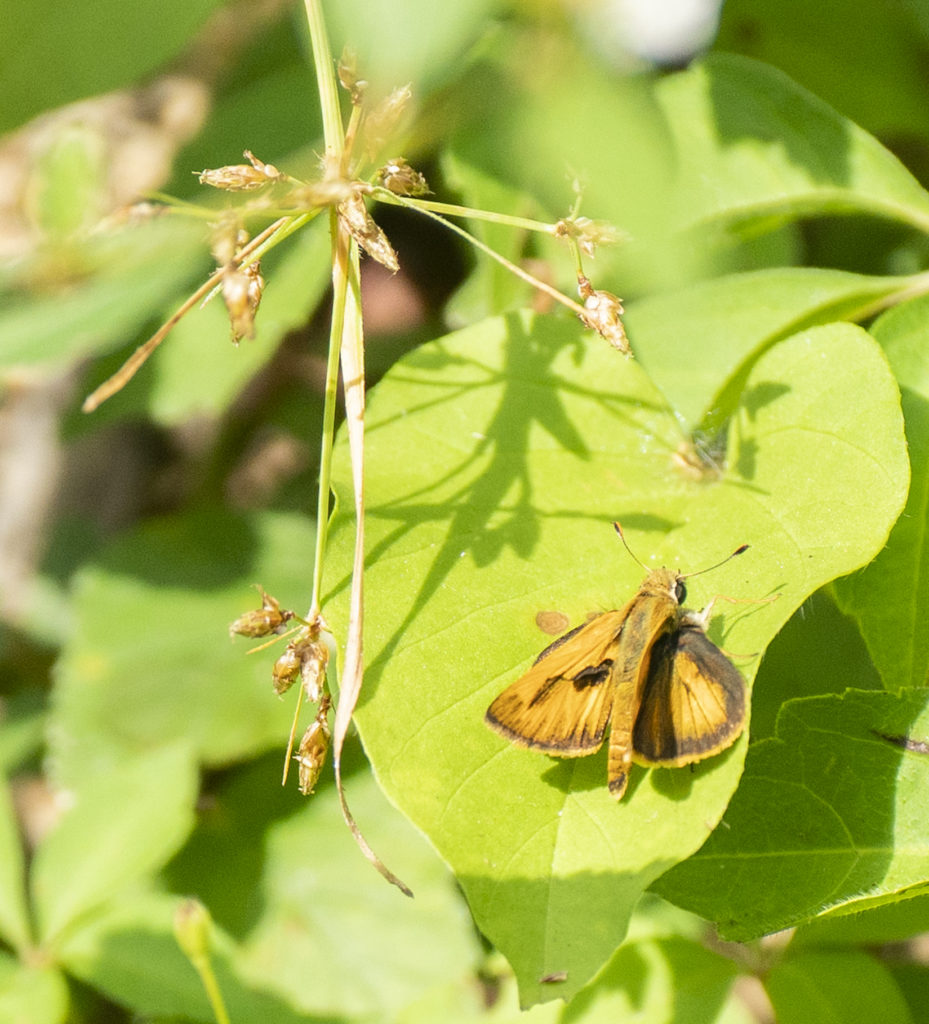
Whirlabout, Polites vibex, a tiny Skipper on a Morning Glory leaf at Vista Farm. A mating pair is here.
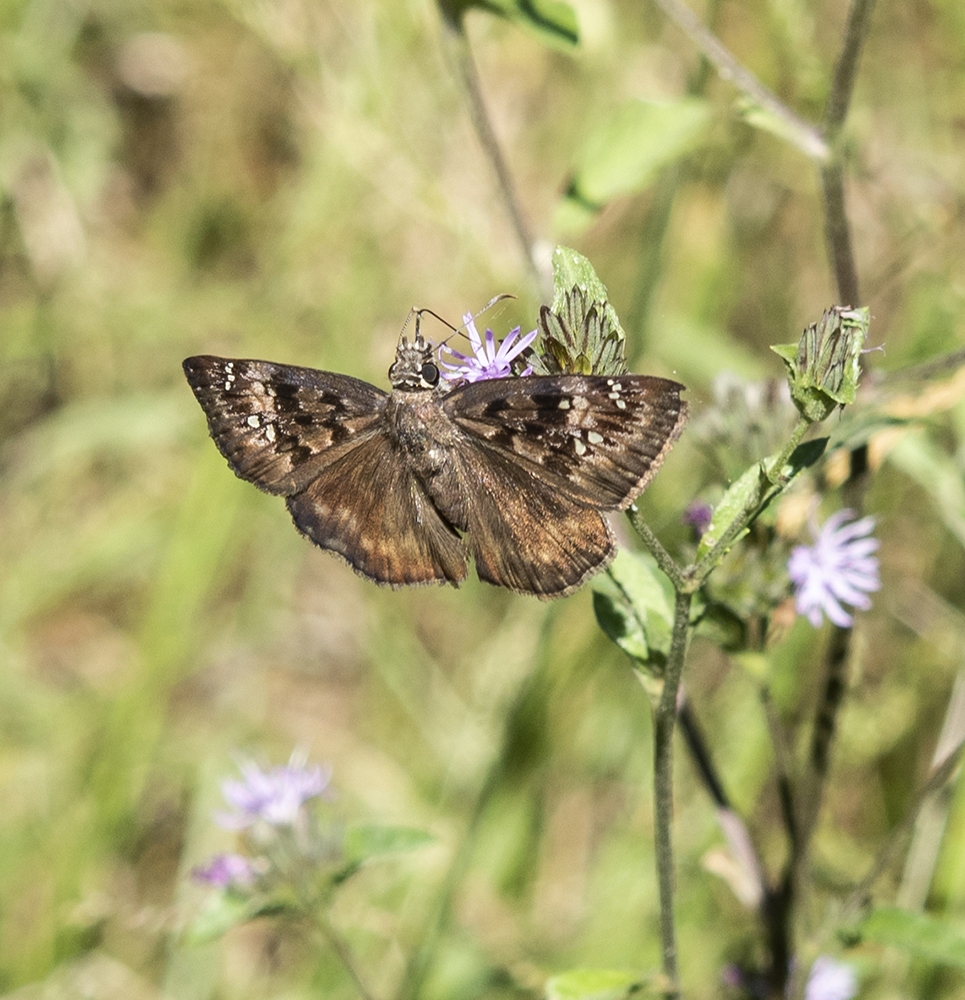
Horace’s Duskywing, Erynnis horatius, a skipper butterfly of the family Hesperiidae. Adults prefer open woodlands and edges, clearings, fence rows, wooded swamps, power-line right-of-ways, open fields and roadsides. Caterpillars are hosted by red and white oaks, including willow oak, northern red oak, scrub oak, water oak, post oak, and live oak. They prefer nectar from flowers up to about 4.5 feet tall, including dogbane, buttonbush, sneezeweed, goldenrod, peppermint, boneset, and winter cress.
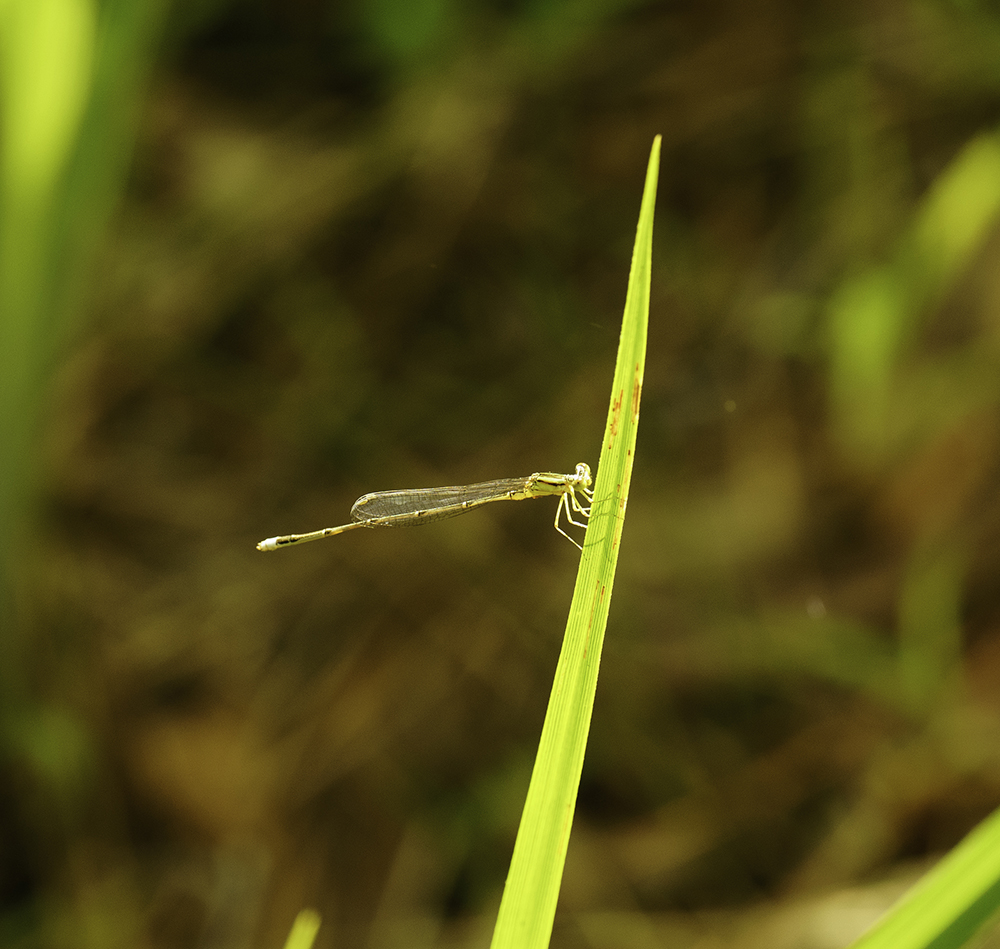
Furtive Forktail, Ischnura prognata, a narrow-wing damselfly, that inhabits the well-shaded mucky wetland at Vista Farm. Males are greenish; females are more yellowish.
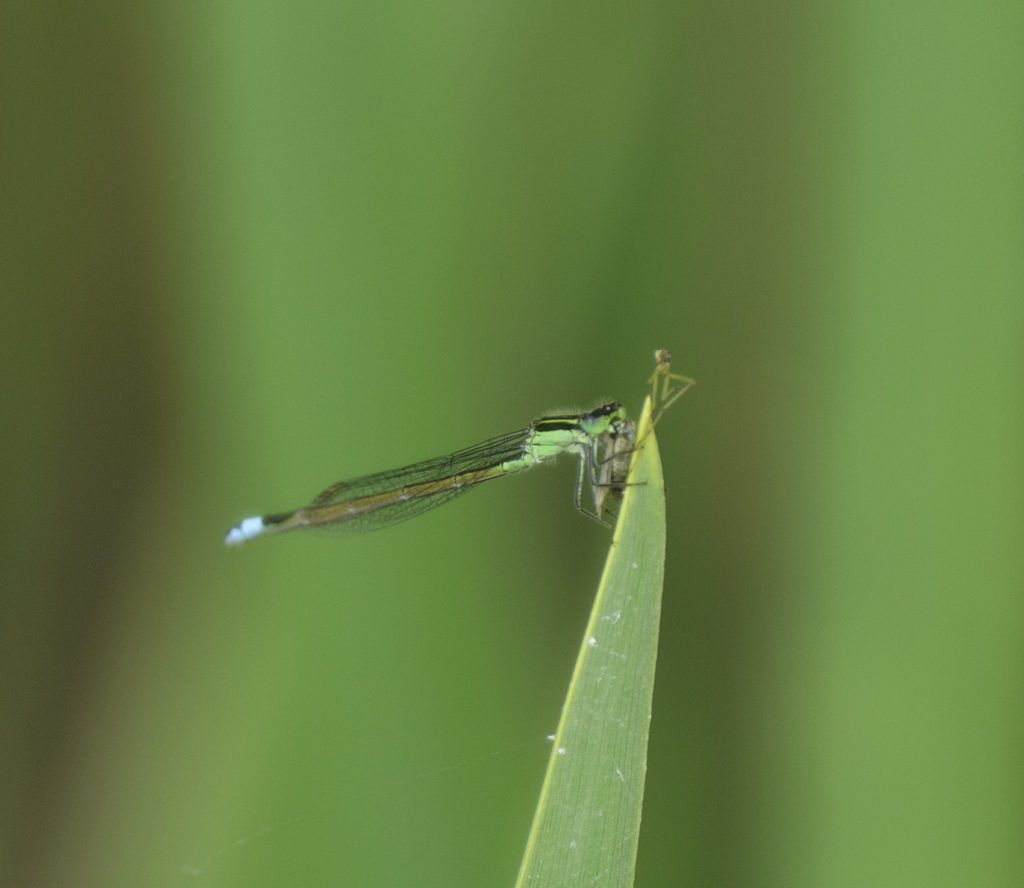
Rambur’s Forktail, Ischnura ramburii, a tiny damsel fly eating a bug. Males are green with blue, while females are orange-red, olive green, or similar to males in coloration. It is the most widespread New World Ischnura, occurring throughout the Americas from the United States to Chile, as well as Hawaii and the Antilles. Ponds, lakes, marshes, and slow streams with vegetation and sunlight are its main habitat.
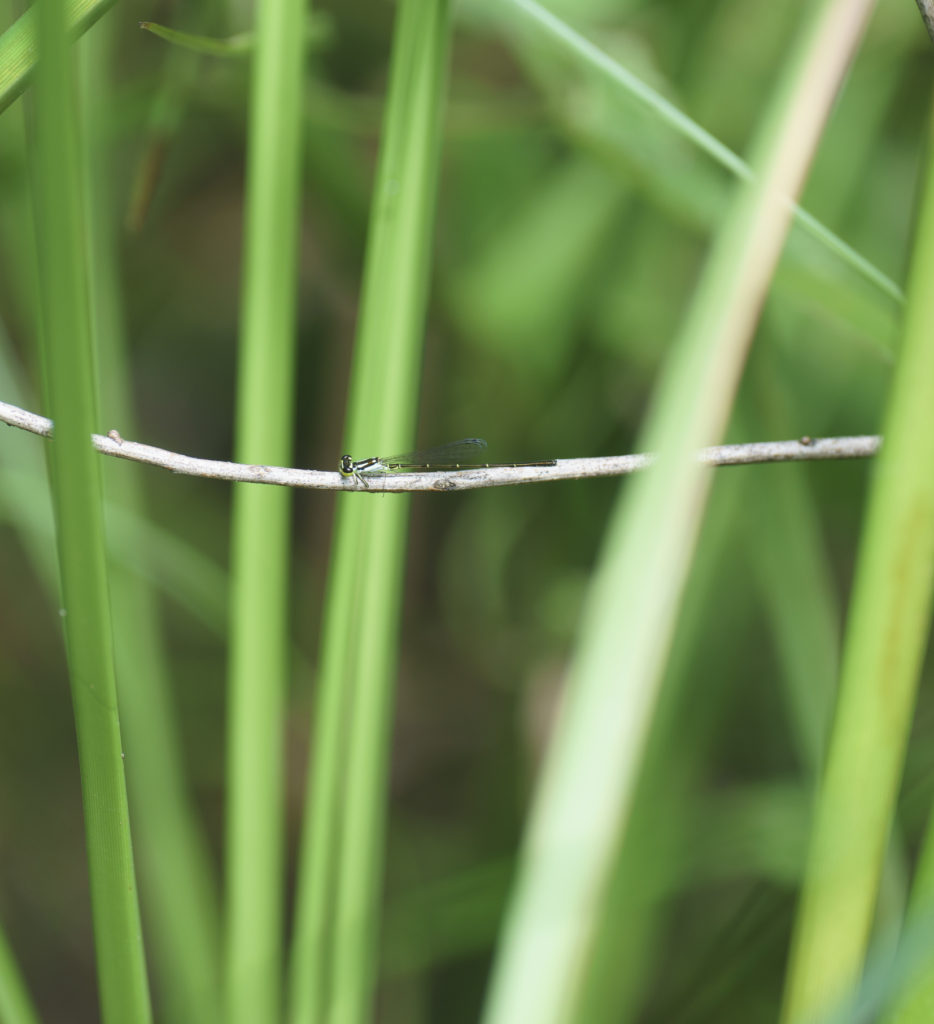
Fragile Forktail, Ischnura posita, is a small damselfly that is an occasional visitor in the wetland at Vista Farm.
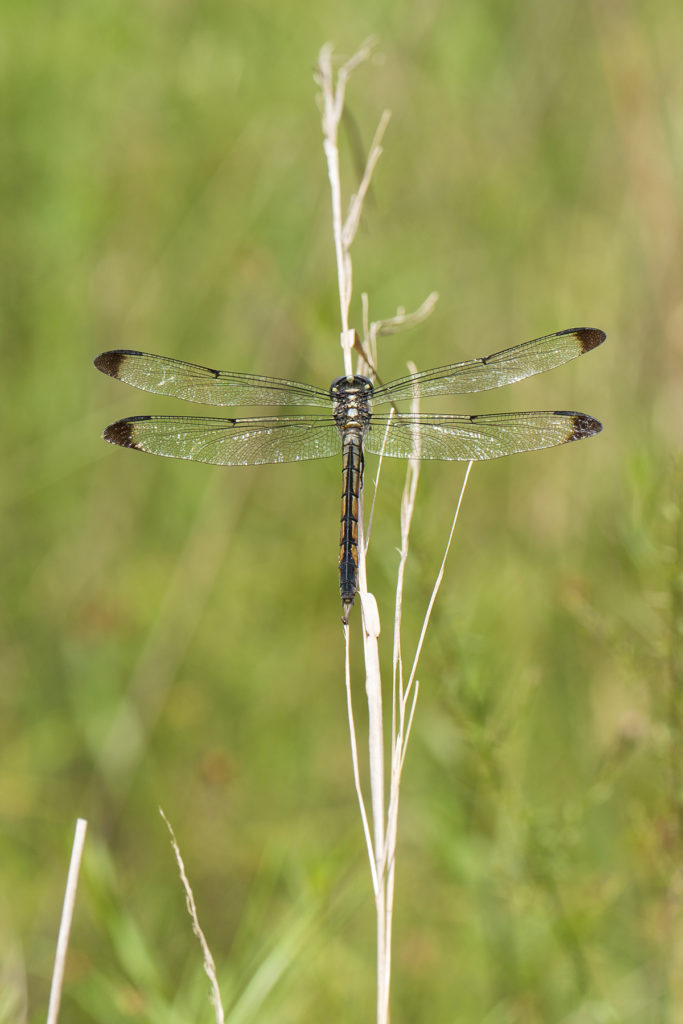
Great Blue Skimmer, Libellula vibrans, is a large dragonfly found in the meadow. Their coloration changes depending on age and sex – young females and young males have yellow abdomens with a black stripe. Older females turn a dull brown and have blueish to reddish-brown eyes. Mature males are a spectacular blue, with teal-colored eyes.
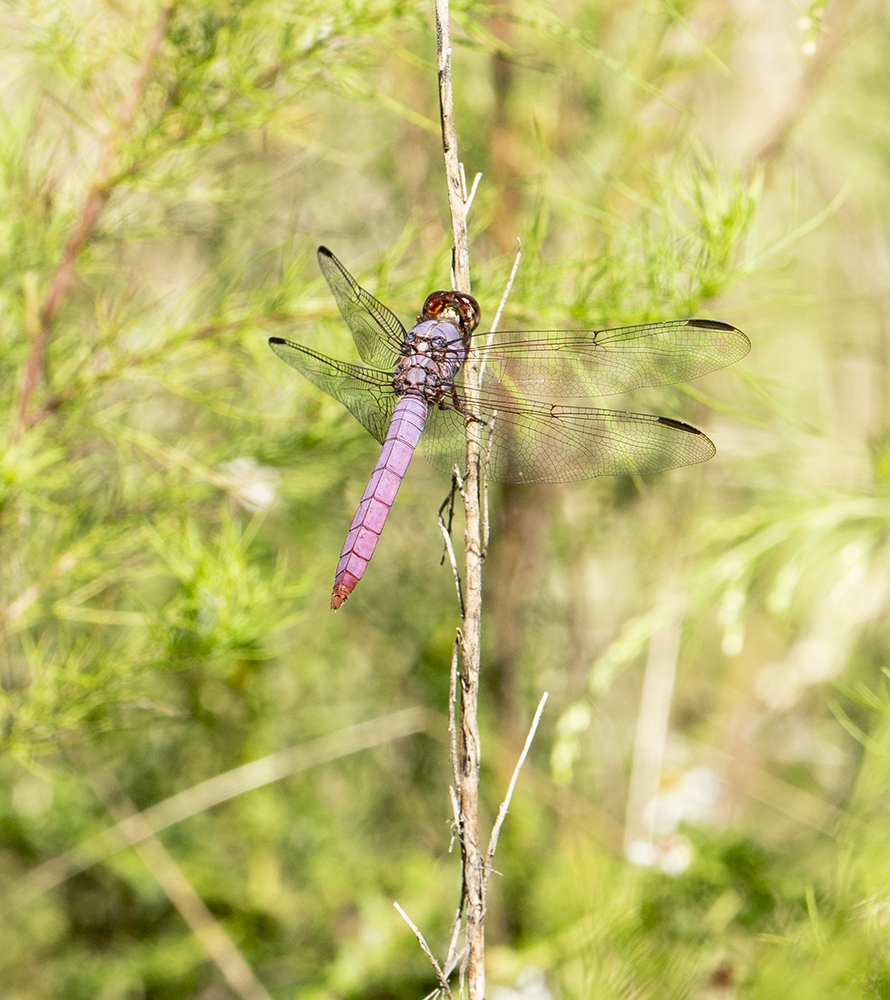
Roseate Skimmer, Orthemis ferruginea, a beautiful pink dragonfly in the meadow at Vista Farm. The male of the species has a rose pink and red abdomen. The female has an orange-brown abdomen with clear orange veins and a brownish thorax with a light stripe down the back.
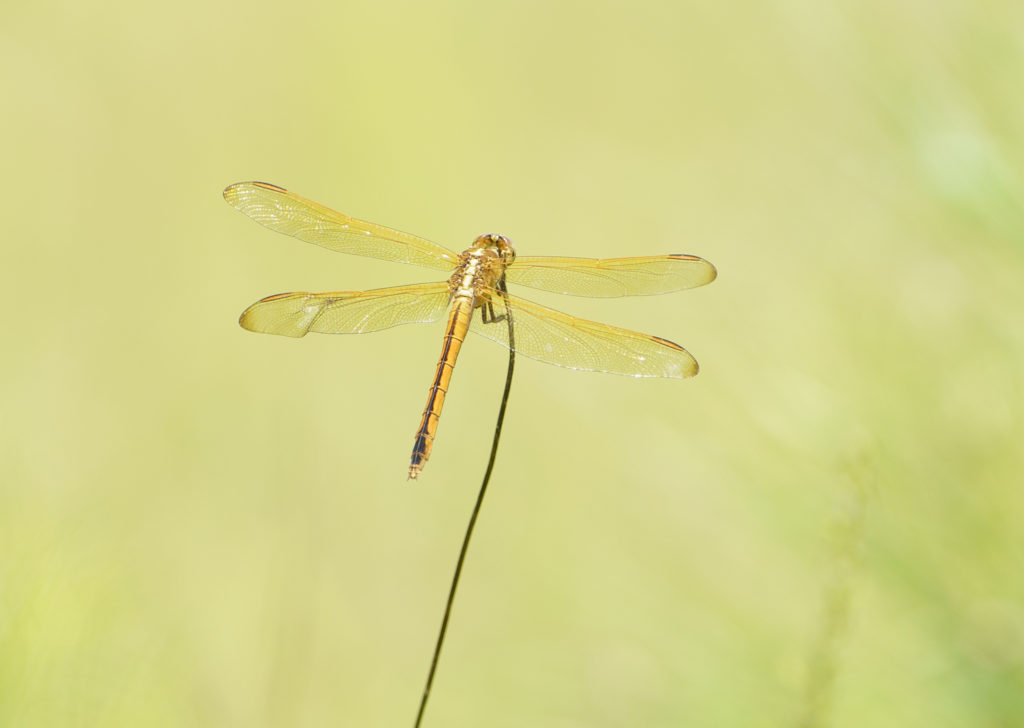
Needham’s Skimmer, Libellula needhami, is a beautiful golden dragonfly living in the sunny meadow at Vista Farm. Male is here.
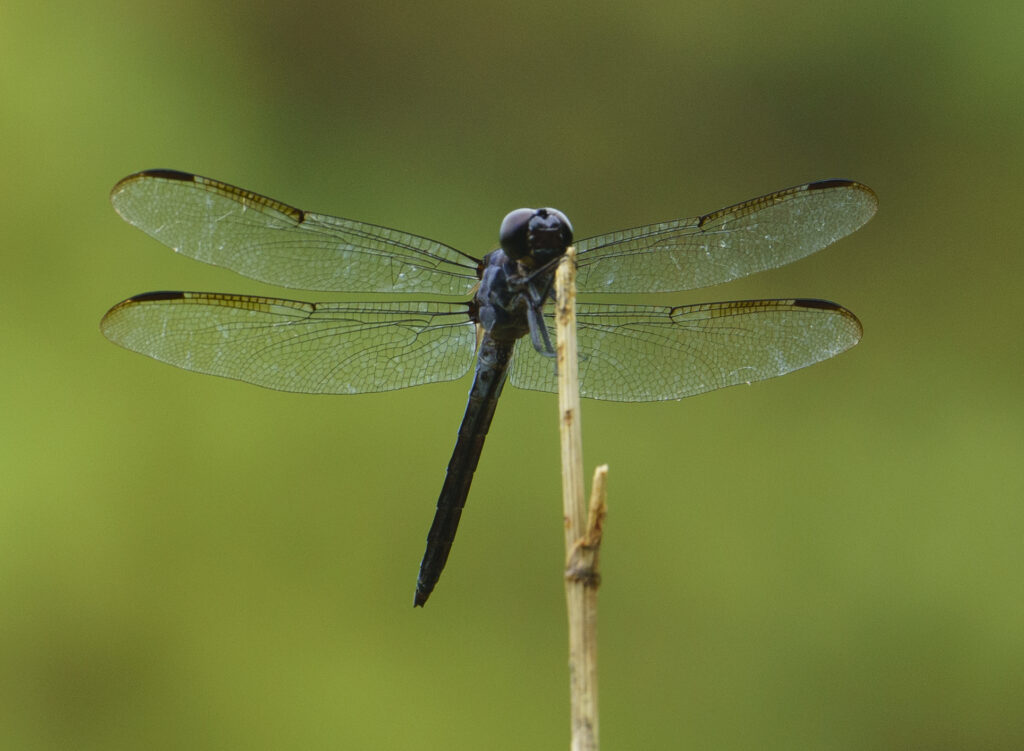
Slaty Skimmer, Libellula incesta, prefers very shallow marshy pools in the full sun. Similar to Great Blue Skimmer or Blue Dasher, but darker (almost black). At Vista Farm it tends to perch at the top of tall cowbane stalks. from which it feeds among the sedges in full sun, but near the wet woodland.
Beetles
Beetles, like all insects are invertebrates. They have a head, thorax, abdomen, a single pair of antennae, compound eyes and six legs. They also have one and sometimes two pairs of wings–smaller outer ones for protection and inner ones used for flying.
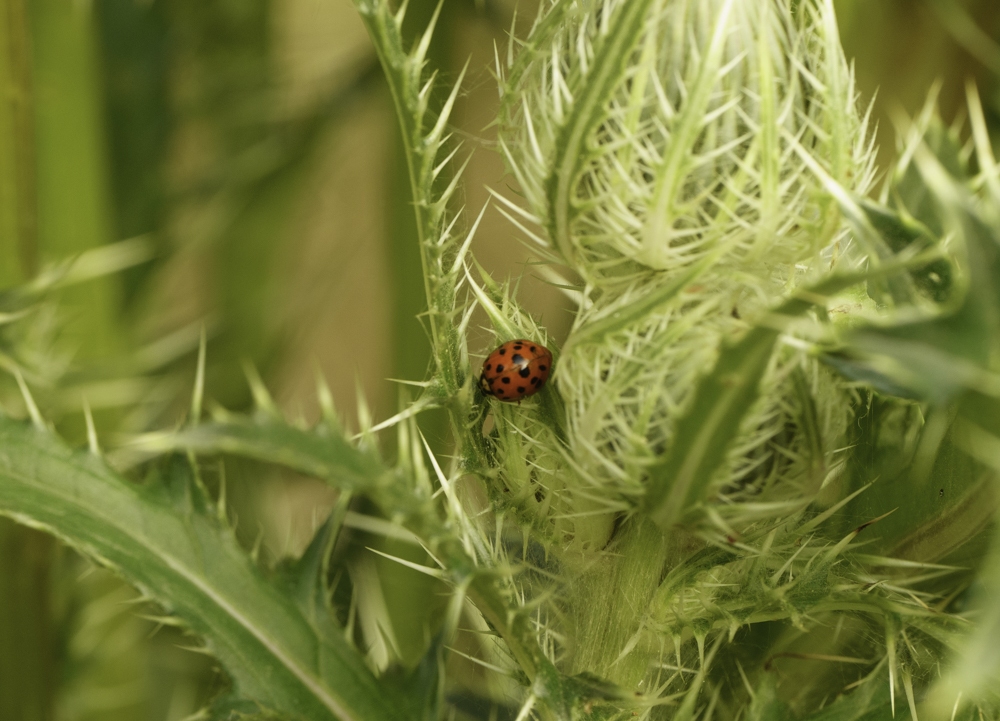
Asian Lady Beetle, Harmonia axyridis, is native to eastern Asia, but was artificially introduced to North America and Europe to control aphids and scale insects.
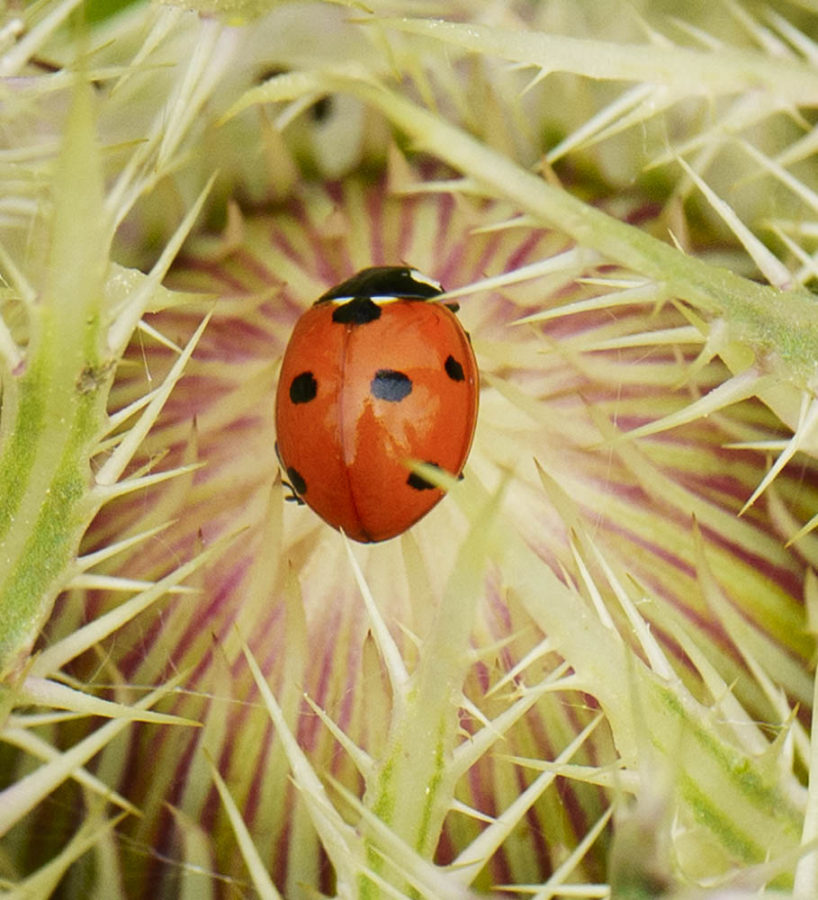
Seven-spotted Lady Beetle, Coccinella septempunctata, lives where there are aphids for it to eat and including meadows, fields, parks, gardens, and forests. Both adults and larvae are voracious predators of aphids which cause damage to crops and gardens. The Seven-spotted Lady Beetle is the official state insect of Delaware, Massachusetts, New Hampshire, Ohio, and Tennessee. Although C. septempunctata mainly hunt aphids they also feed on the larvae and eggs of some other beetles and even butterflies. The species can secrete a fluid from joints in their legs which gives them a foul taste to predators. Source: Wikipedia
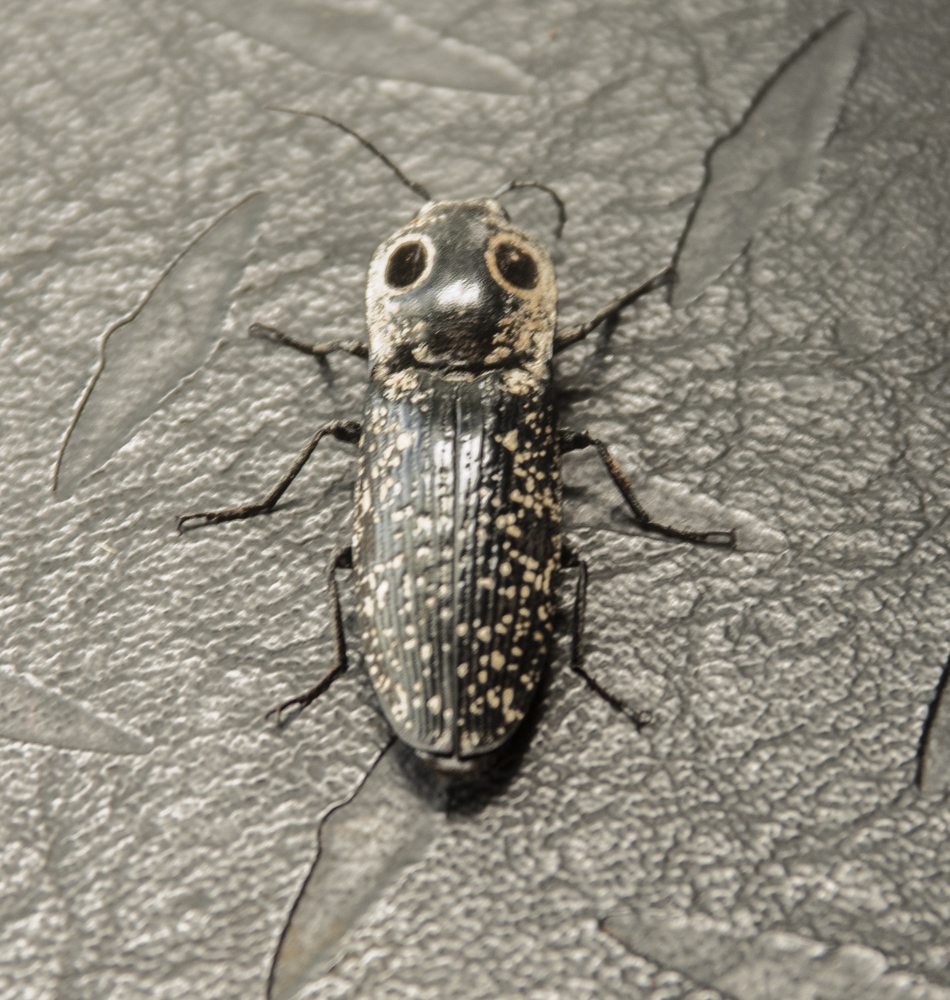
Eastern Eyed Click Beetle Alaus oculatus. The “false eyes” depicted on the pronotum are a defensive adaptation that has evolved because of its advantage confusing or frightening potential predators. The adults do not eat much, but their diet consists of nectar and plant juice. The larvae have a voracious appetite for grubs of wood-boring beetles.
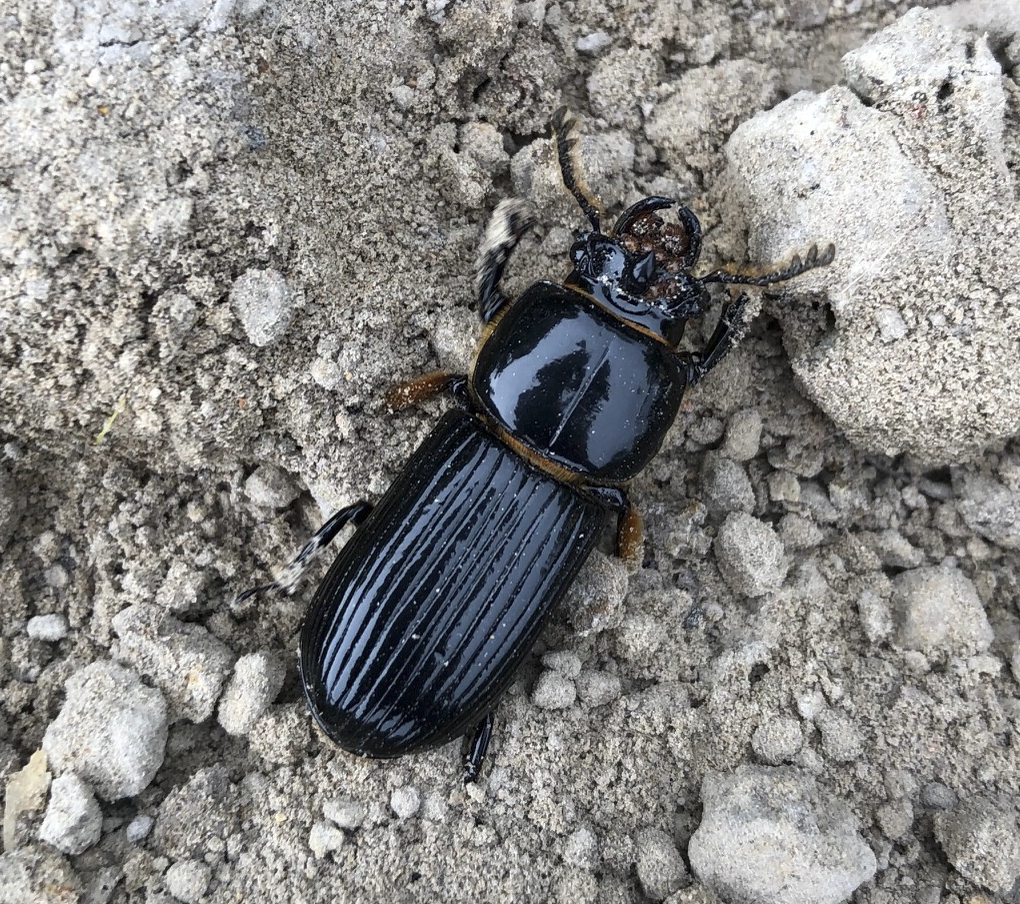
Horned Passalus Beetle, Odontotaenius disjunctus, the patent-leather beetle, can grow to just over an inch-and-a-half long. It can weigh up to 2 grams and is capable of pulling 50 times its own weight. They feed primarily on decaying wood so they are beneficial for gardens and woodlands–exactly where we found this one.
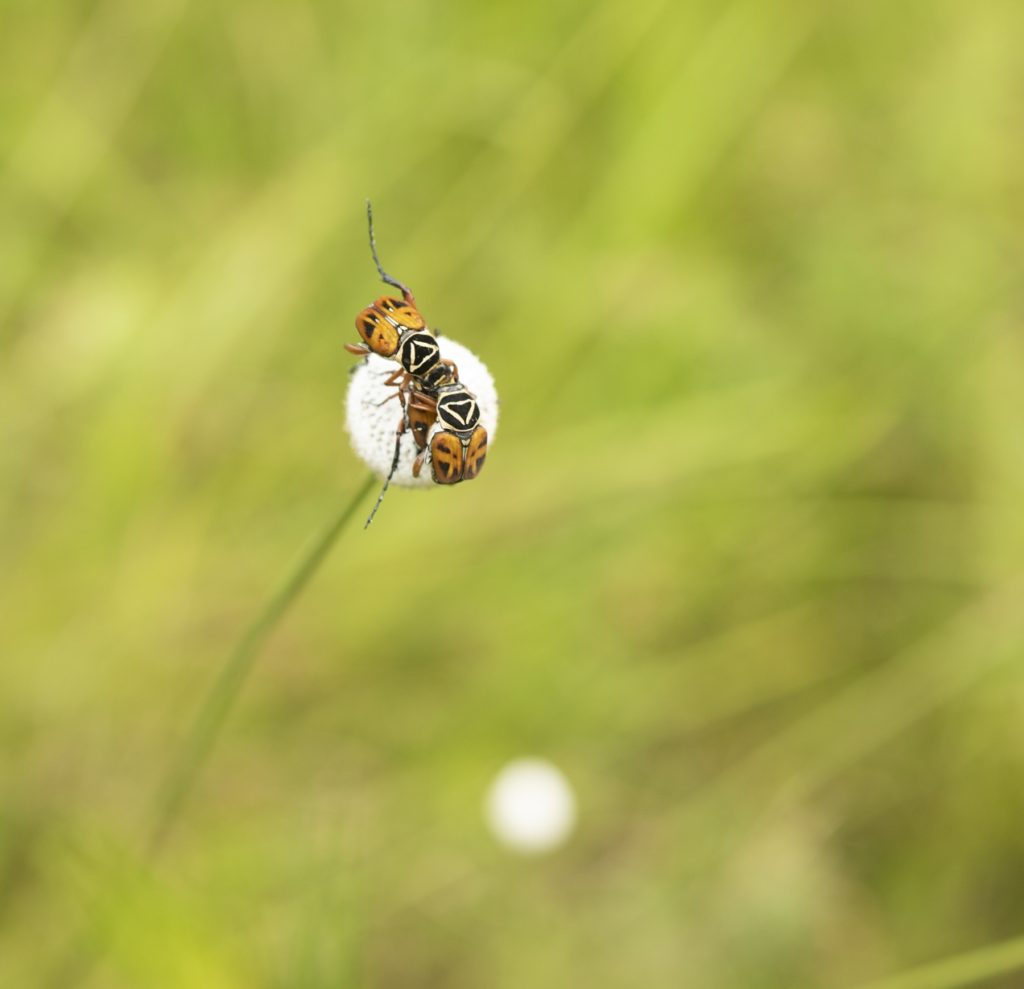
A pair of Delta Flower Scarab beetles, Trigonopeltastes delta, mating on Pipewort in the meadow. Their diet consists mostly of decomposing fruits or pollen.
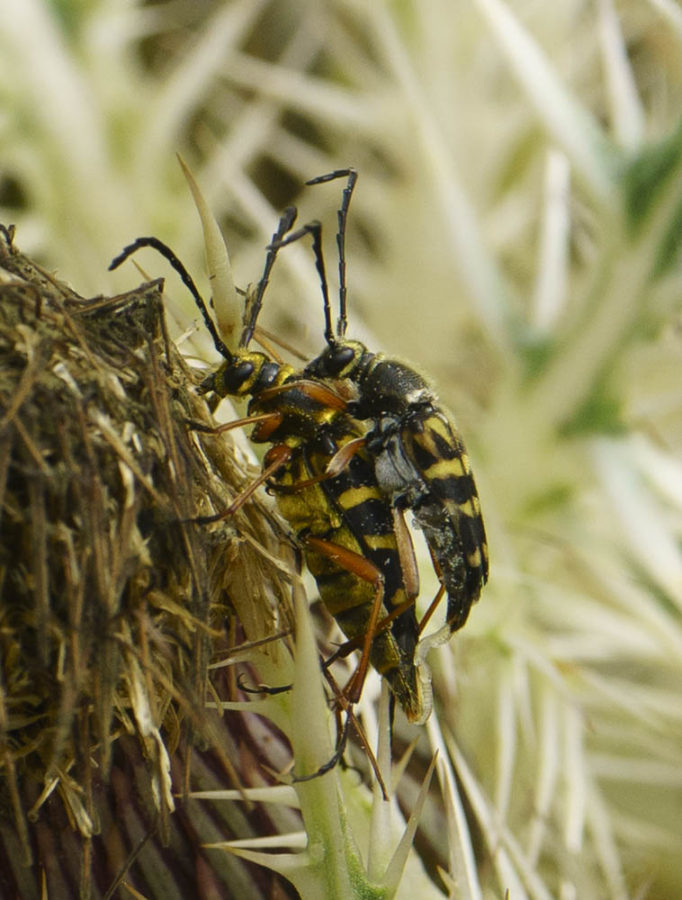
Zebra Longhorn Beetle, Typocerus zebra, a beetle in the Cerambycidae family, mating on a thistle. Adults live and breed on flowers, especially thistles at Vista Farm and larvae develop on decaying pine logs and stumps. The male is dramatically smaller than the female and both have a distinctive yellow and black pattern.
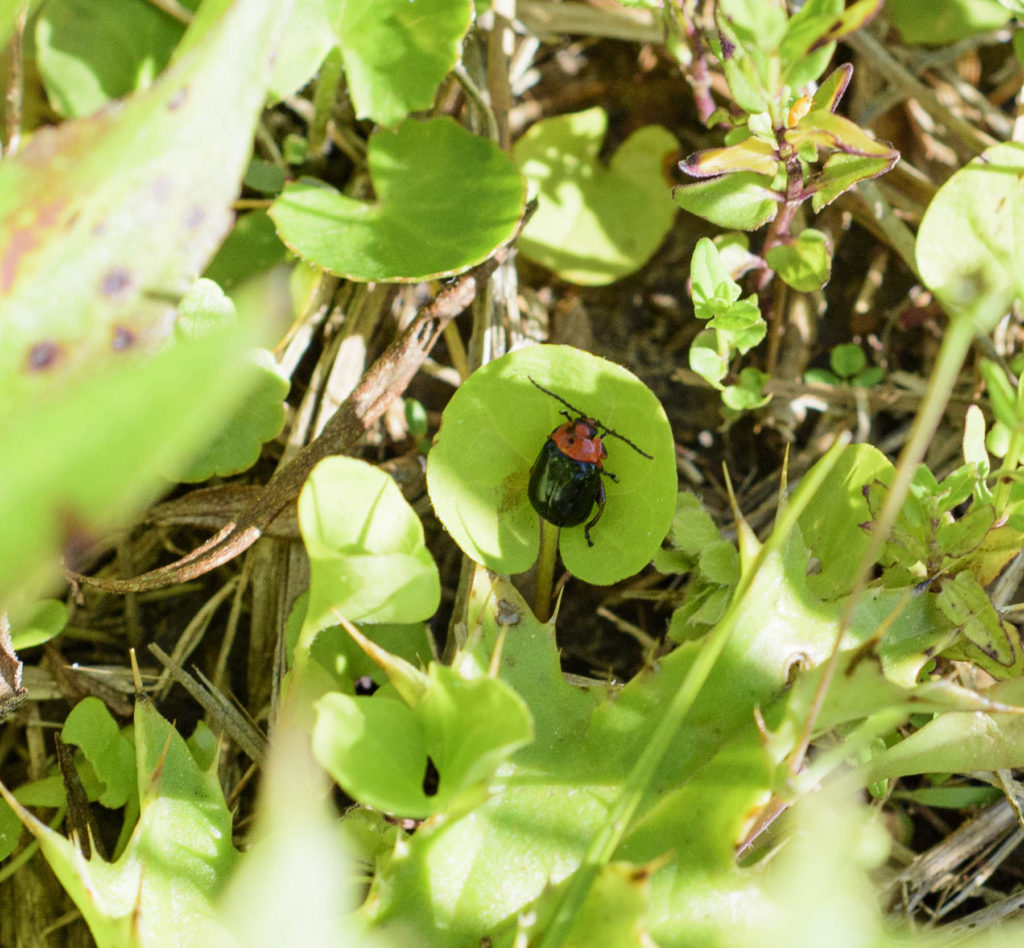
Shiny Flea Beetle in the family Chrysomelidae. It is found in Central America and North America.
Grasshoppers, Crickets and Katydids
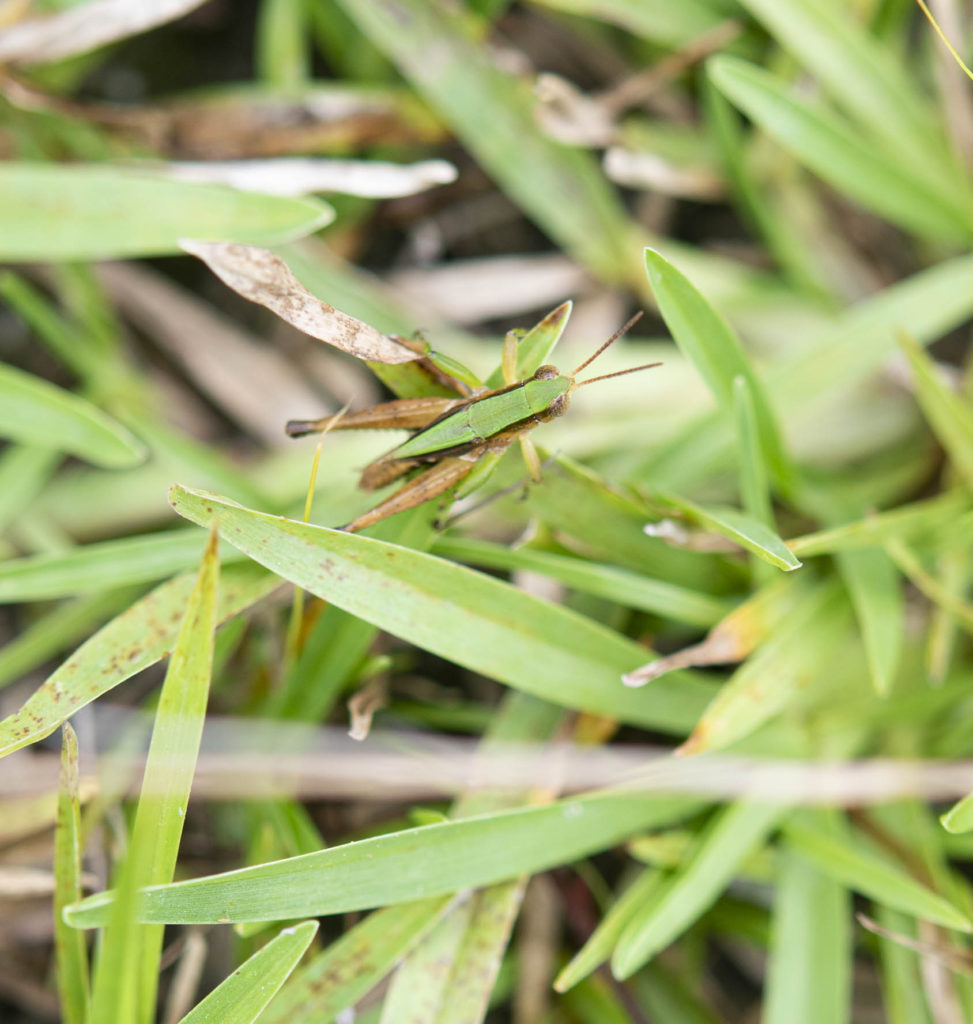
Dichromorpha viridis, the short-winged green grasshopper, is a common species of slant-faced grasshoppers found in North America. This grasshopper, as the common name suggests, is mostly green colored with a face that slants dorsally. The female of the species, however, is typically brown, and usually much larger than the male. Wikipedia
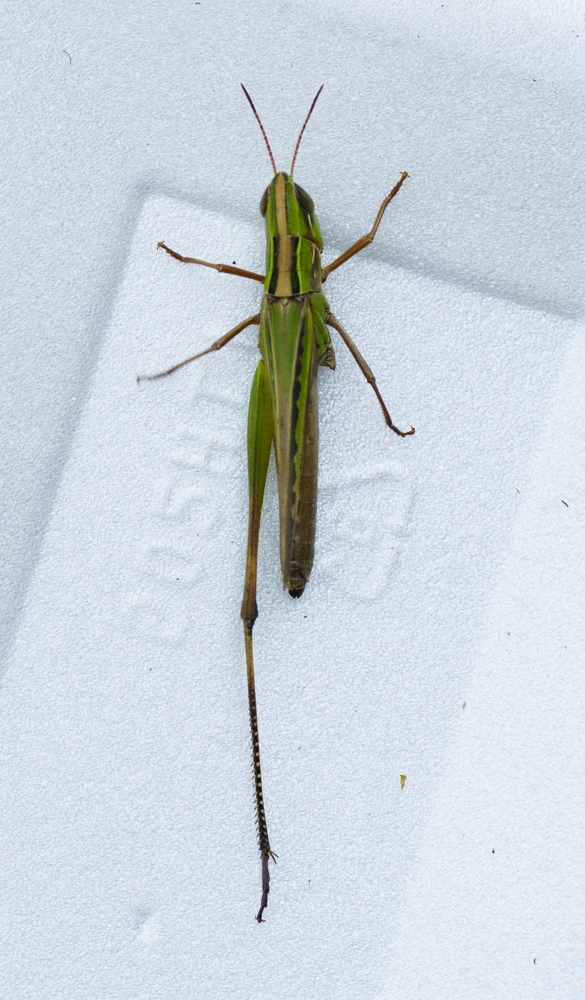
Admirable grasshopper, Syrbula admirabilis has a very slanted face with very long back legs. They are widely distributed across North America, feeding on a variety of grasses.
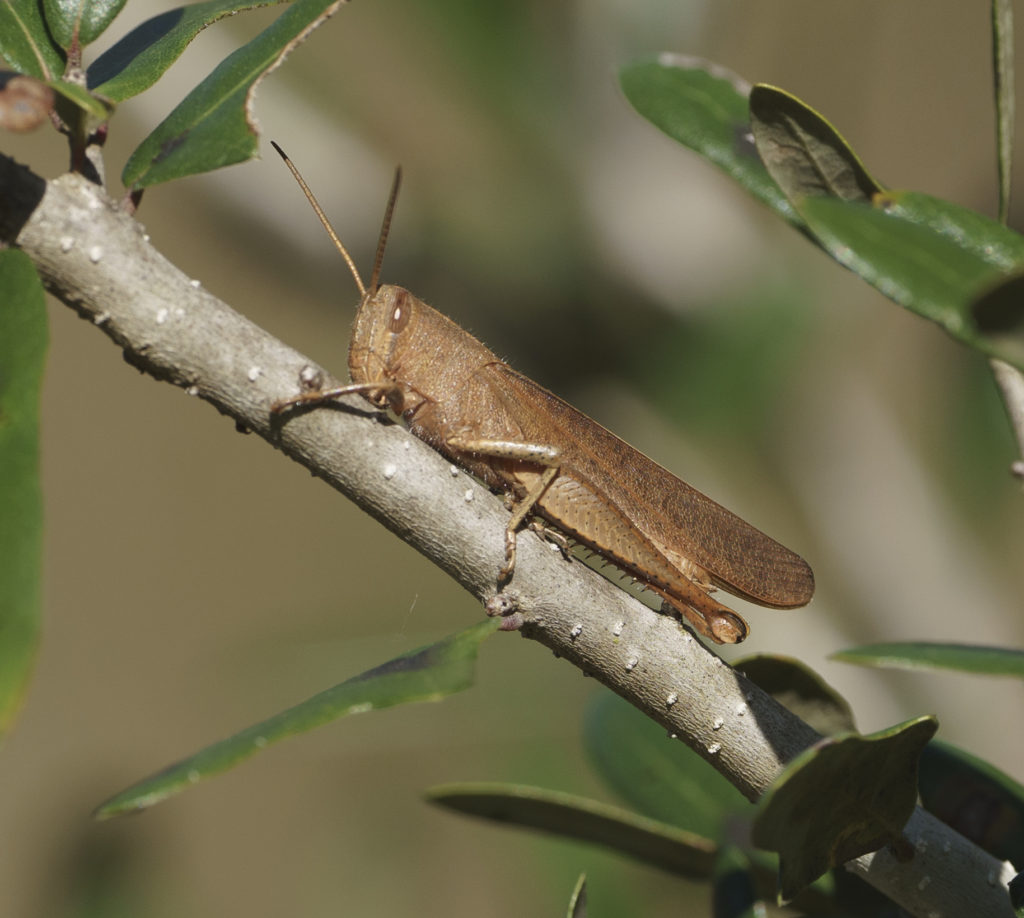
A large brown Mischievous Bird Grasshopper, Schistocerca damnifica, sunning on a live oak twig in the meadow on a fall afternoon.
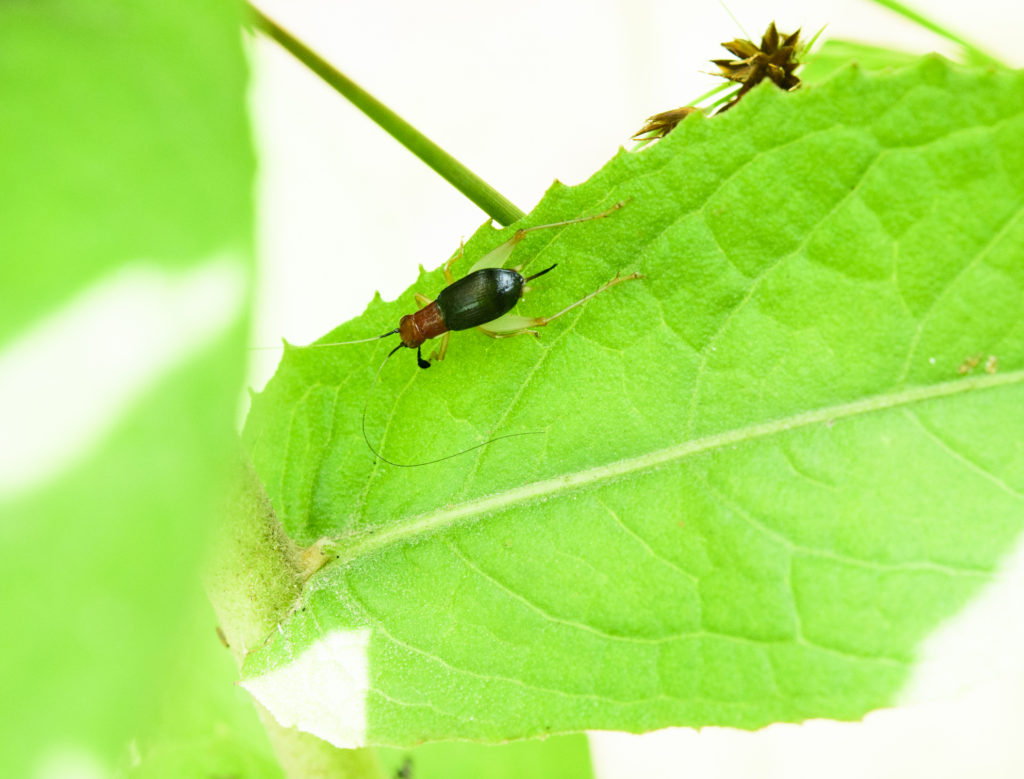
Red-headed Bush Cricket, Phyllopalpus pulchellus, a tiny little bug living among the vines and iris in the wetland.
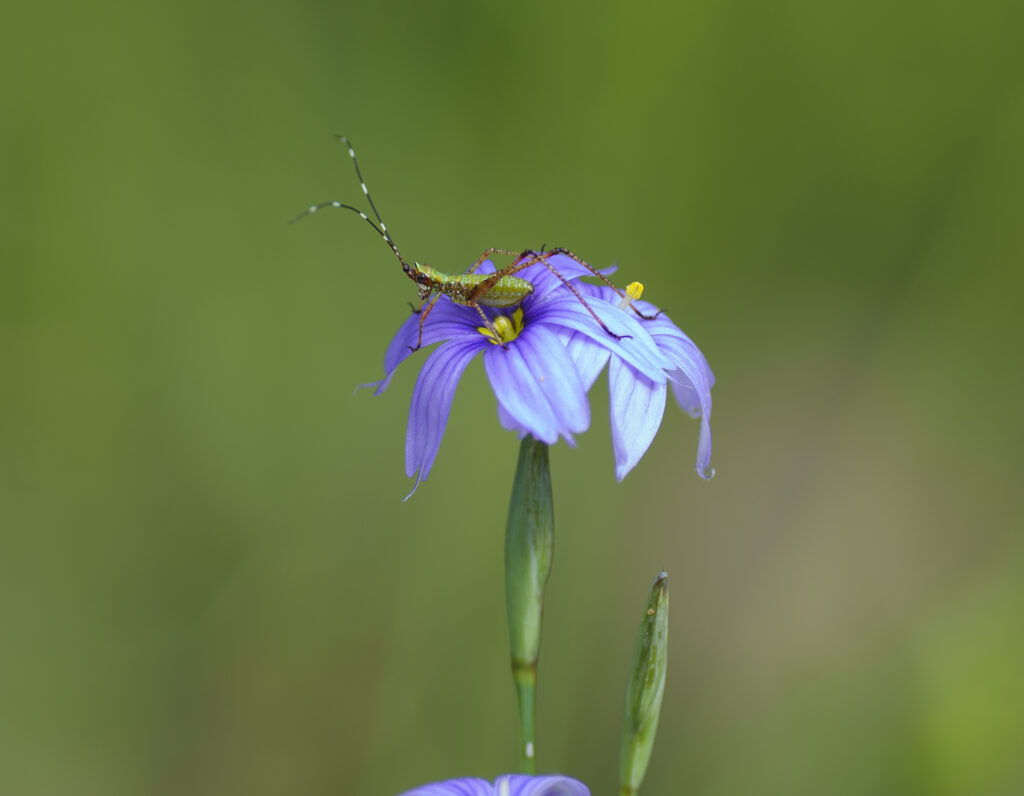
Fork-tailed Bush Katydid, Scudderia furcata, nymph 2nd instar. The fork-tailed bush katydid is one of about 250 species of katydids, also called long-horned meadow grasshoppers (family Tettigoniidae), found in the US north of Mexico. They all have very long antennae, and many resemble green leaves when adult.
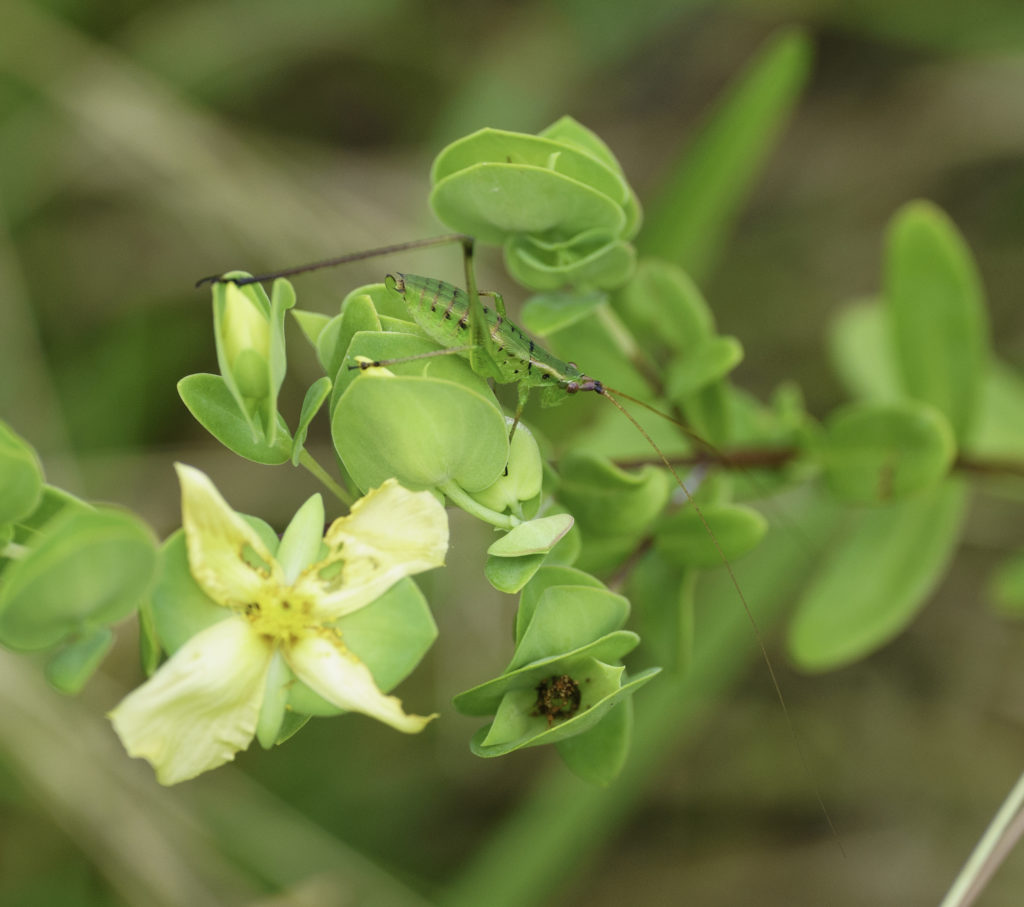
One of several green katydids observed in the meadow, species unknown. This one is camouflaged on St. Peter’s-Wort. See the eggs of an also unknown insect.
Flies
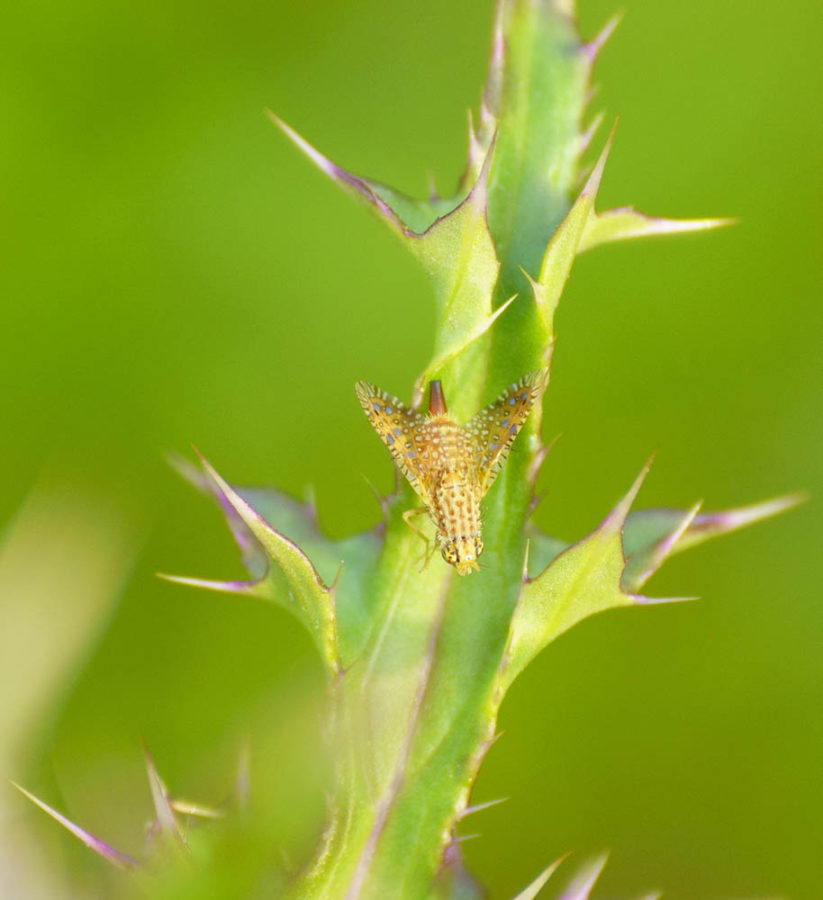
Female Paracanthus culta is a fruit fly in the Tephritidaefamily. Their larvae develop within the flowerheads of thistles (Cirsium spp.), eating the immature thistle seeds. Males and females usually court on their food plants. Female tephritid fruit flies have a pointed, conical oviscape, which is a hard protective sheath covering the needle-like ovipositor, which they use to insert eggs into the living tissues of plants.
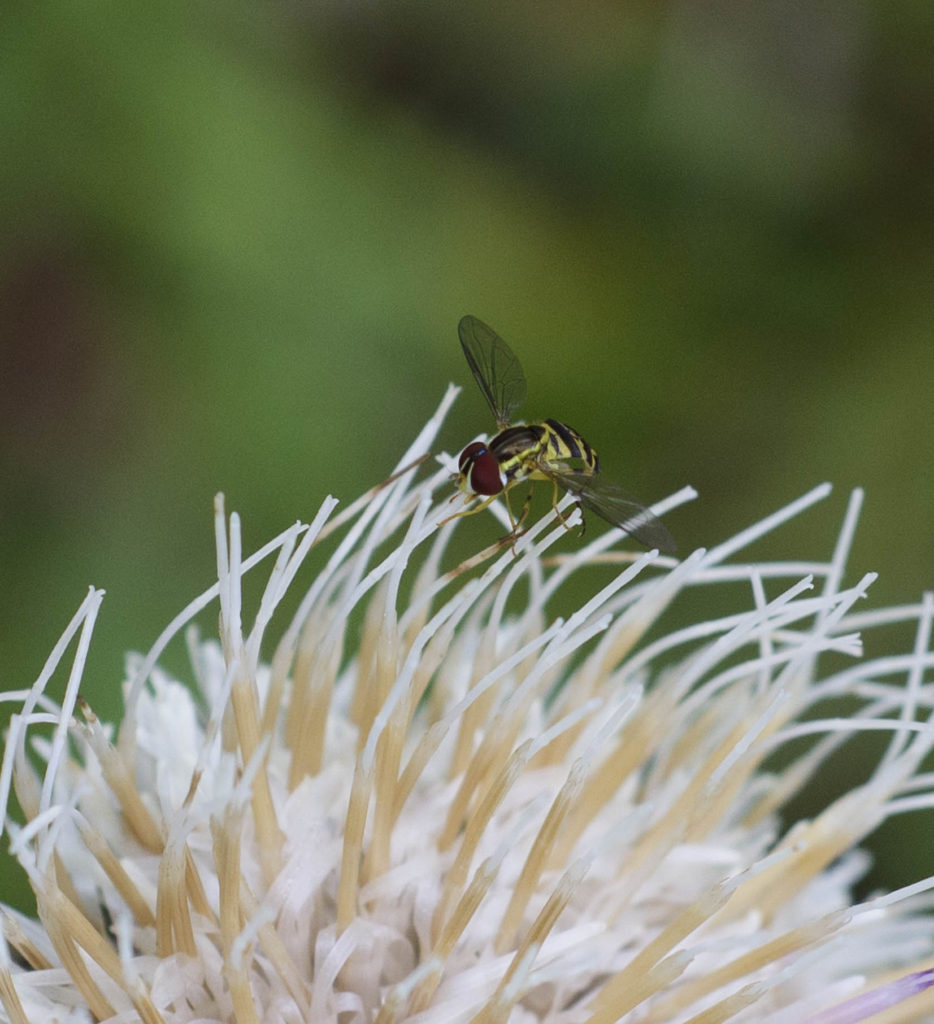
Eastern Calligrapher Toxomerus geminatus, a very tiny hover fly sitting on a thistle flower. Adults feed on aphids and mites in forests, meadows, fields, savannas, marshes, and bogs and lay their eggs nearby. Source: Wikipedia
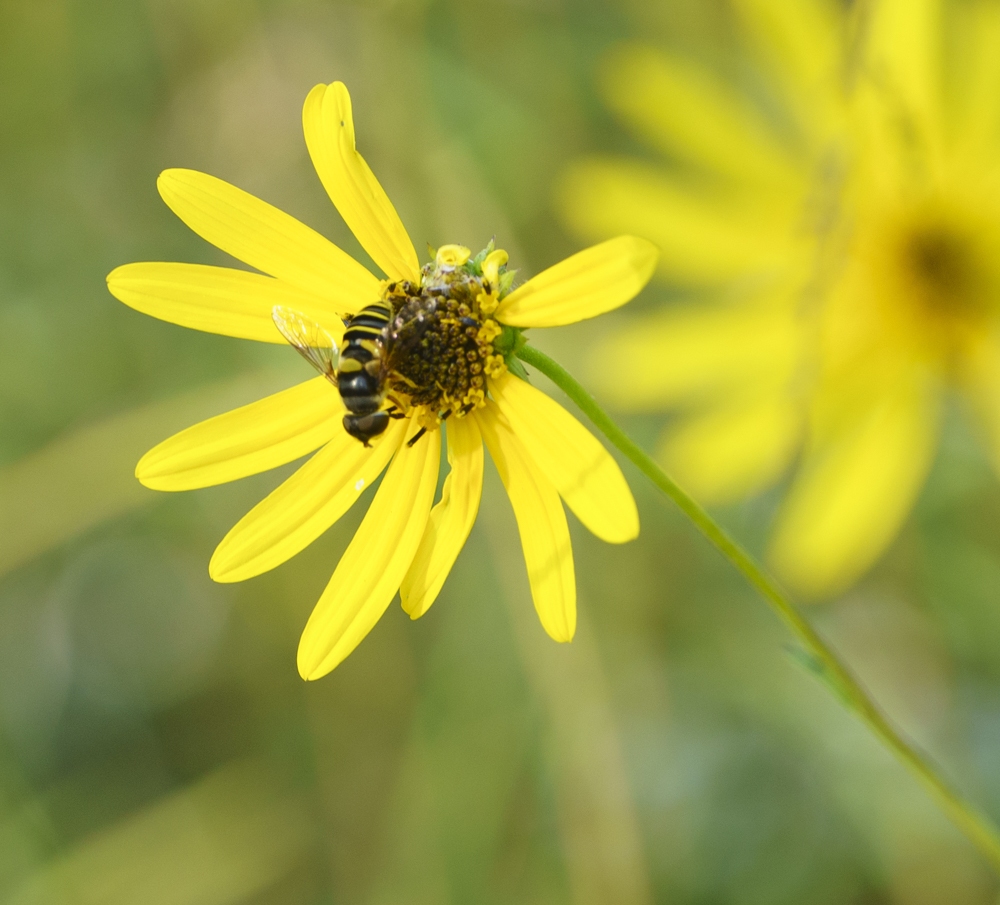
Transverse-banded Flower Fly, Eristalis transversa, is a type of hover fly. Hoverflies get their names from their ability to remain nearly motionless while in flight. They are valuabe pollinators. They range from East of the Mississipi River to Canada.
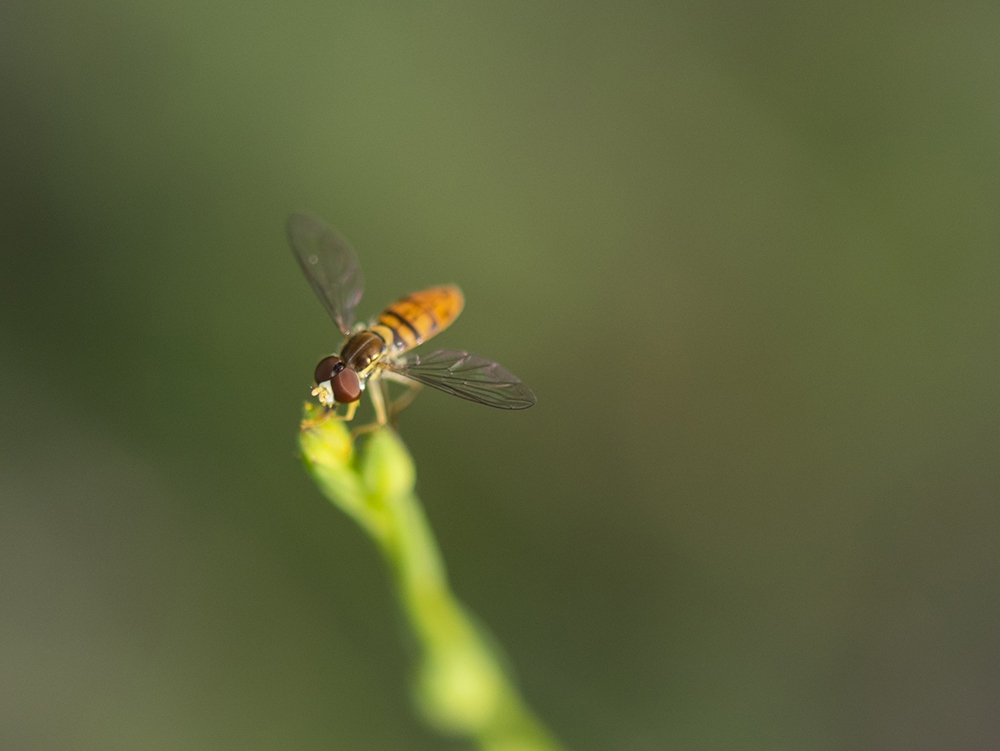
Margined Calligrapher Fly, Toxomerus marginatus, is a small hover fly and a pollinator. The larvae eat aphids, small caterpillars and other very small insects.
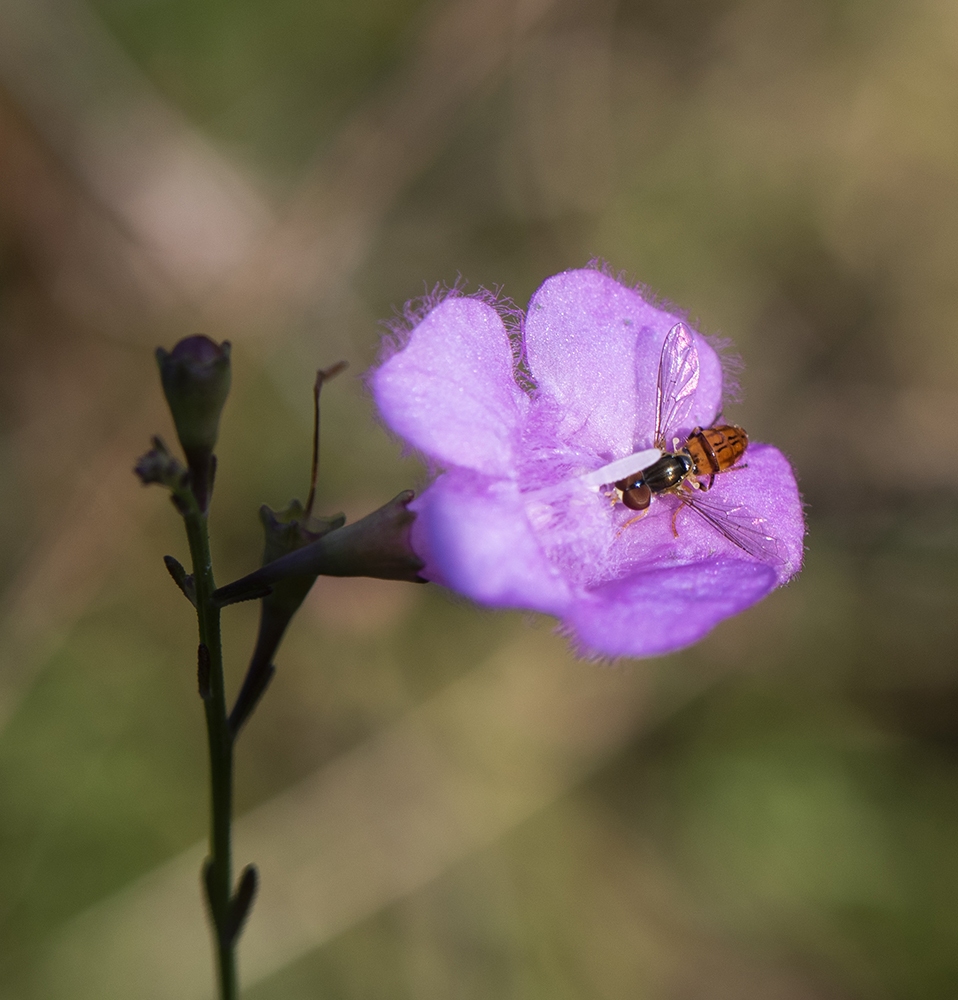
Thin-lined Calligrapher Fly, Toxomerus boscii, is a common species of hoverfly whose larvae are predators of thrips, aphids, and small caterpillars.
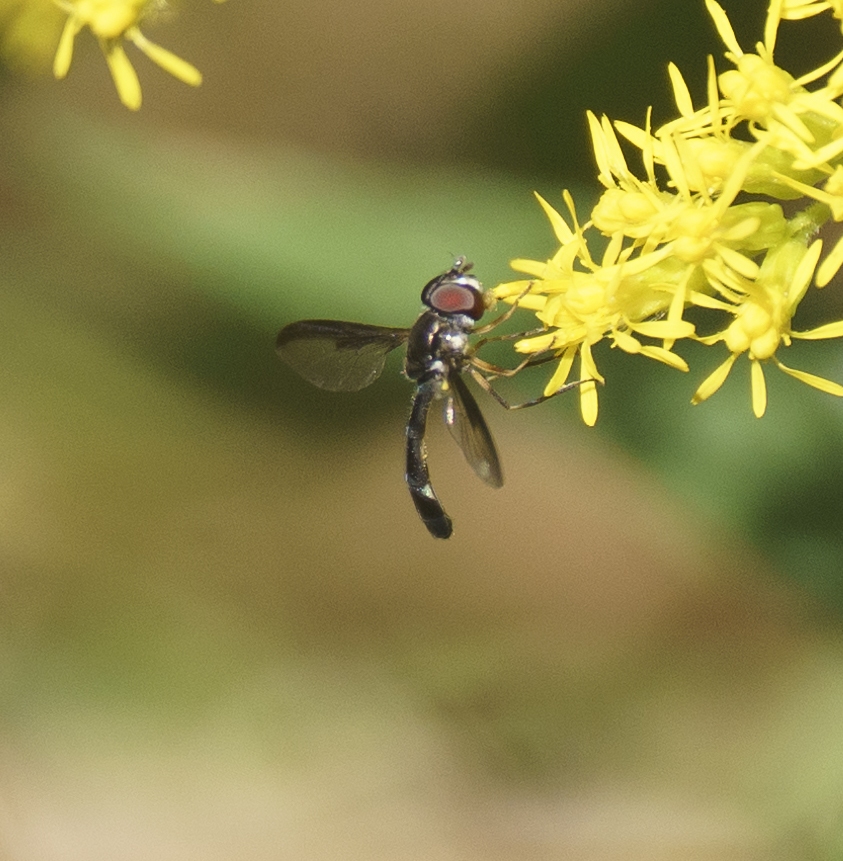
The Cobalt Hover Fly, Pelecinobaccha costata, is in the family Syrphidae. It is distributed from southern Ontario and the eastern United States, but out of 53 species, only one is found north of Mexico. The larvae are predators of scale insects and perhaps aphids. The head is large with hairless eyes. (Minnesota Seasons.com)
Leaf Hoppers
Aphids, Leaf-footed Bugs, Assassin Bugs, etc.
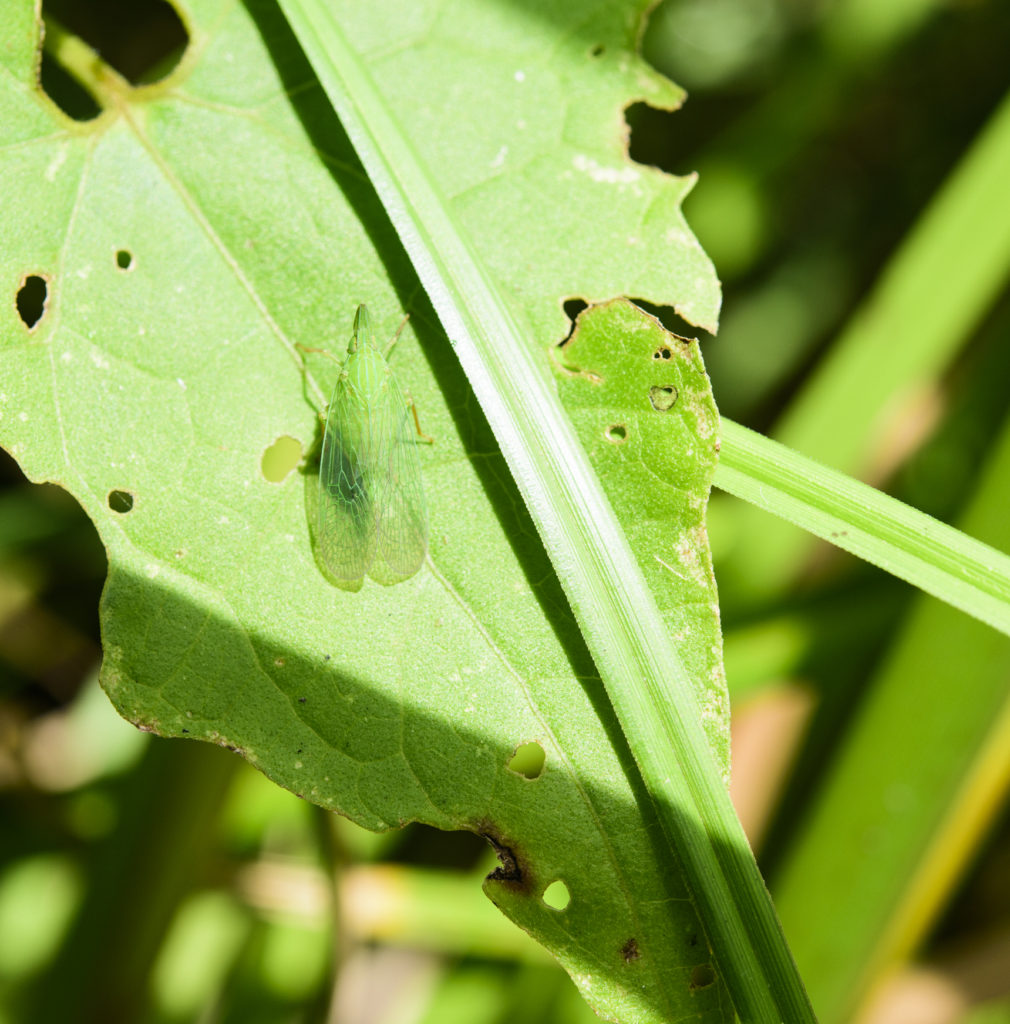
Rhynchomitra microrhina, a planthopper is perfectly camouflaged on a green leaf in the wetland at Vista Farm.
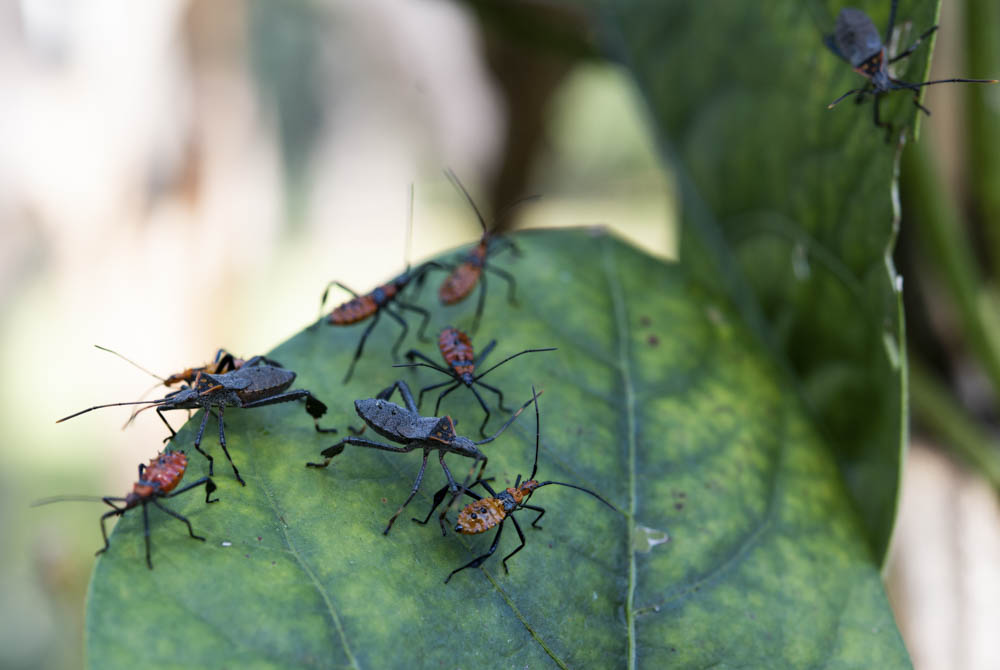
Eastern Leaf-footed Bug, Leptoglossus phyllopus, on a leaf in the vegetable garden at Vista Farm. Nymphs. Adult here.
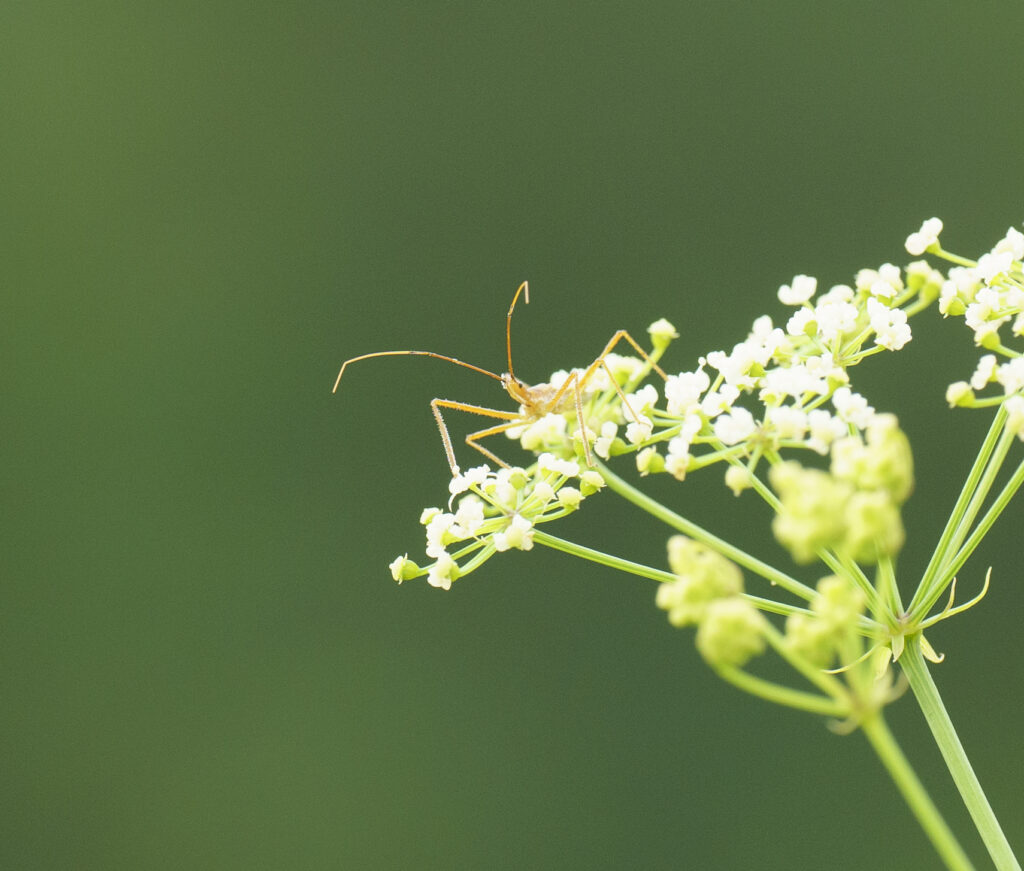
Assassin Bug, Zelus cervicalis, is a predator that use its long beak-like snout to inject a lethal saliva that liquefies the insides of their prey, which are then sucked out. The saliva contains enzymes that digest the tissues they swallow. The saliva is commonly effective at killing prey substantially larger than the bug itself.
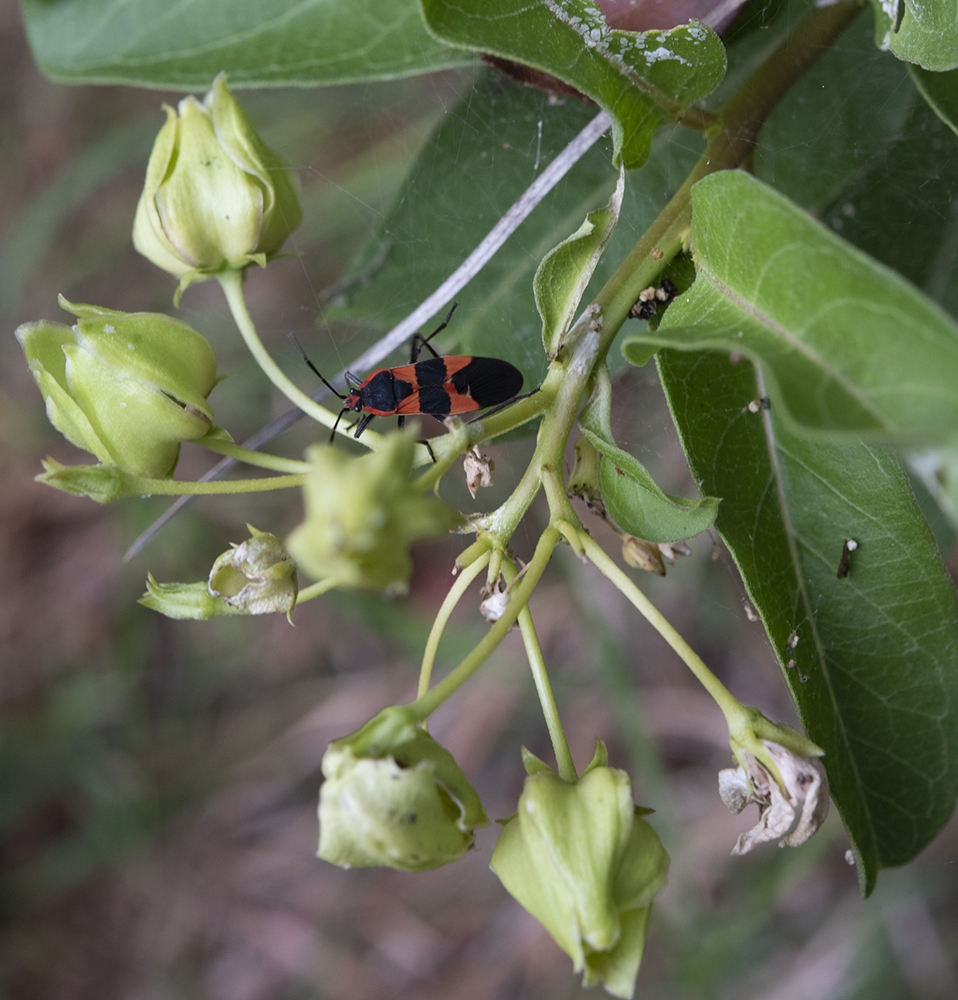
Large Milkweed Bug, Oncopeltus fasciatus, orange and black and climbing on a milkweed.
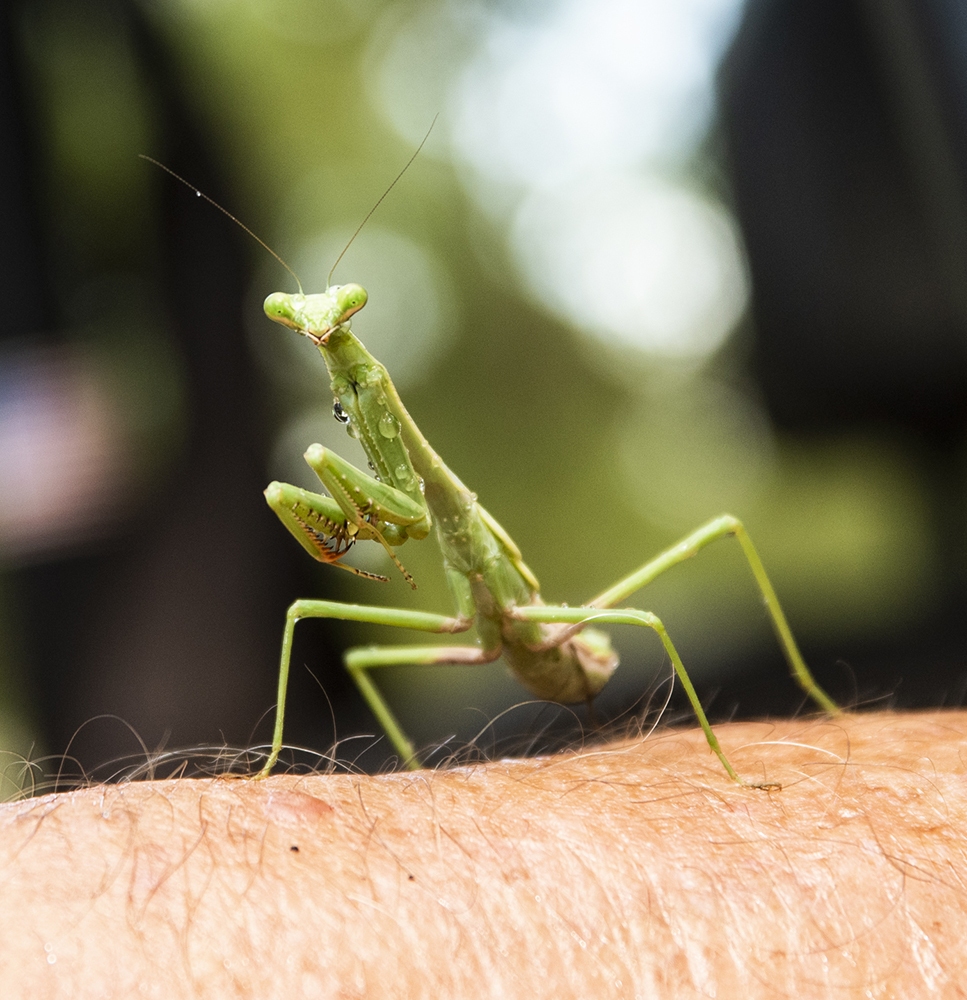
Carolina Mantis, Stagmomantis carolina. The chrysalis of an unknown species of Mantid, Family Mantidae, on a water oak twig. Probably Carolina Mantis, as several of these have been observed at Vista Farm.

Cicada, superfamily Cicadoidea, probably Megatibicen resh. Resh Cicada, is named such because the markings on its back resemble the Hebrew symbol Resh “ר”. The Resh Cicada has been identified in Arkansas, Kansas, Louisiana, Mississippi, Nebraska, Oklahoma, South Carolina, Tennessee, and Texas. Often their singing can be heard in the evening and their shed exoskeleton found clinging to tree bark in the morning. They eat various kinds of tree/shrub sap.
Recent Posts
Archives
Categories
- Advice
- Animals
- Biodiversity
- Bird Migration
- Birds
- Butterflies
- Carbon
- Climate
- composting
- Ecology
- Ecosystem
- Environment
- Fishing pier
- Floating boat dock
- Gardening
- Grasses
- Habitat
- Health
- Insects
- Muscovy
- Muscovy Duck
- Native Lousiana Species
- Native Wildflowers
- NRCS
- Nutrition
- Plants
- Pollinators
- Recycle
- Travel and Tourism
- Trees
- Uncategorized
- Video
- Weather
- Wildflowers
- Wildlife
Most Commented Posts
- The Ecosystems at Vista Farm, a Small-Wildlife Habitat By Judy Darby on August 8, 2019 0
- Dirt and Germs! By Judy Darby on August 12, 2019 0
- Vista Farm, A 30-acre Protected Flatwood By Judy Darby on August 13, 2019 0
Recent Comments
Most Liked Posts
- Loblolly or Slash–Which Pine Is It? By Judy Darby on September 7, 2019 10
- Native Louisiana Plants at Vista Farm By Judy Darby on June 8, 2020 2
- How To Set up A Wood Duck Nest Box By Judy Darby on March 8, 2021 2

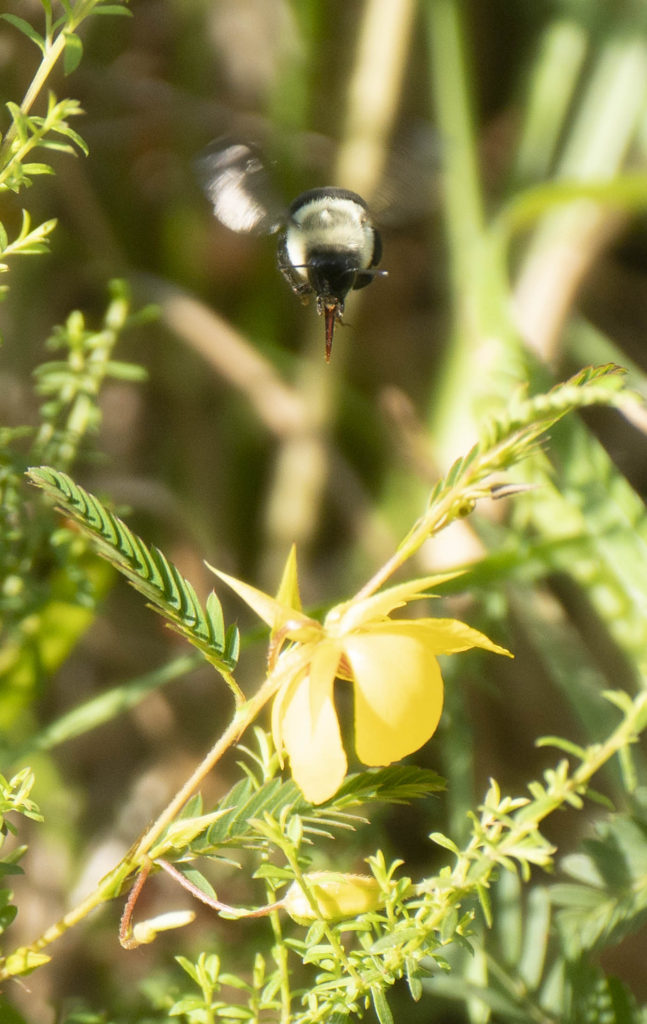
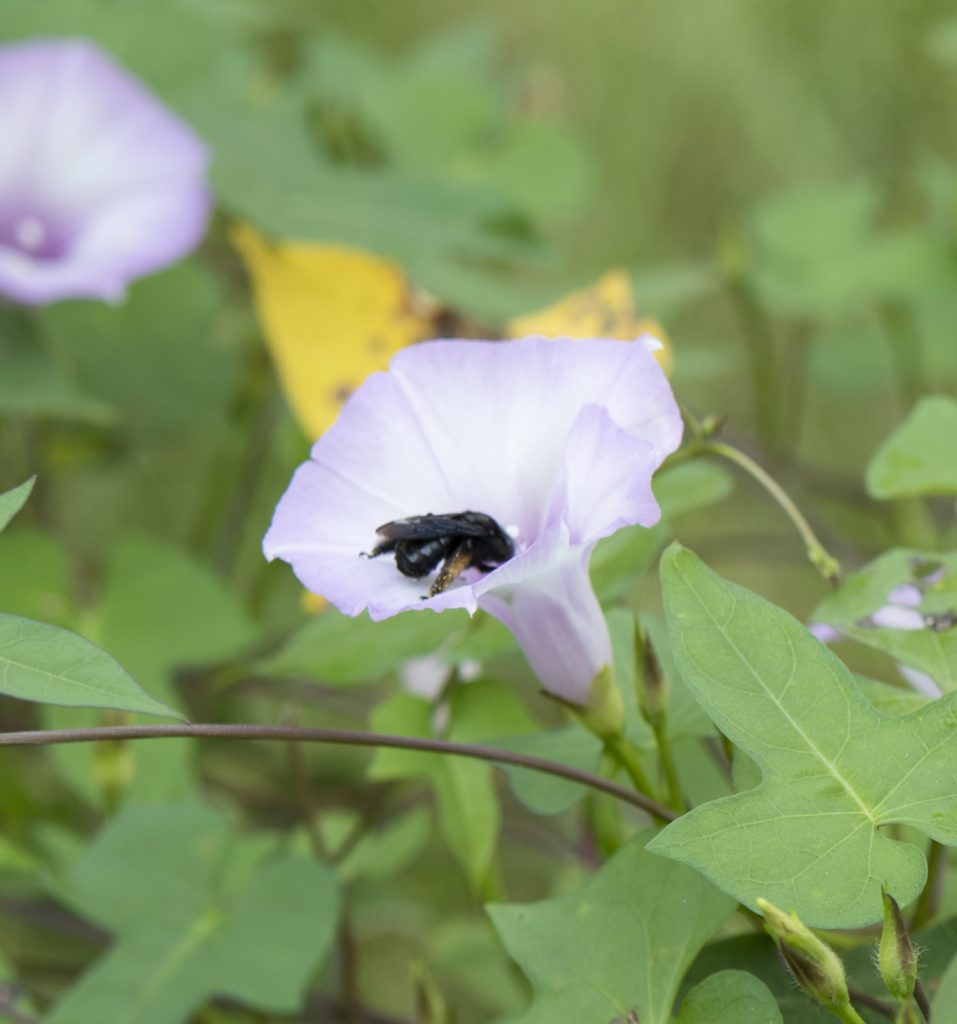
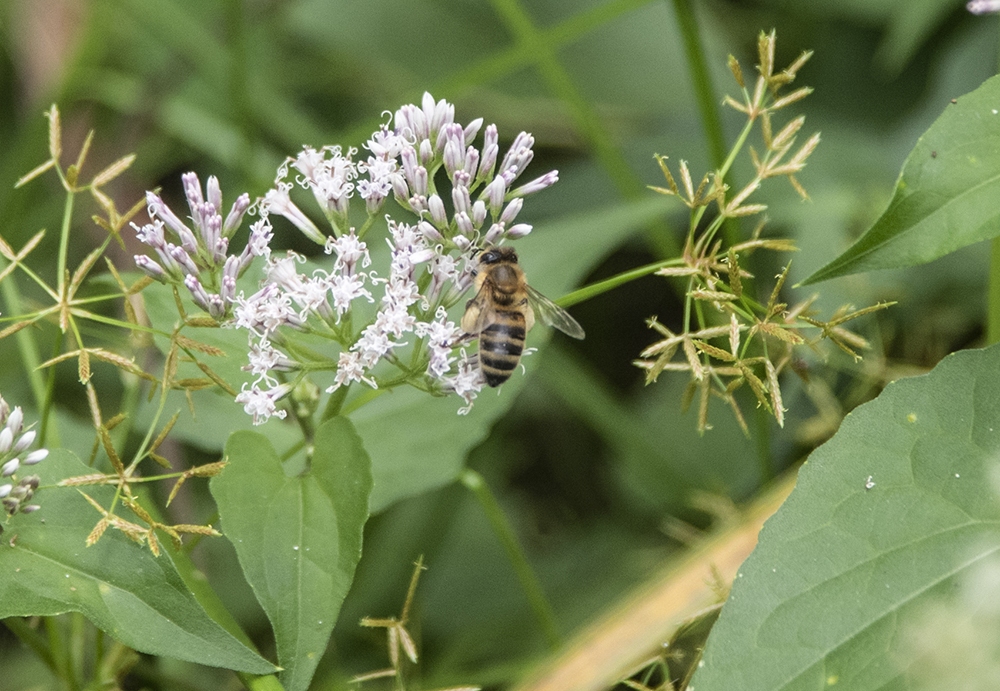
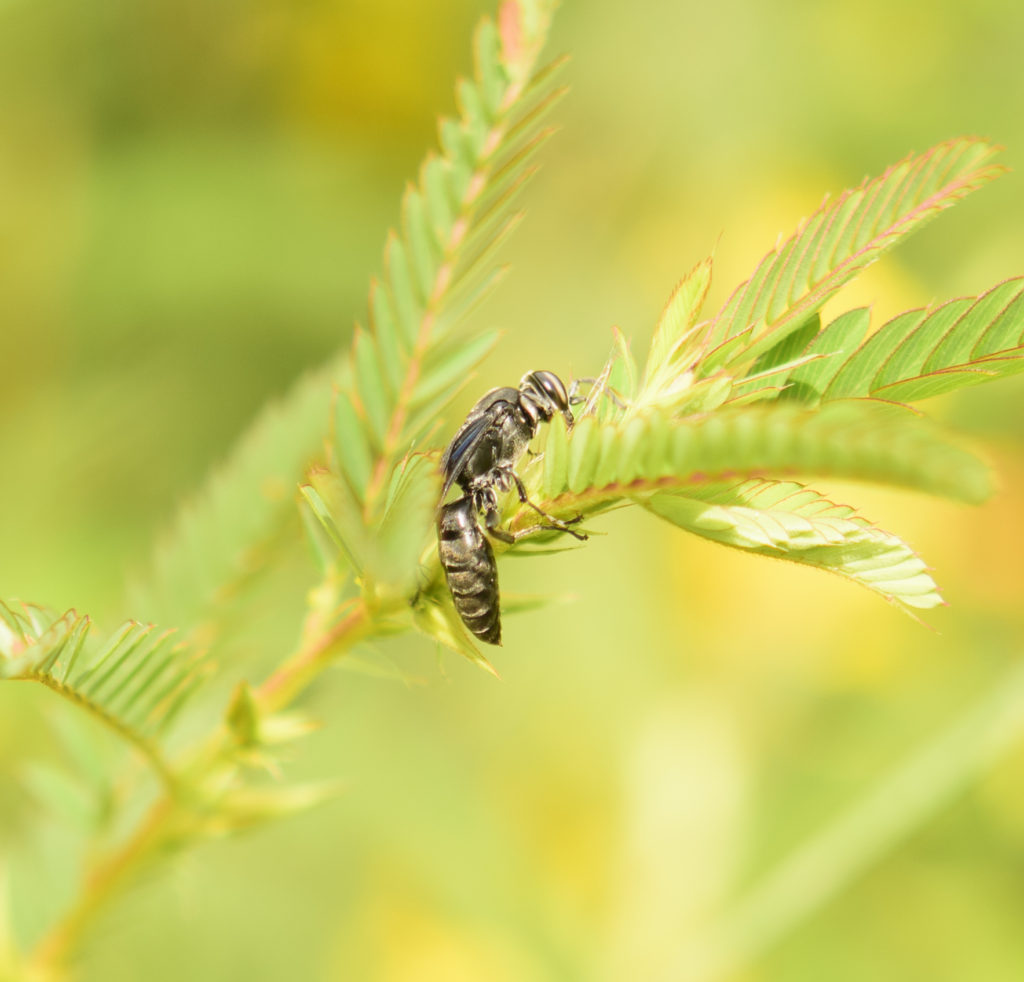
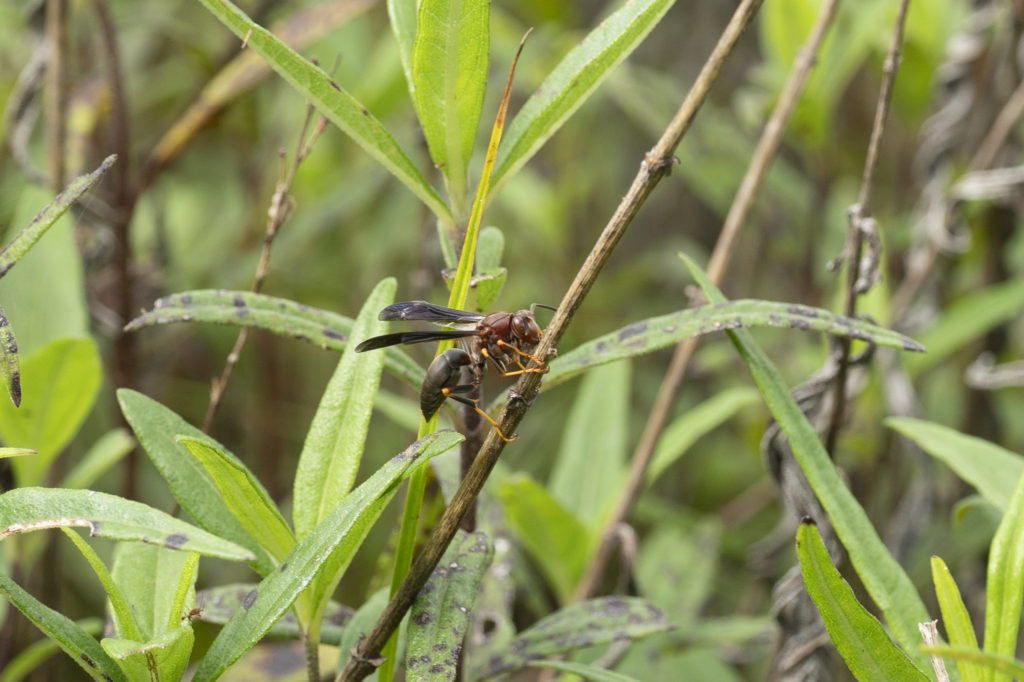
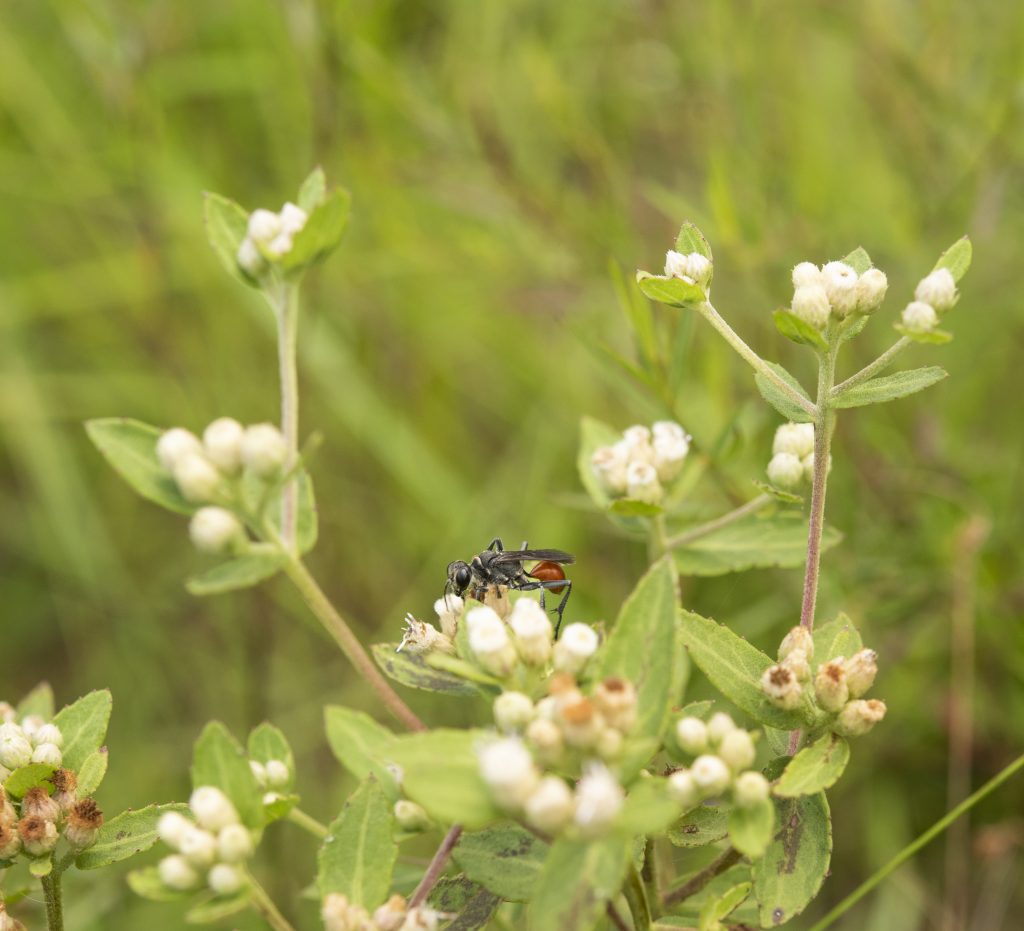
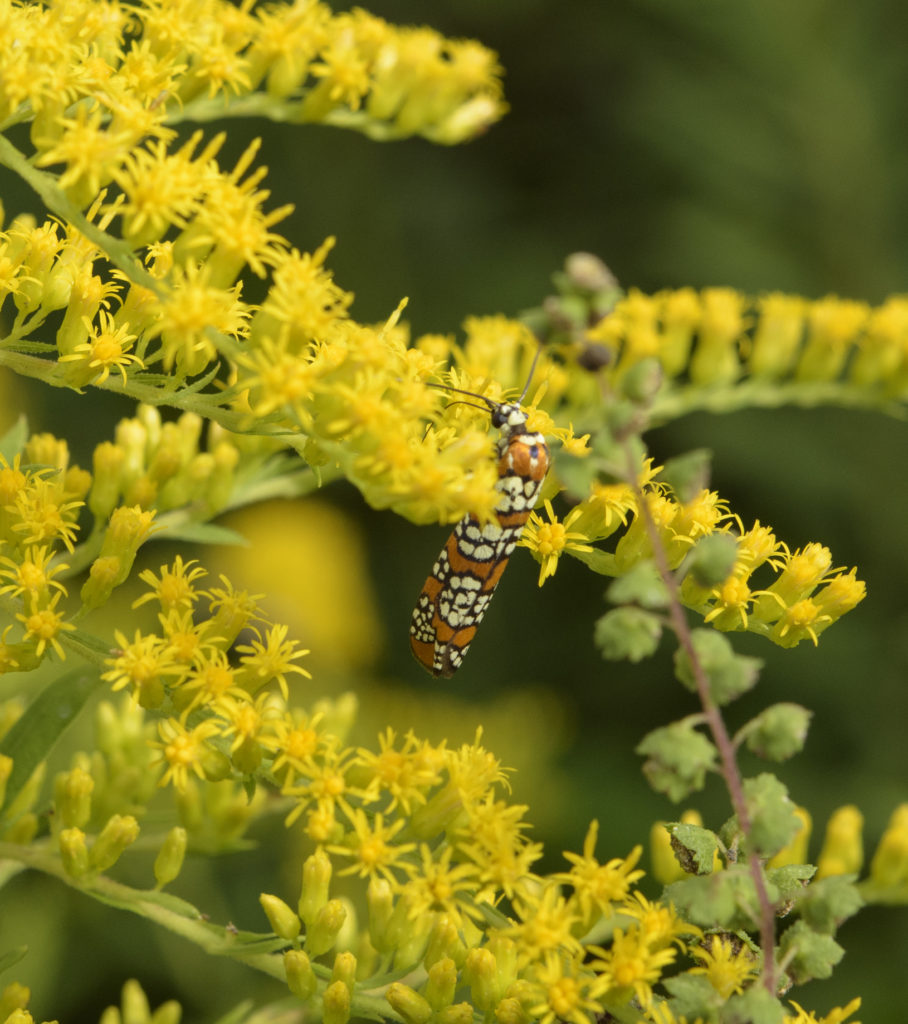

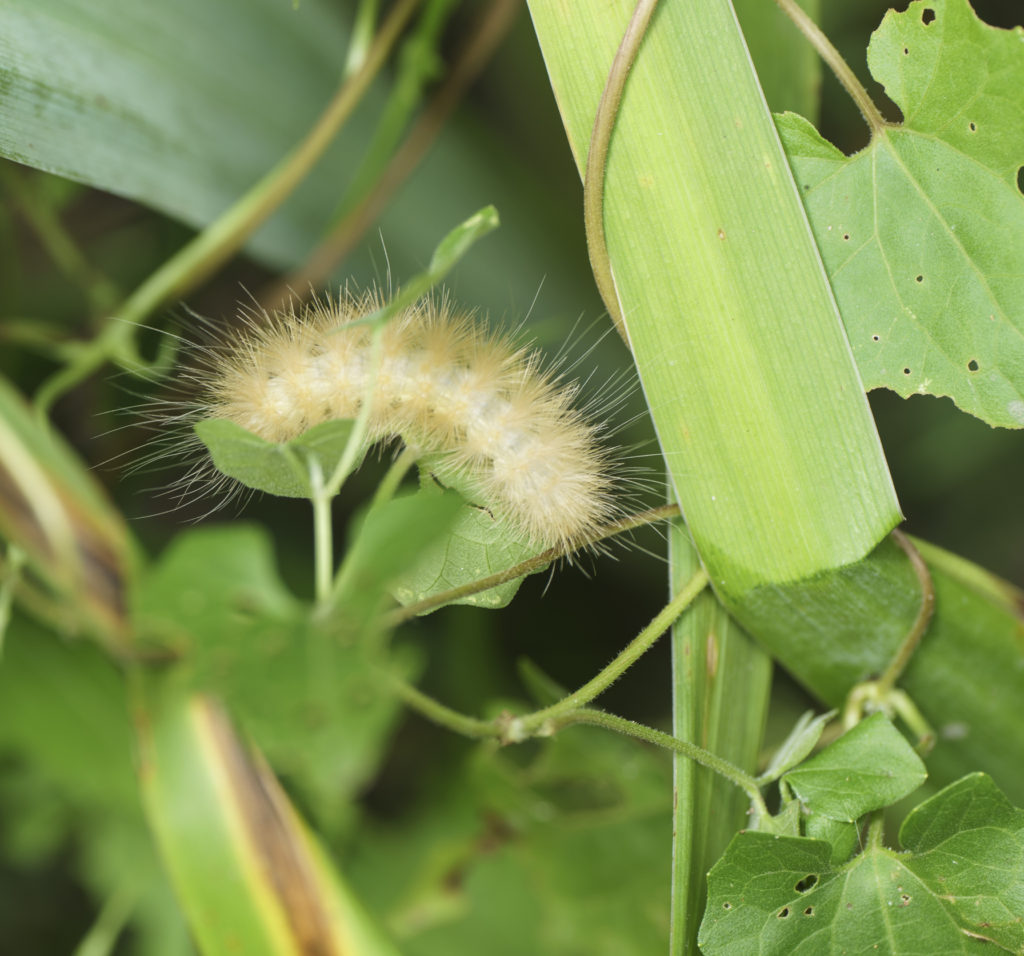
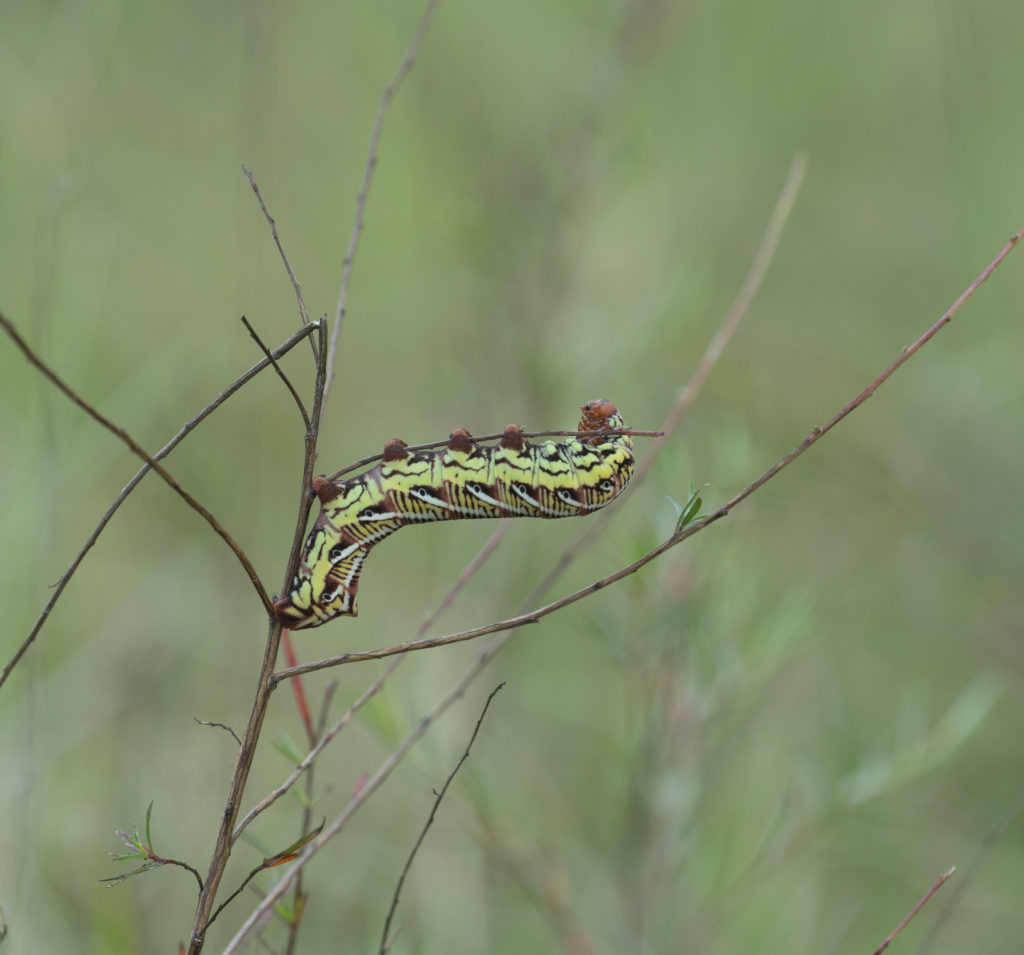
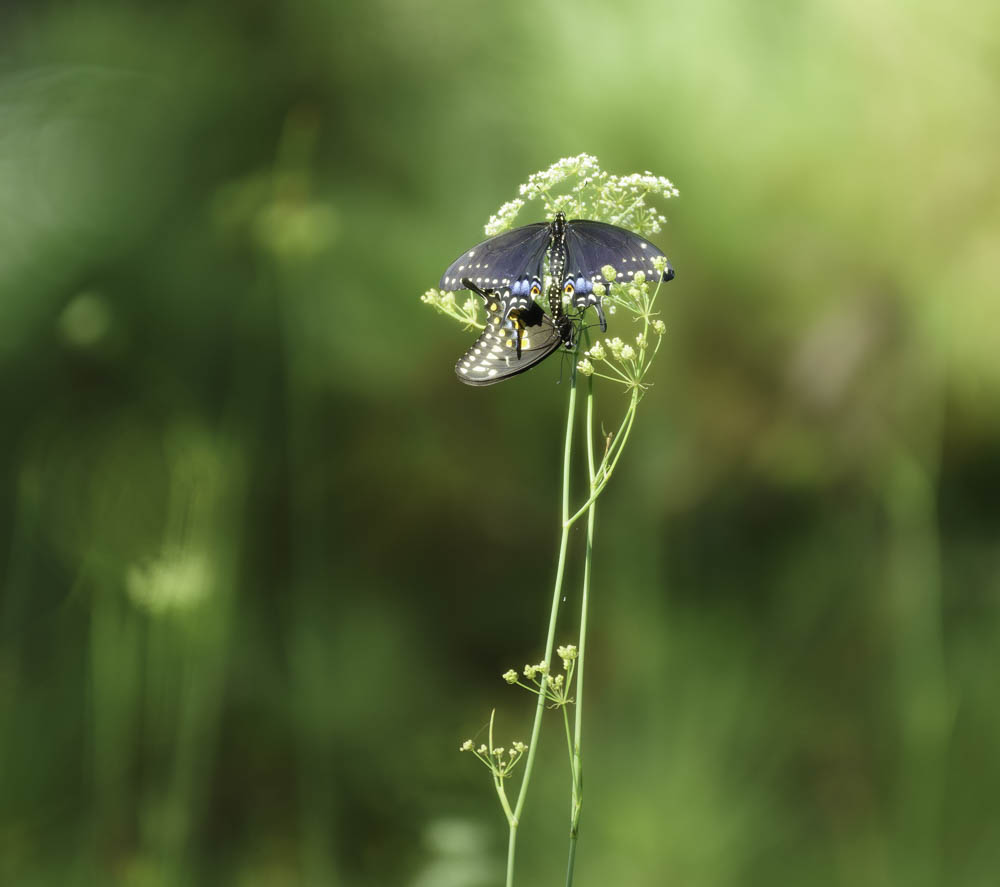
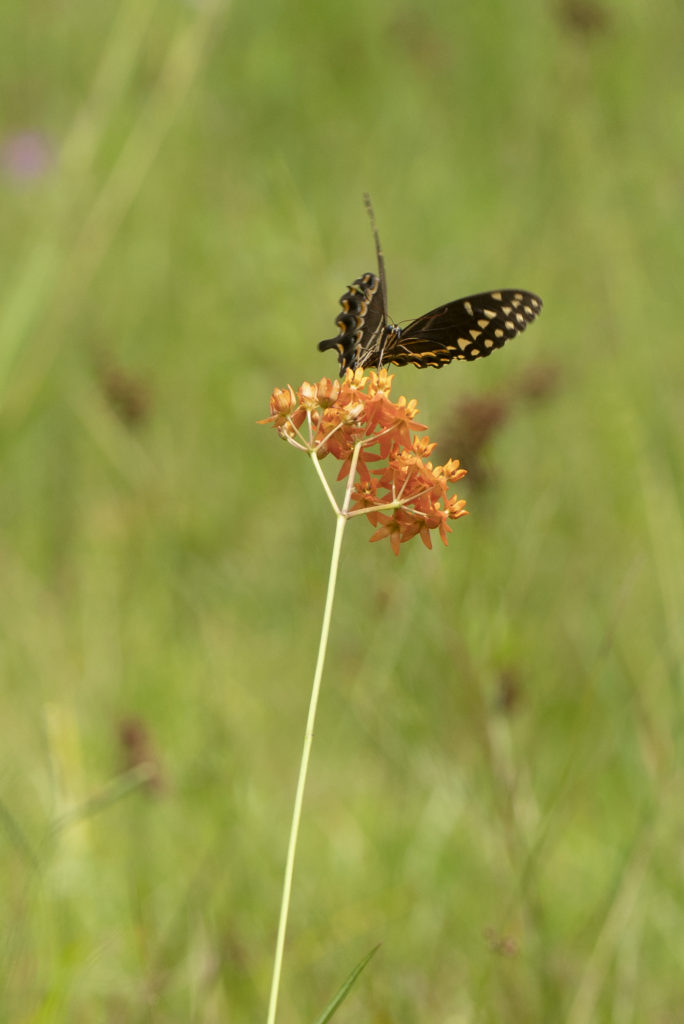
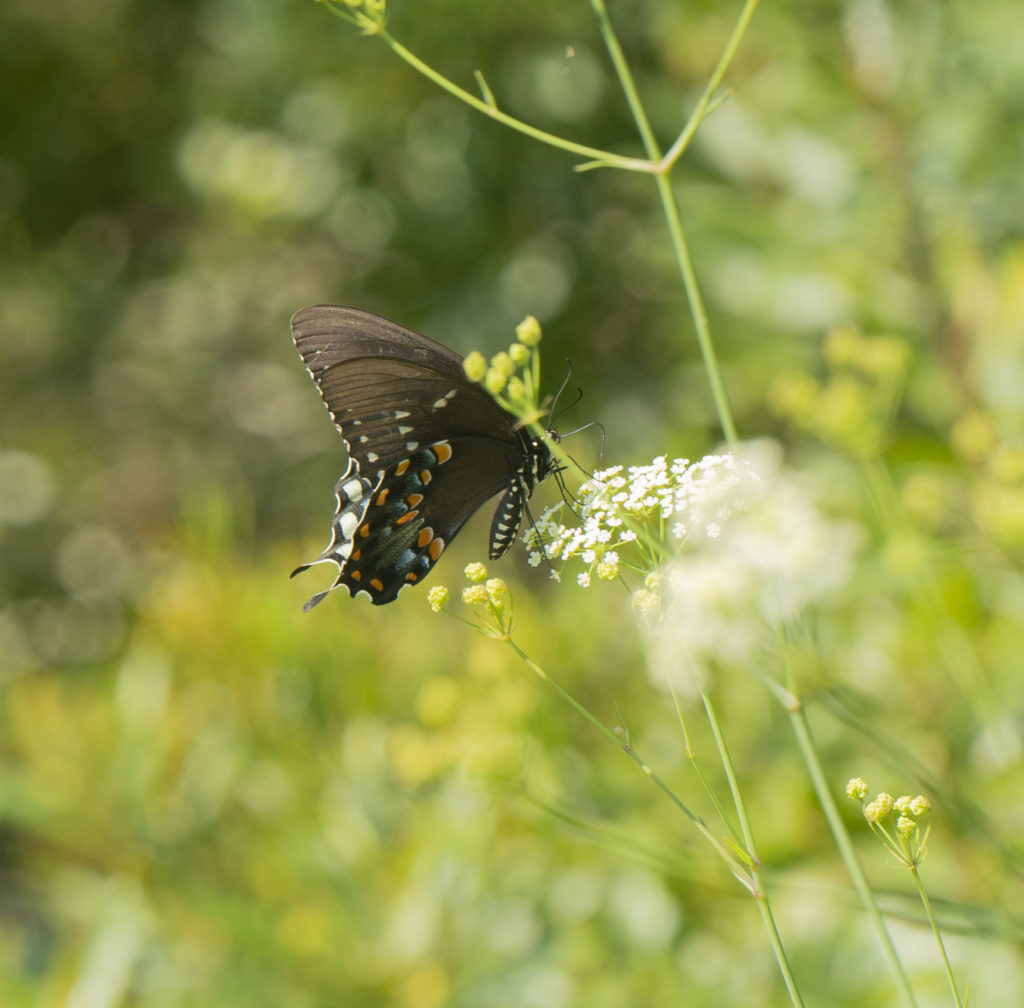
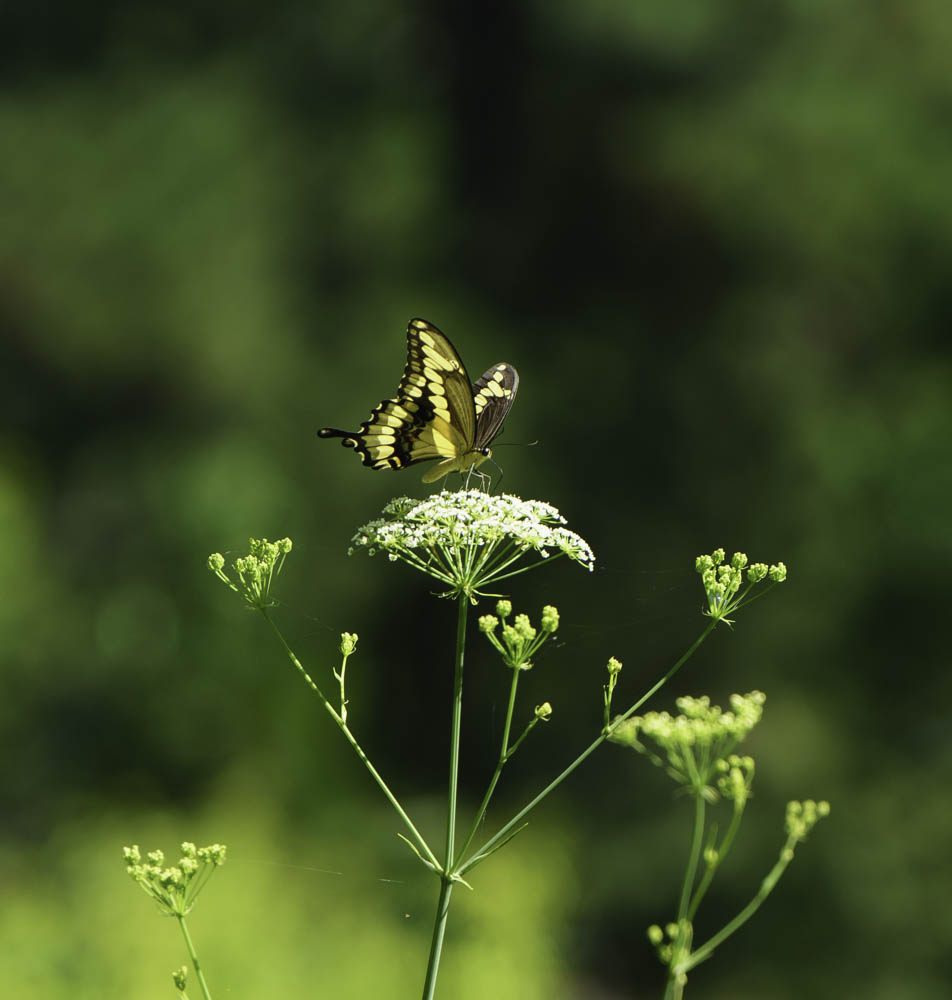
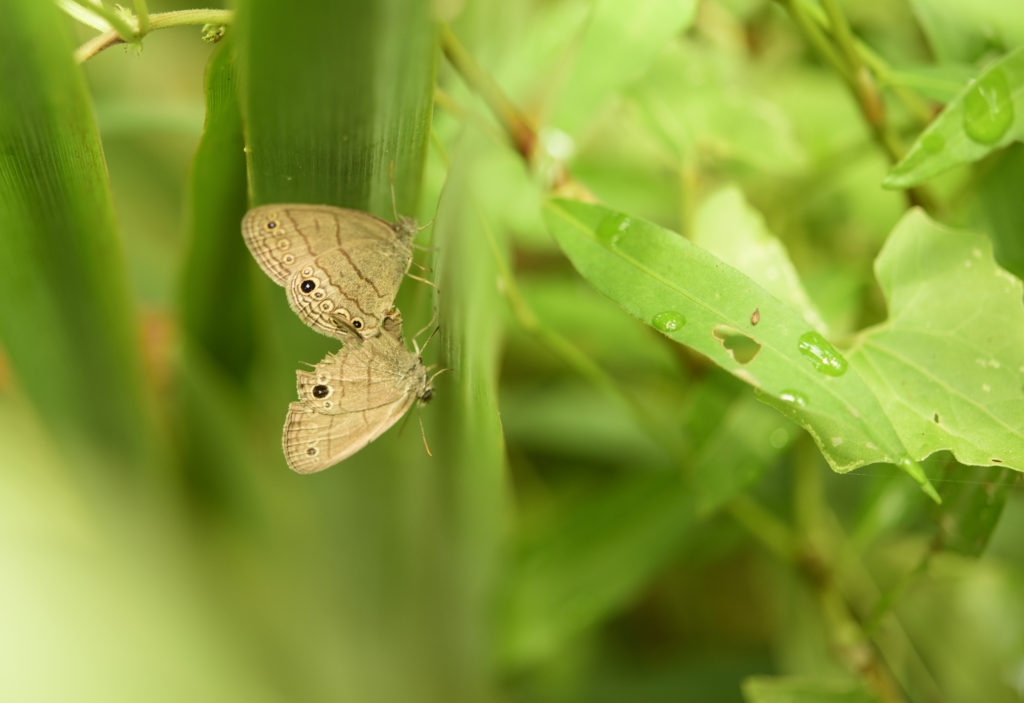
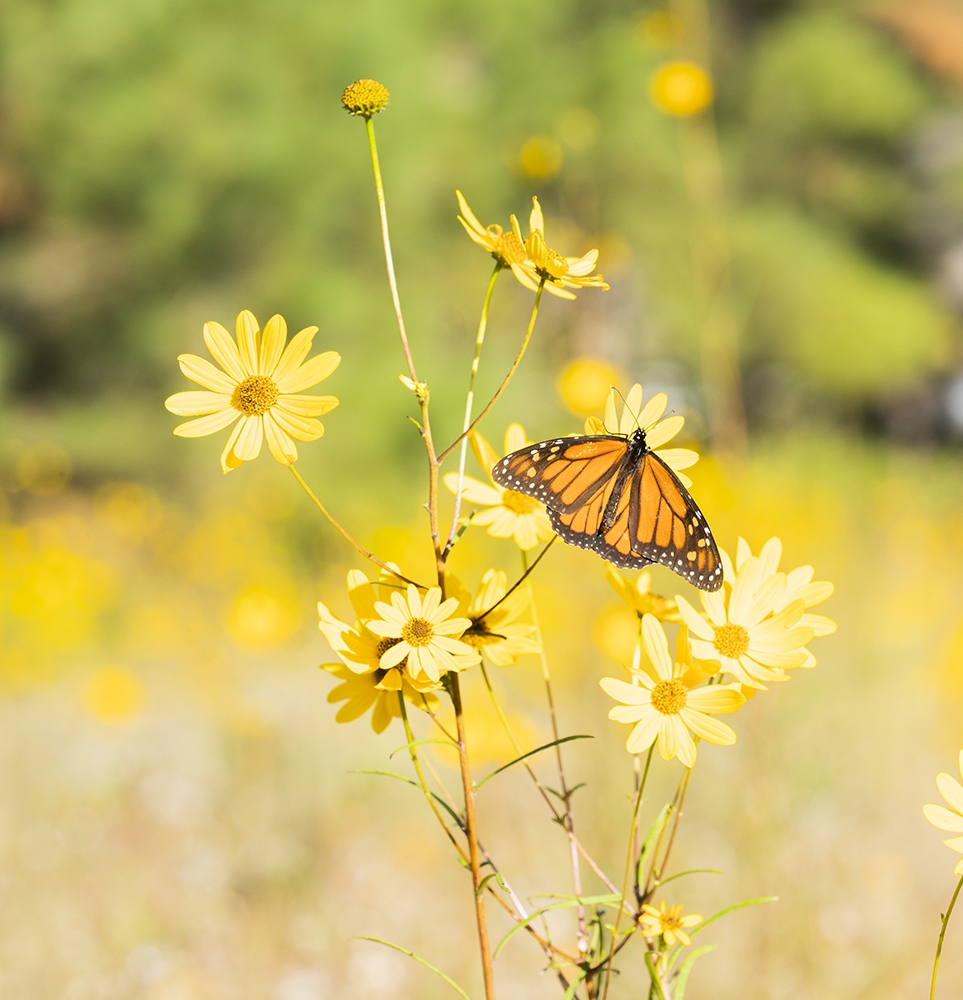
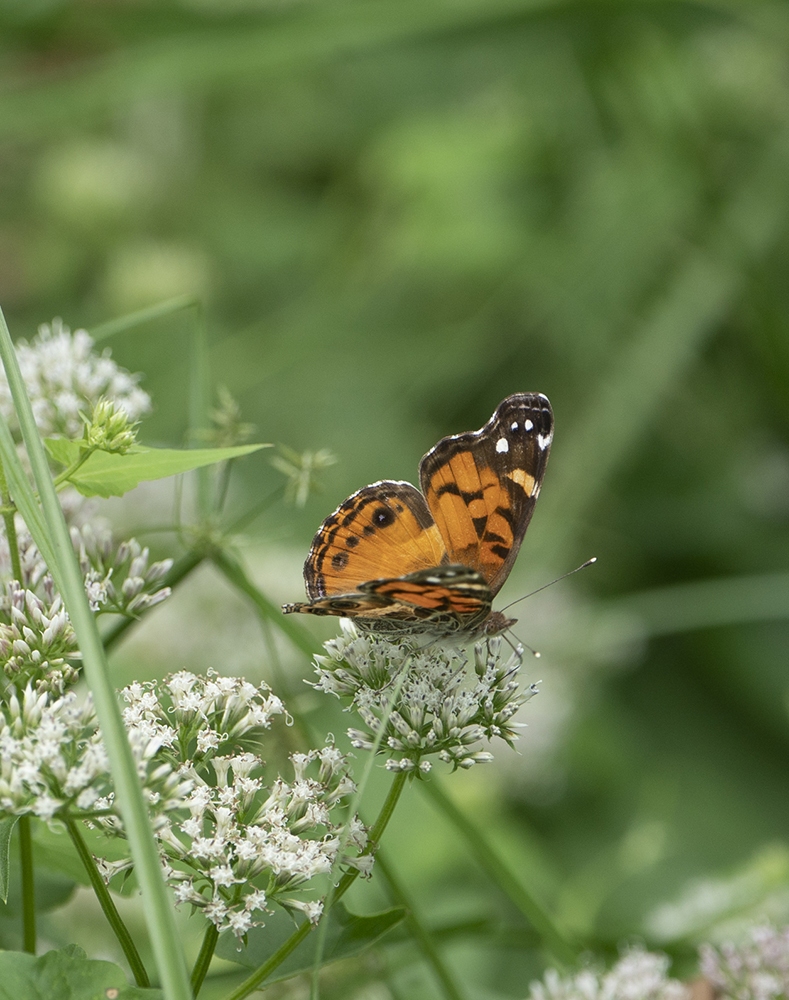
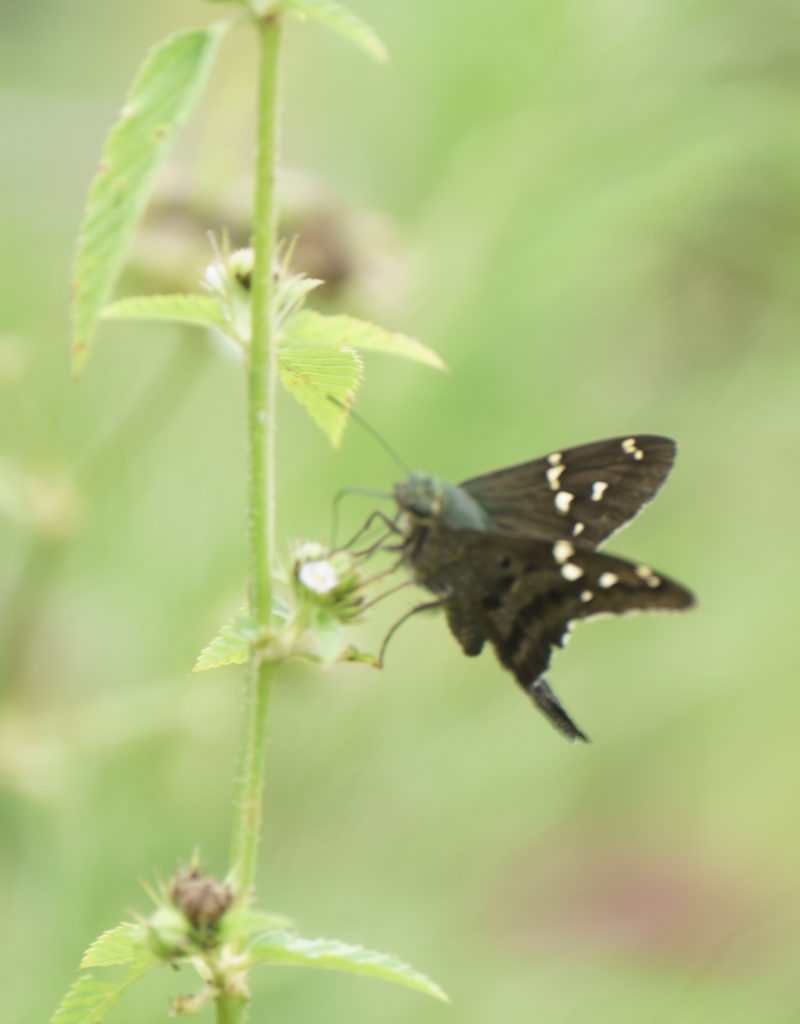
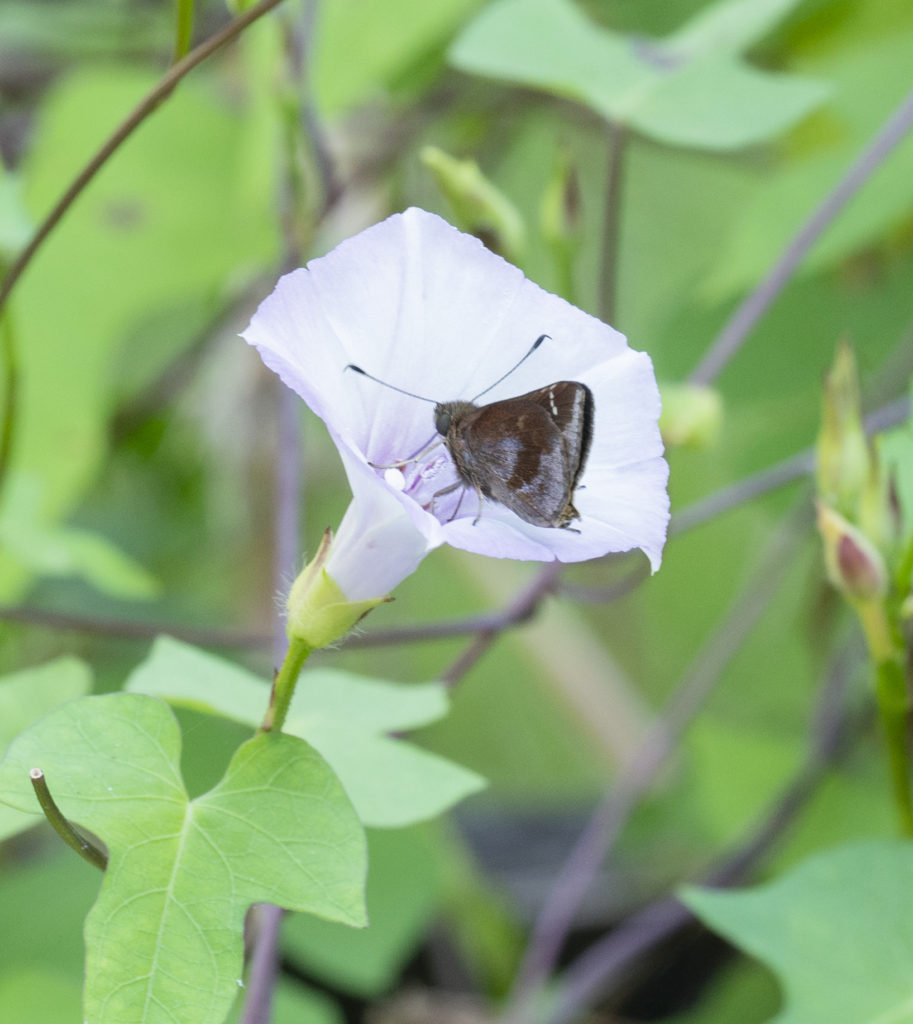
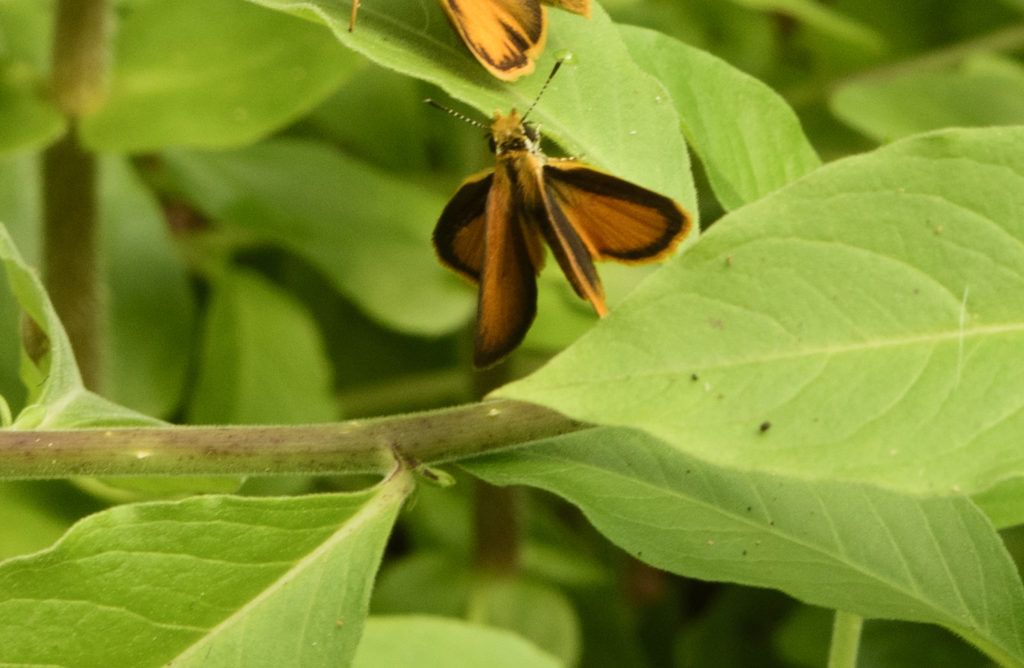
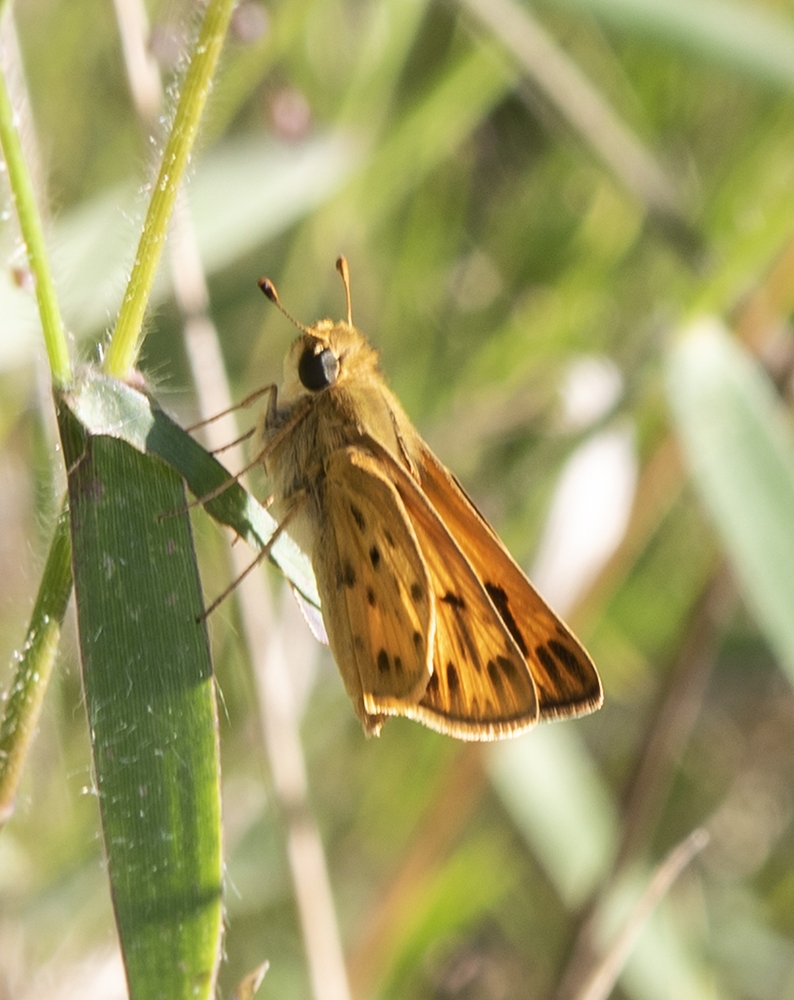
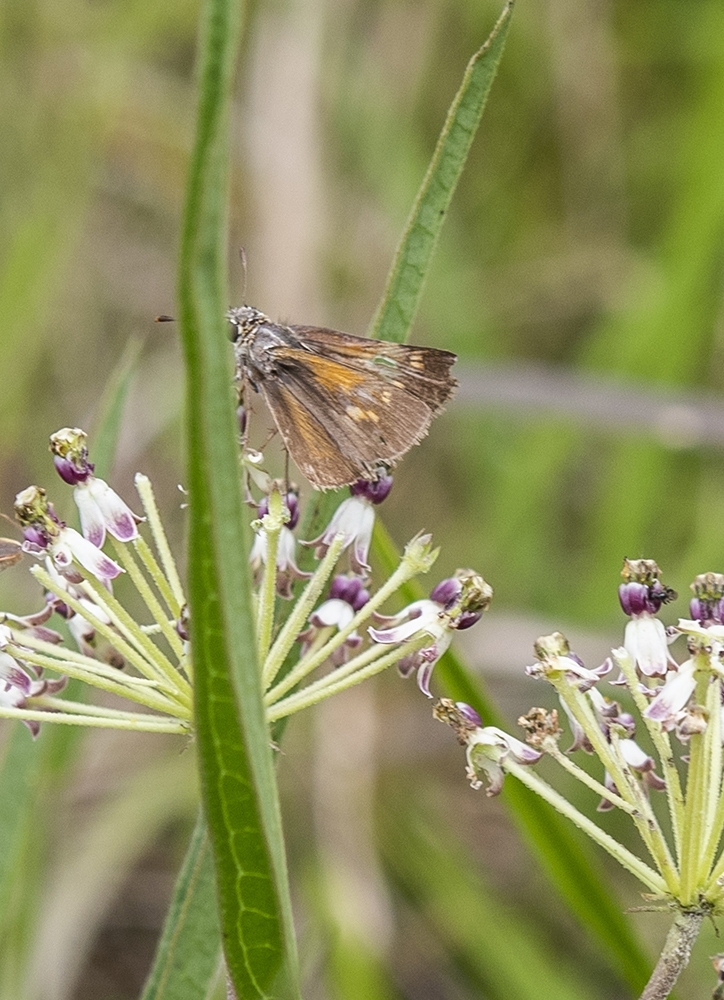
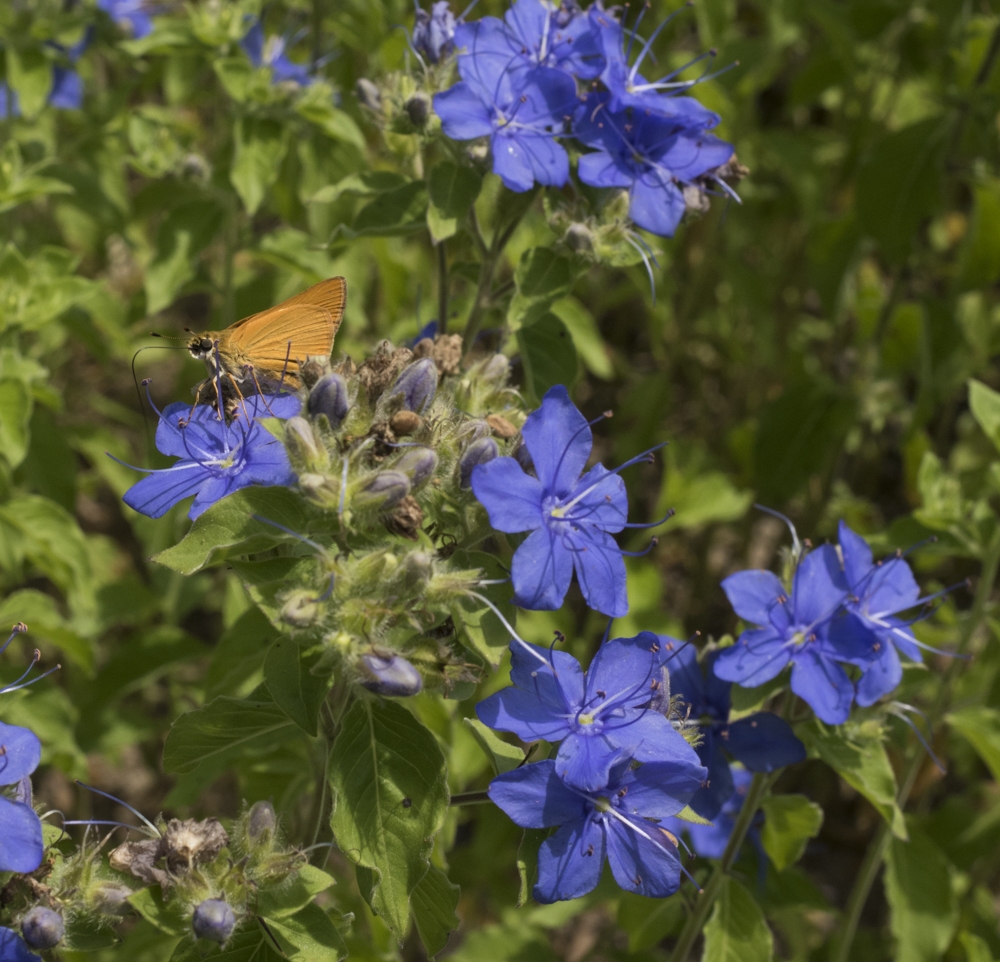
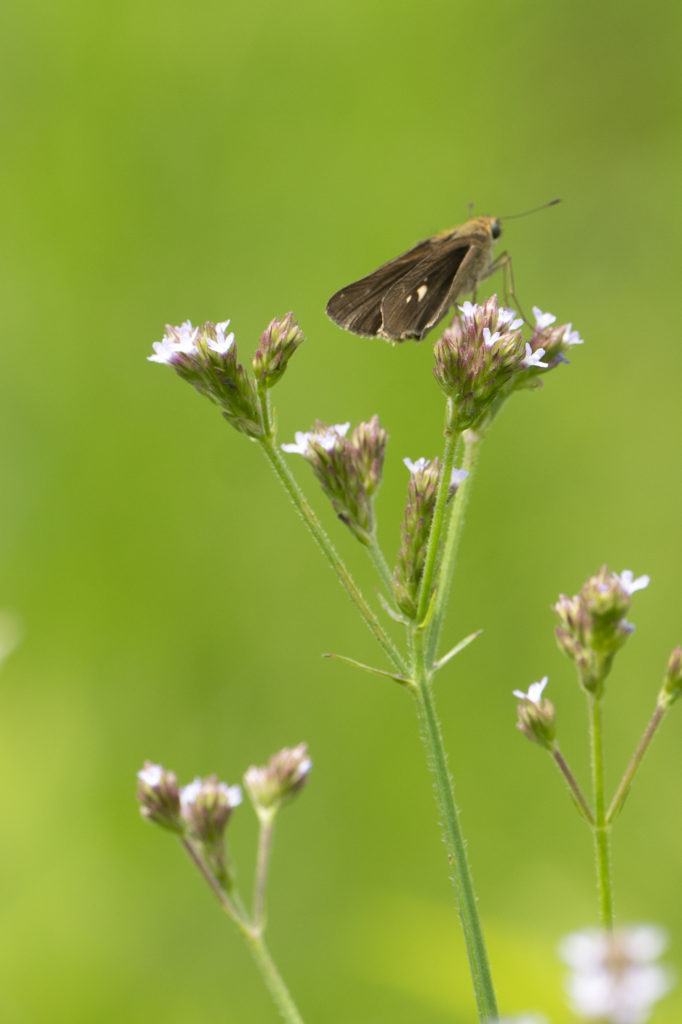
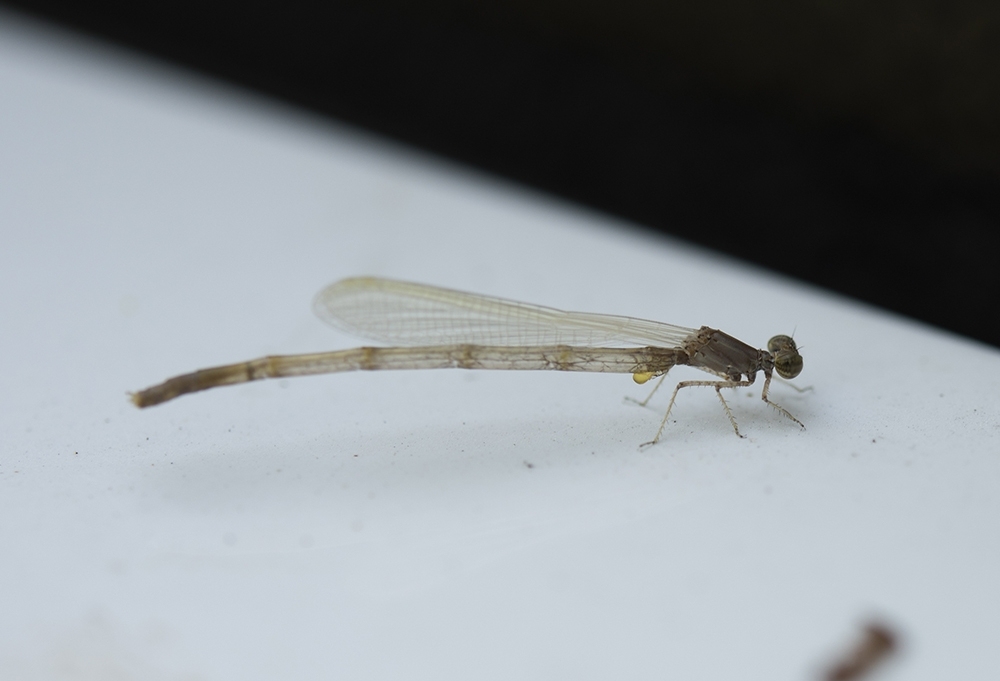
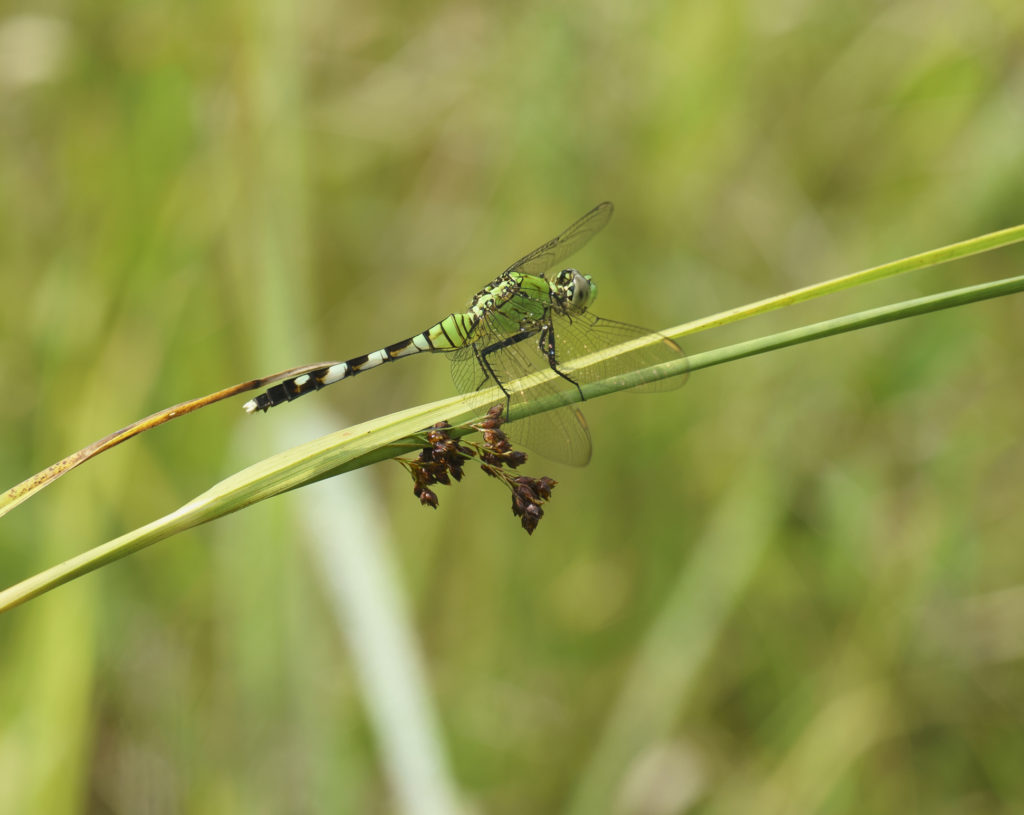
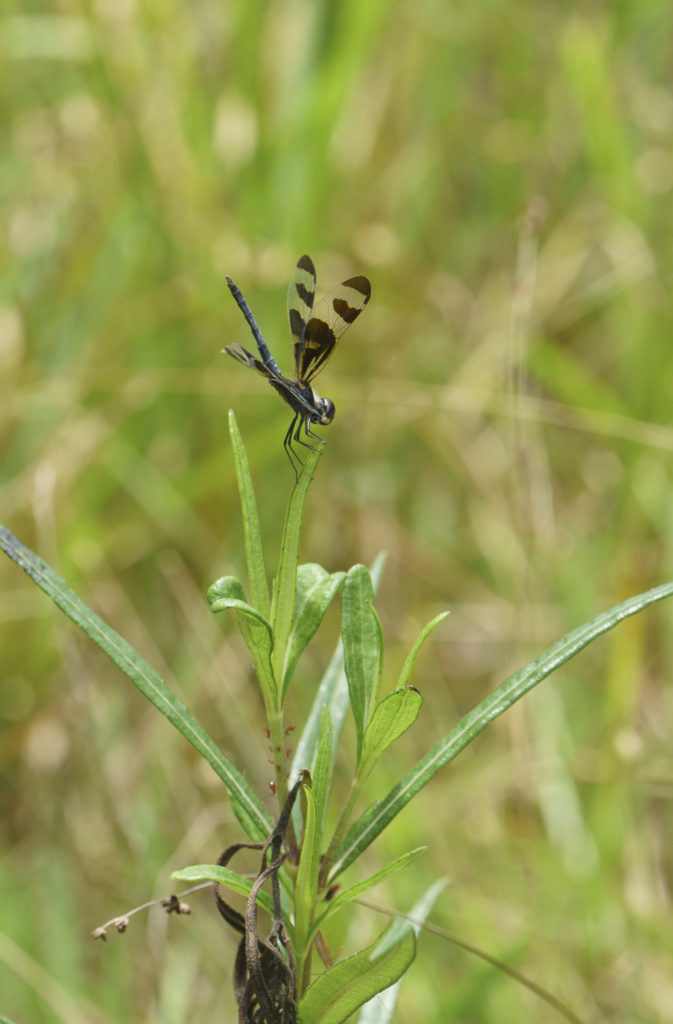
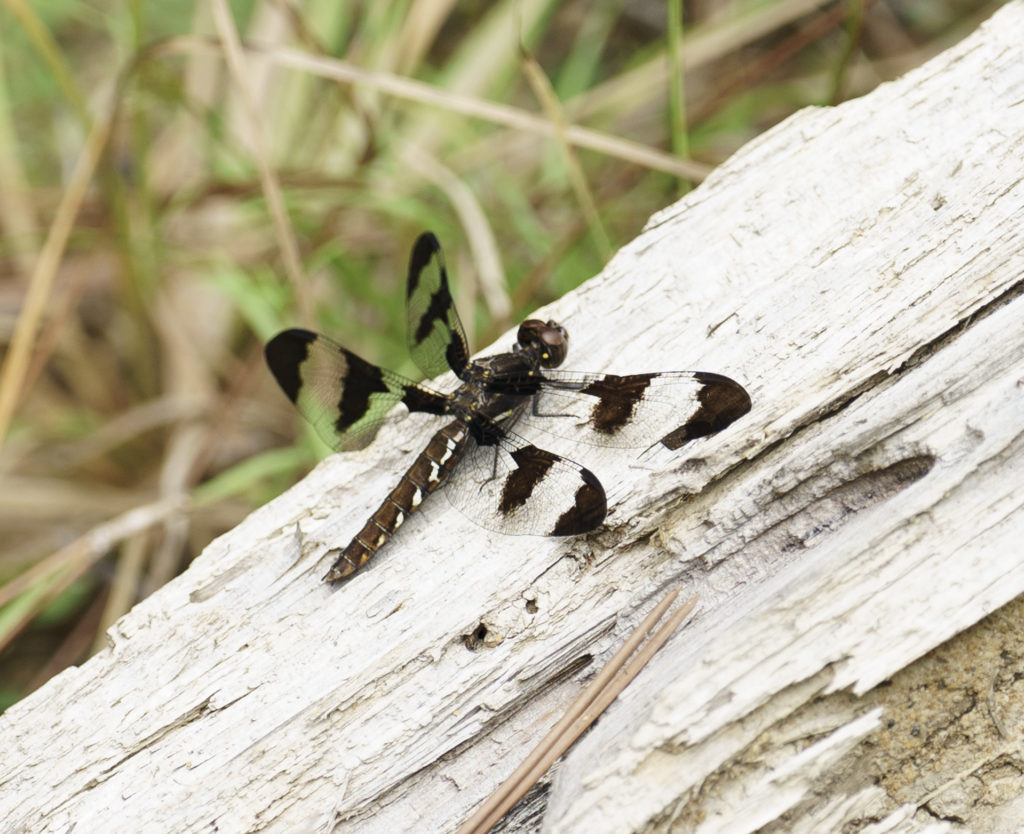
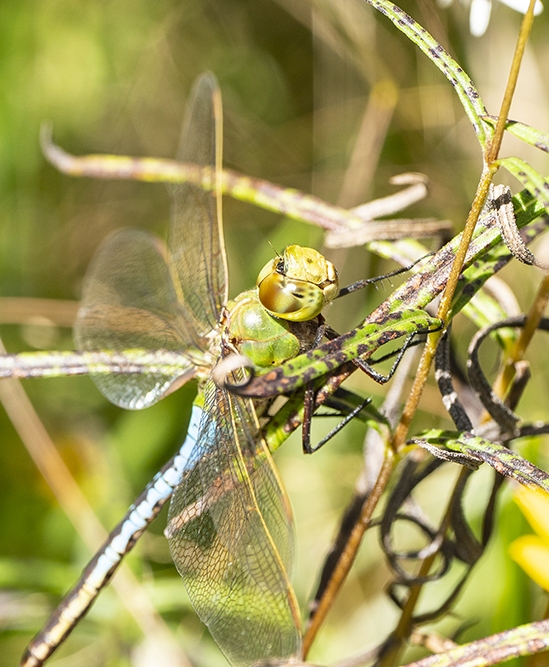
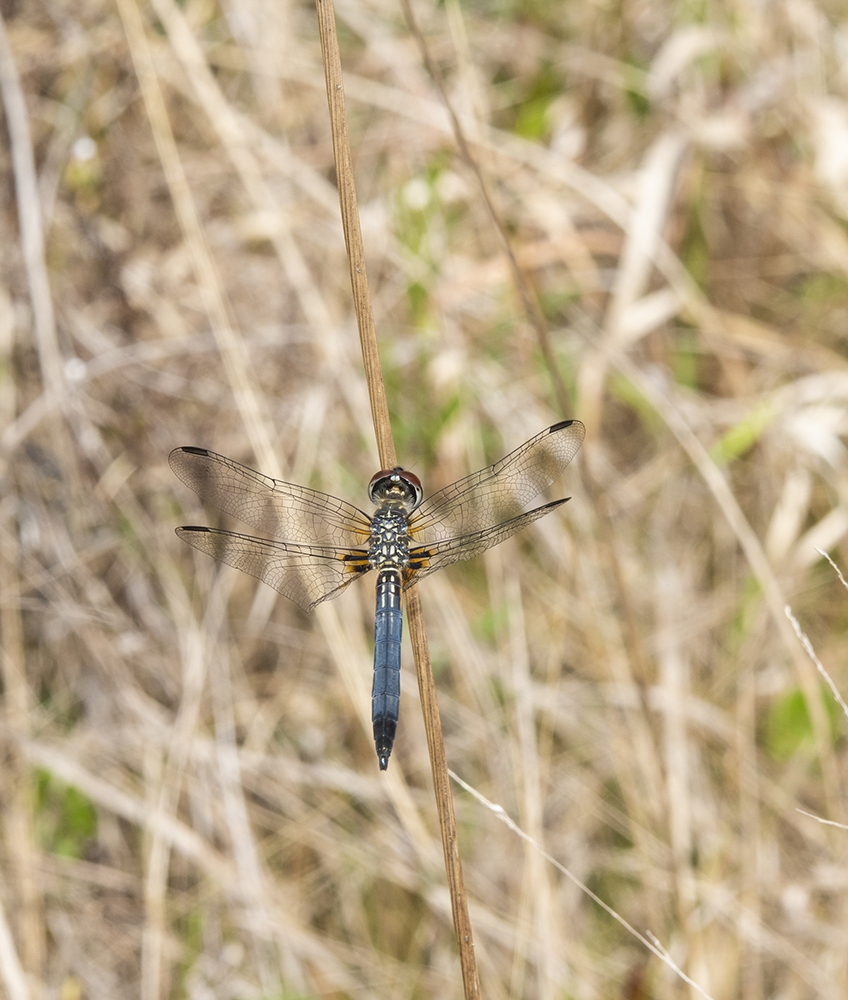
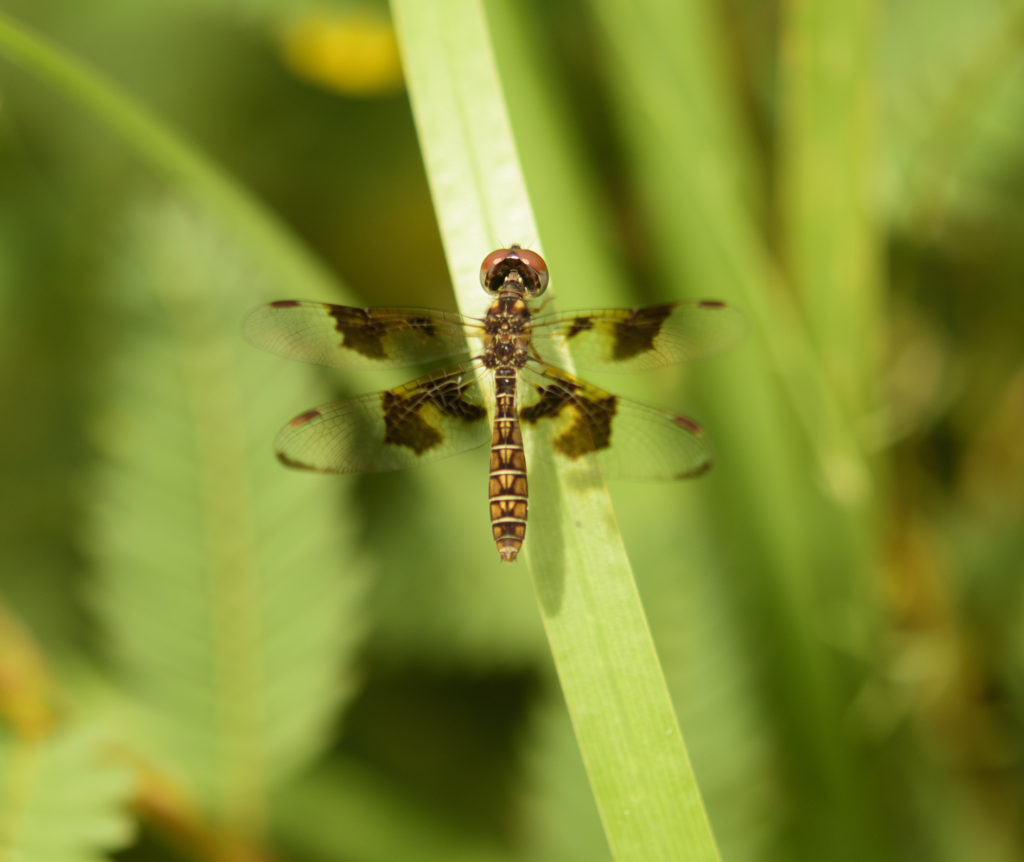
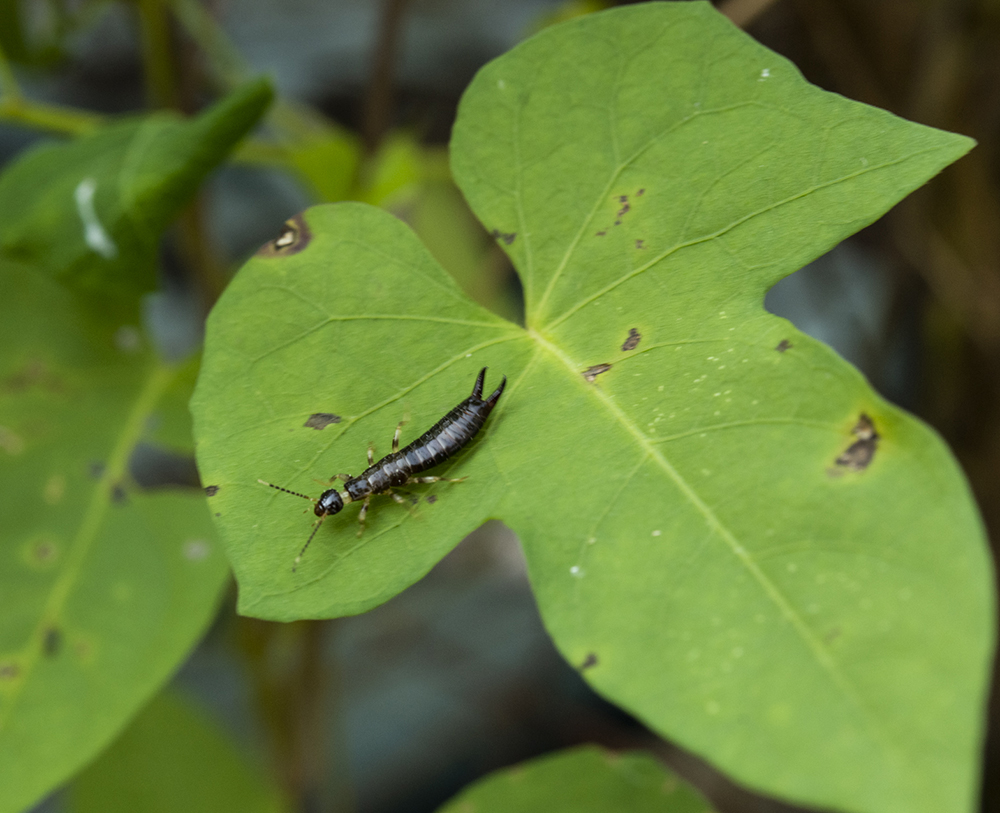

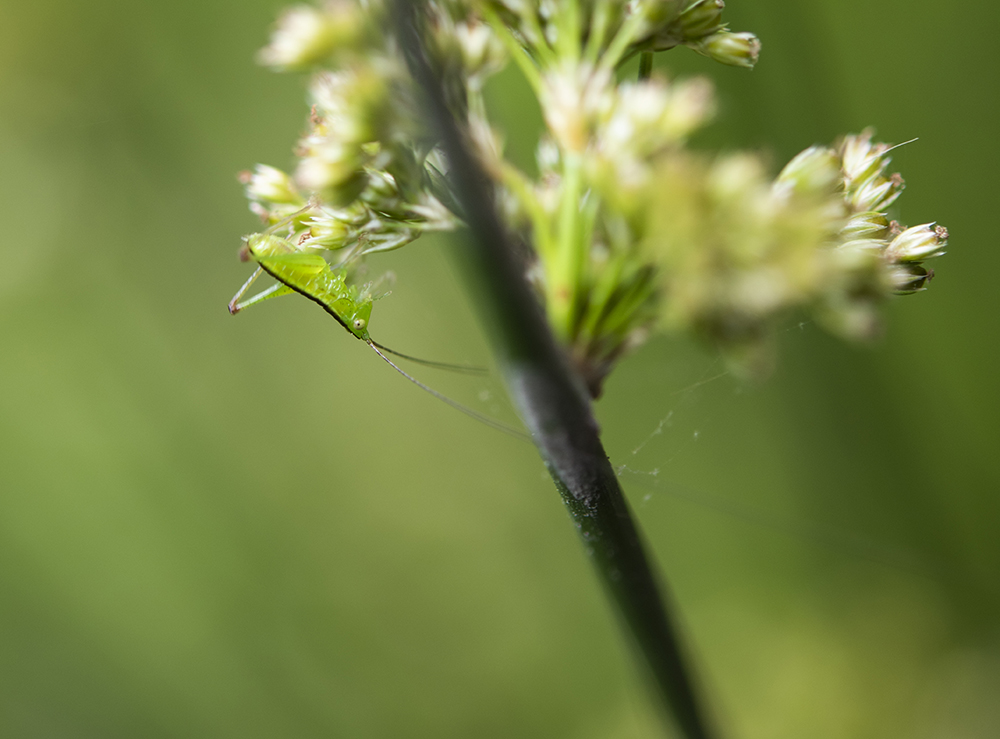
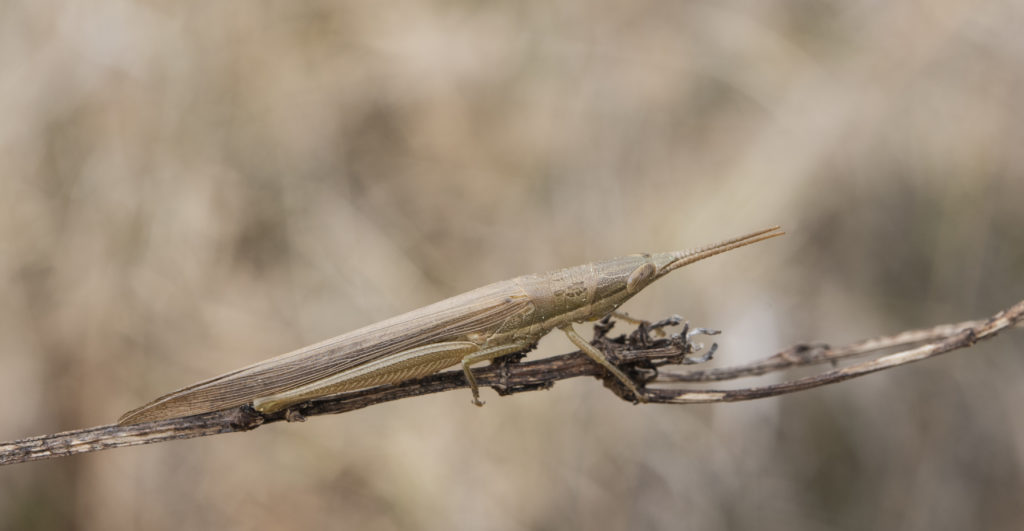
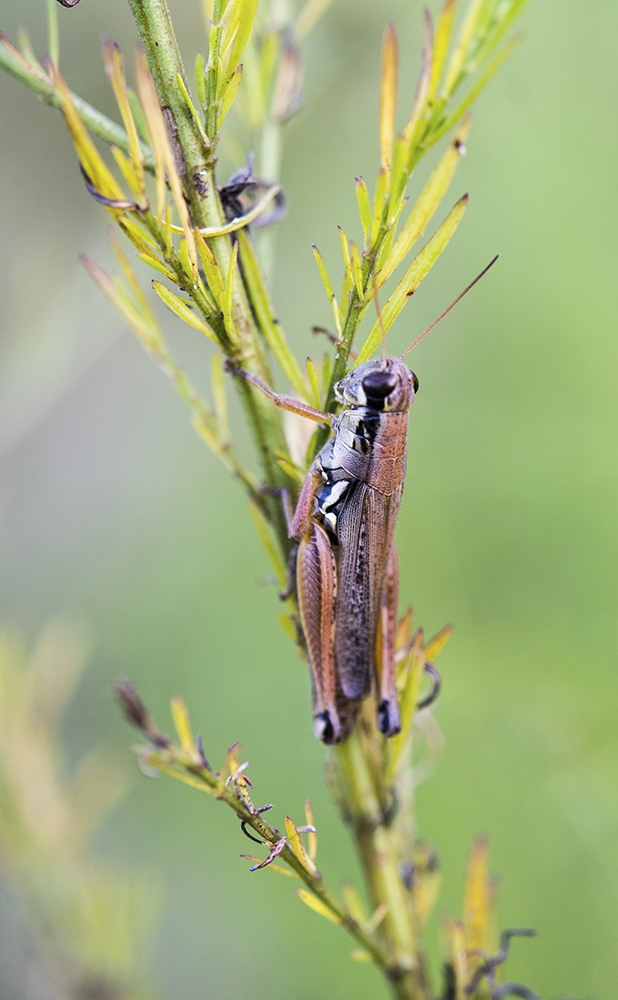
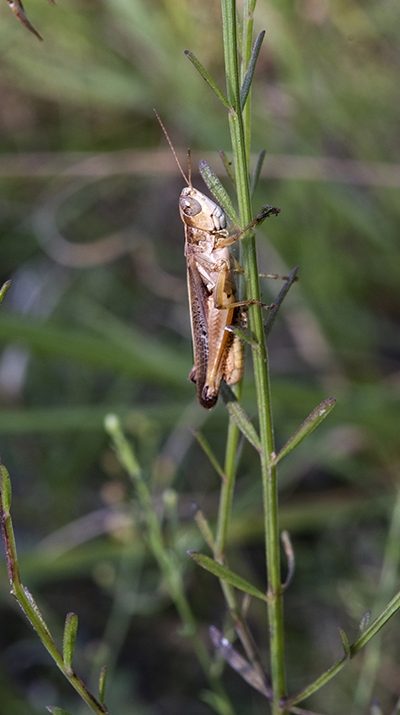
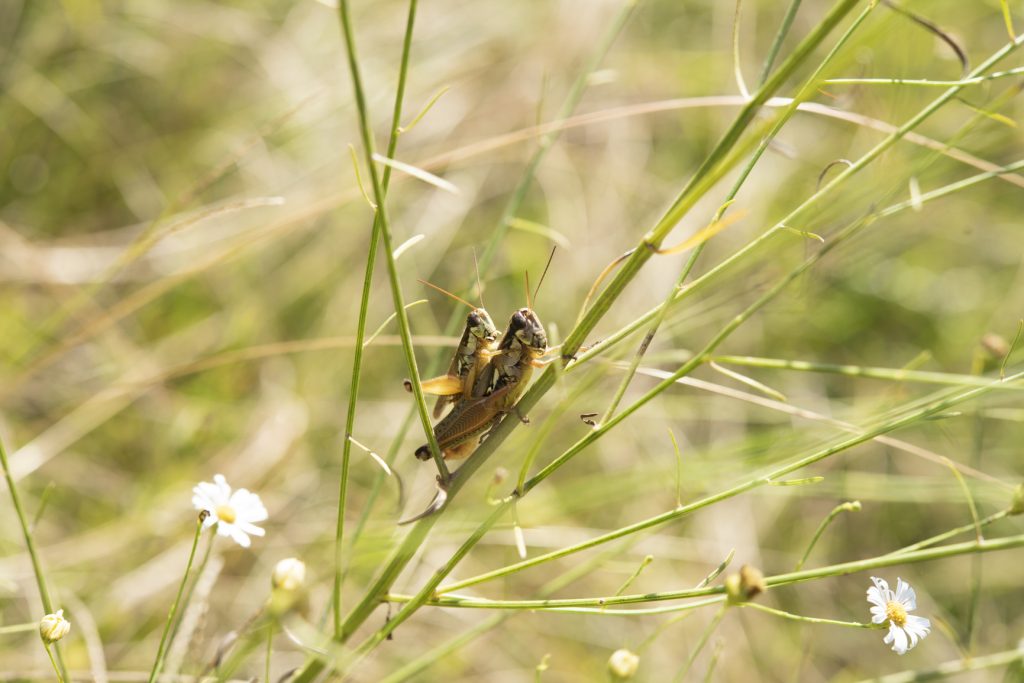
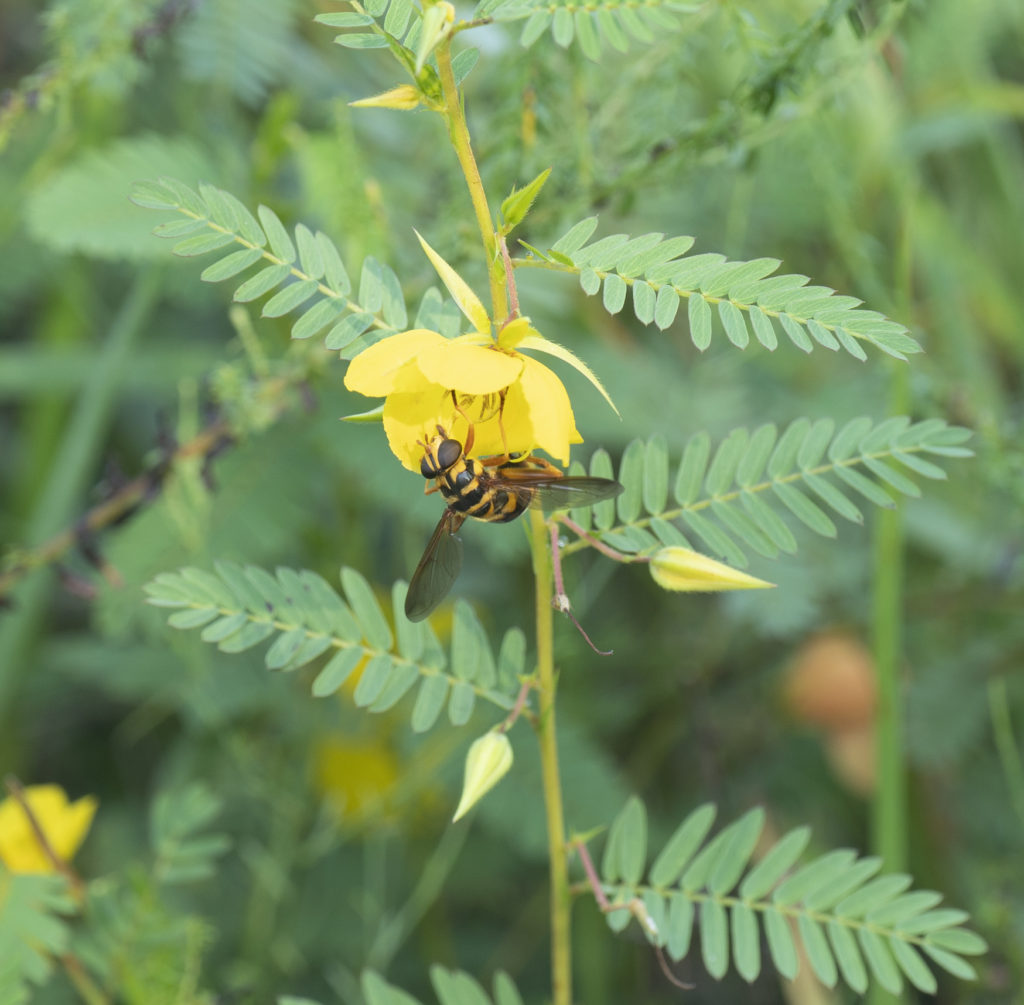







Recent Comments